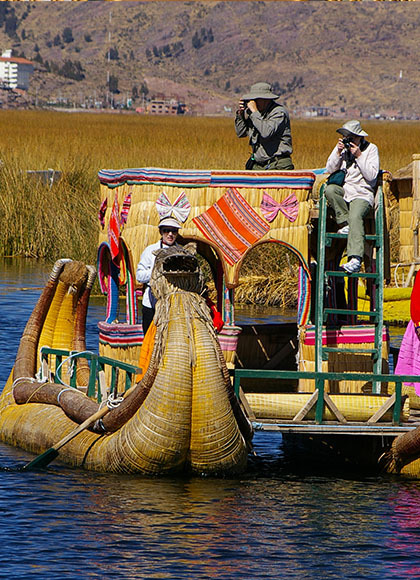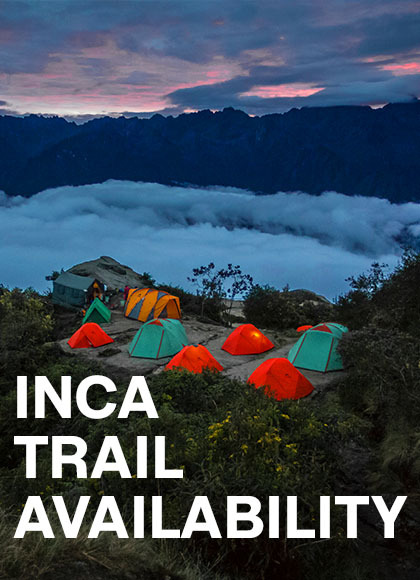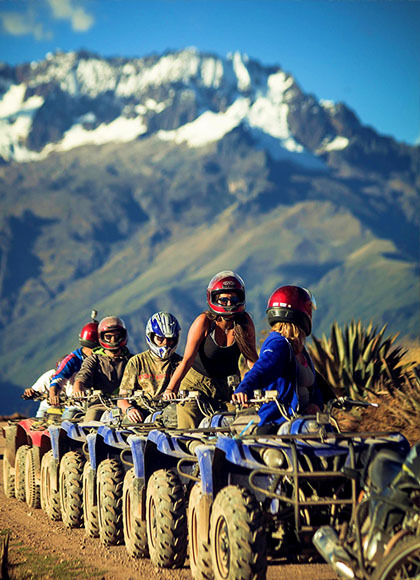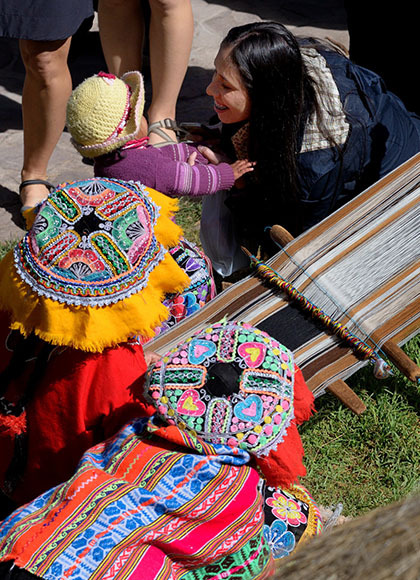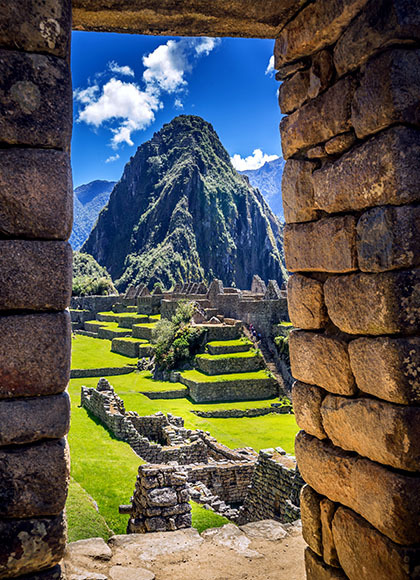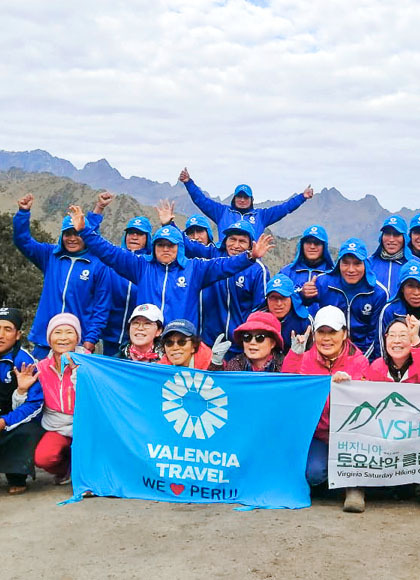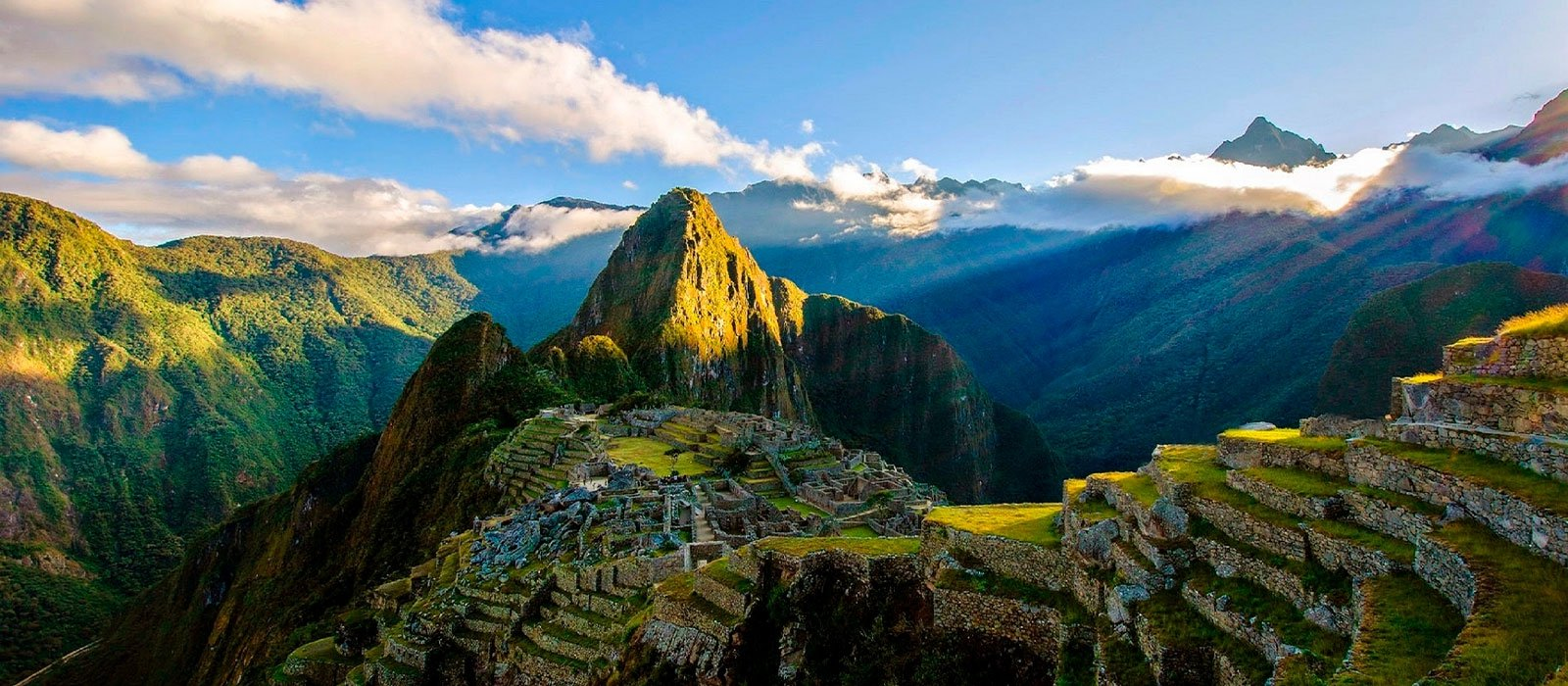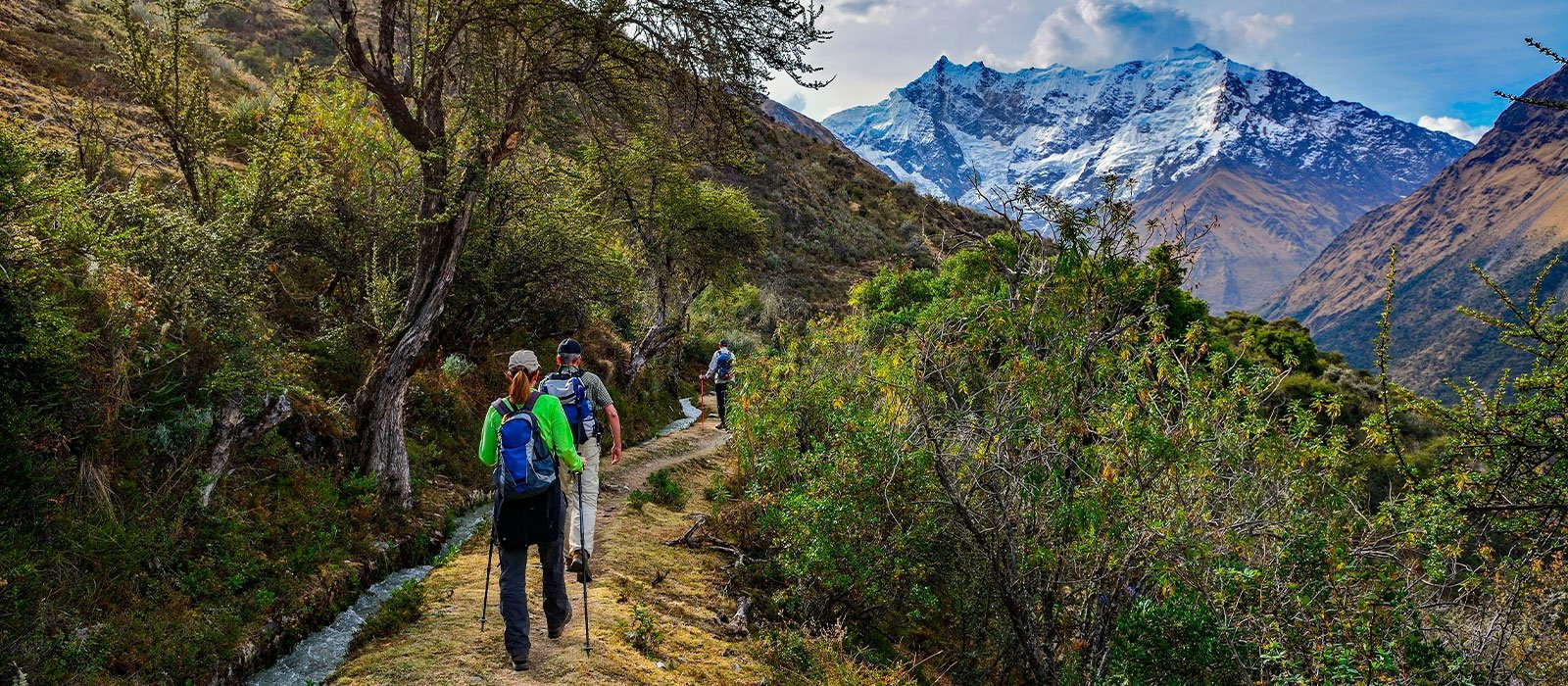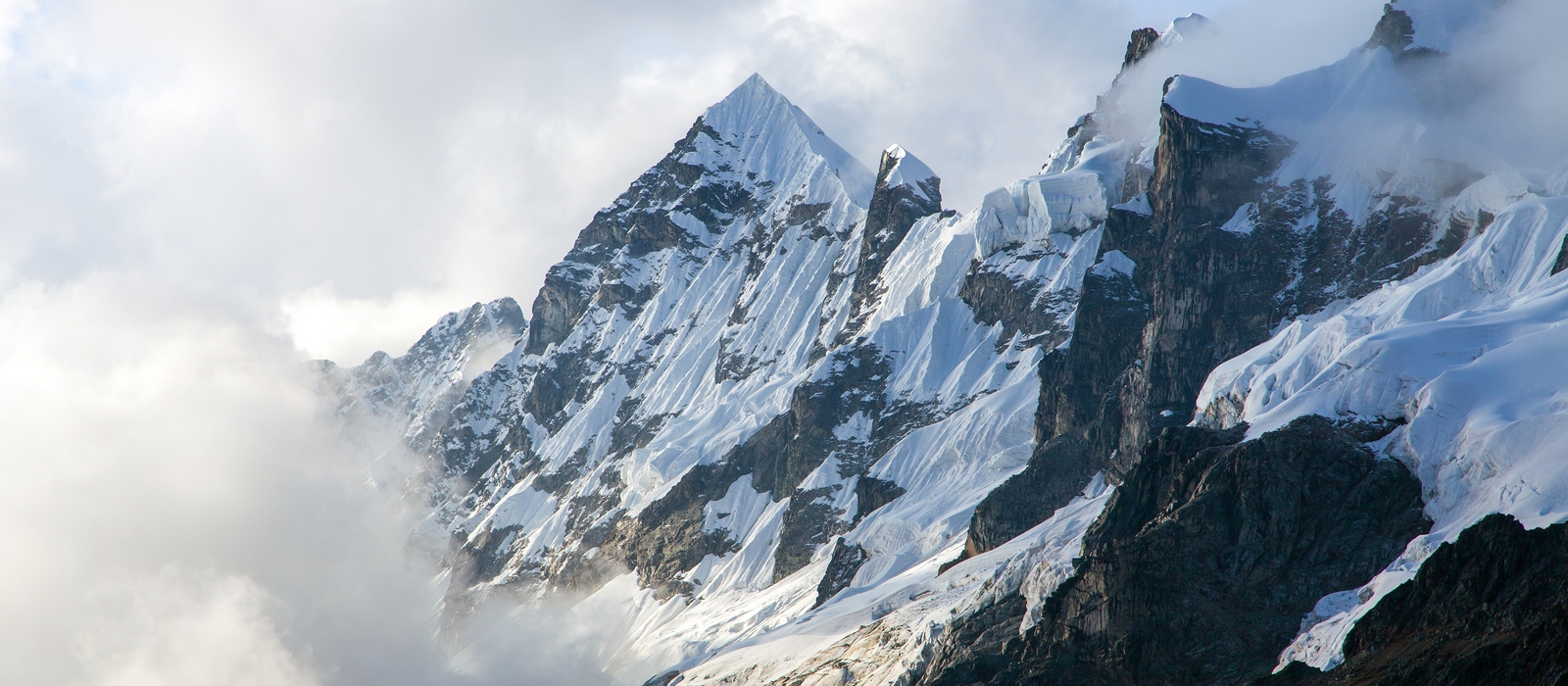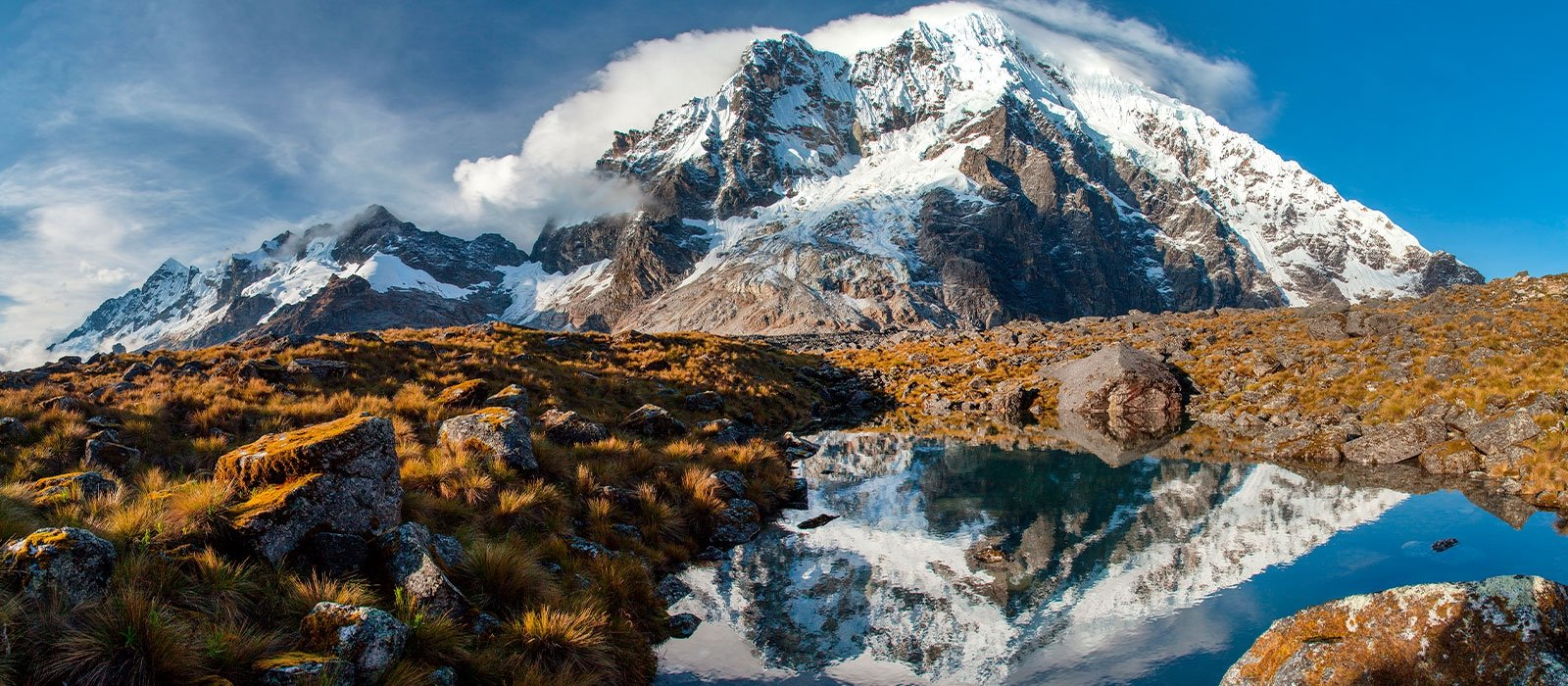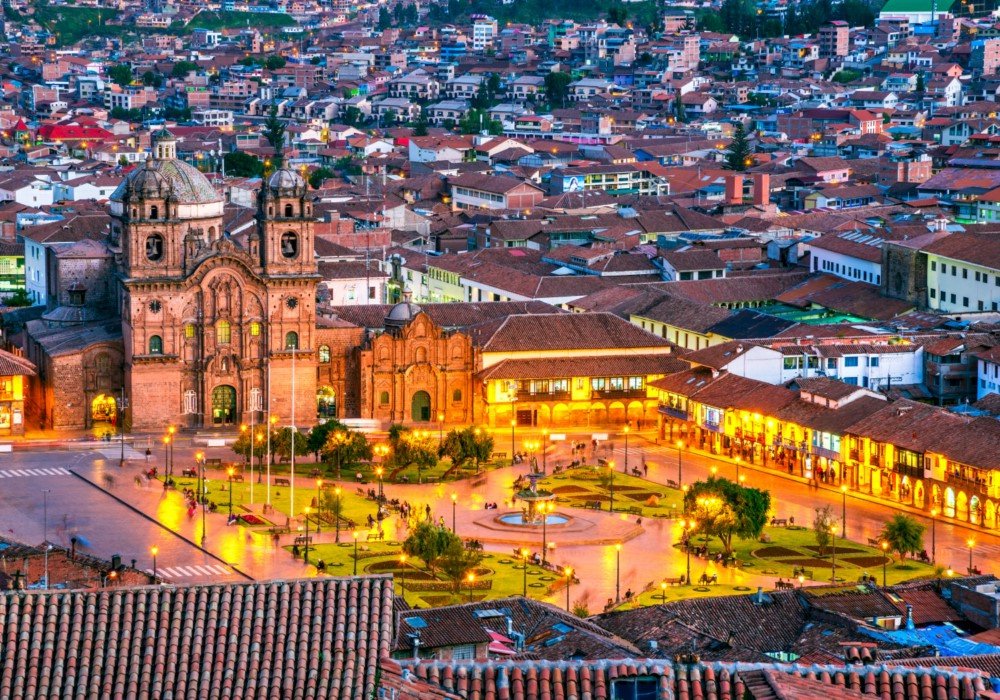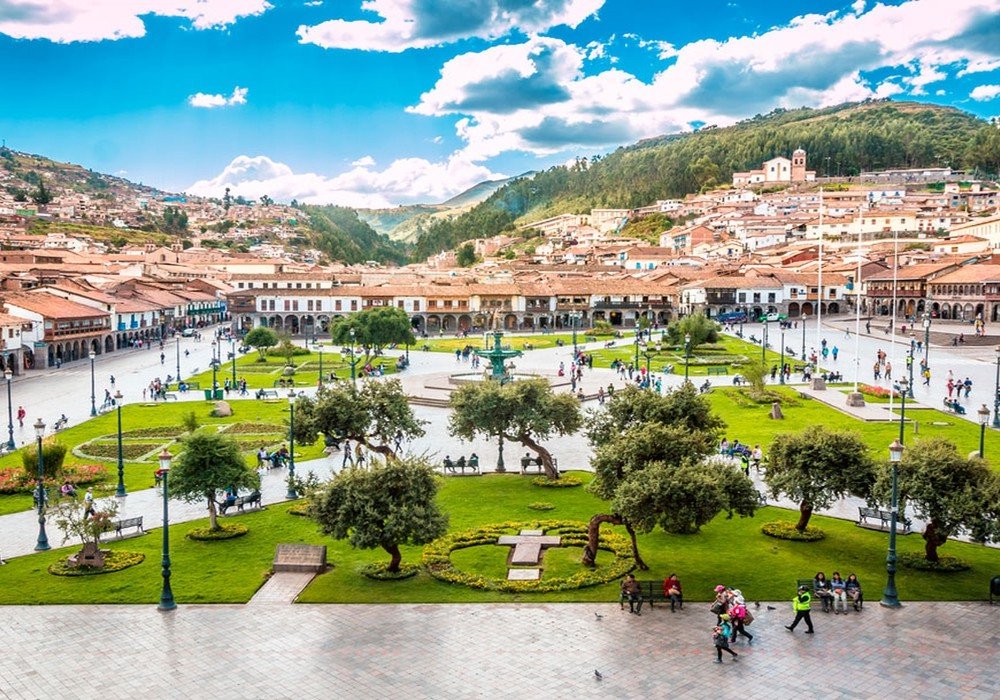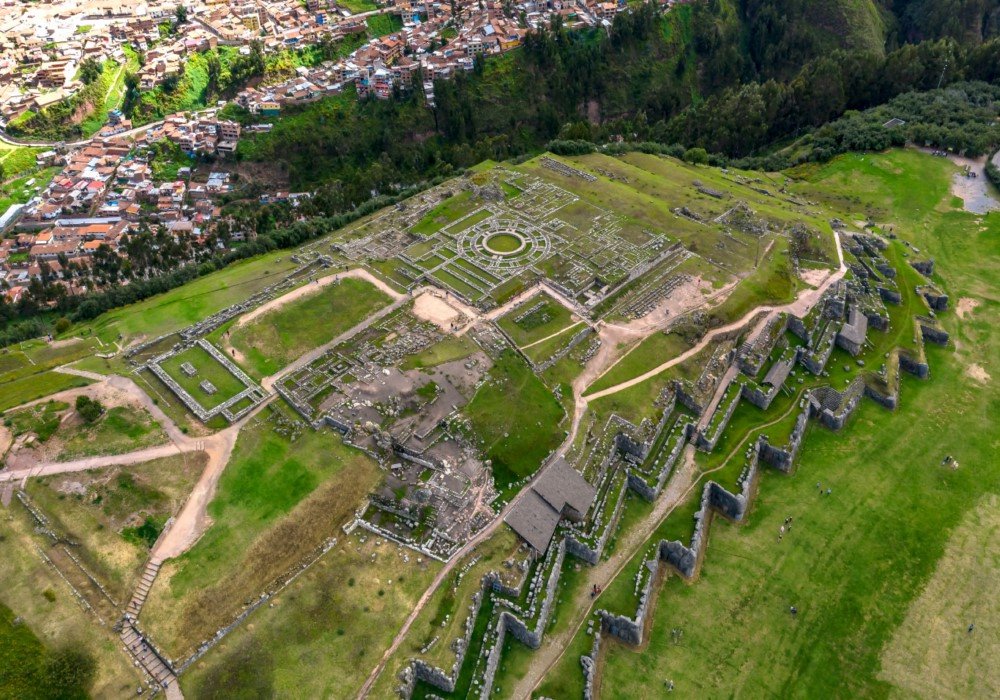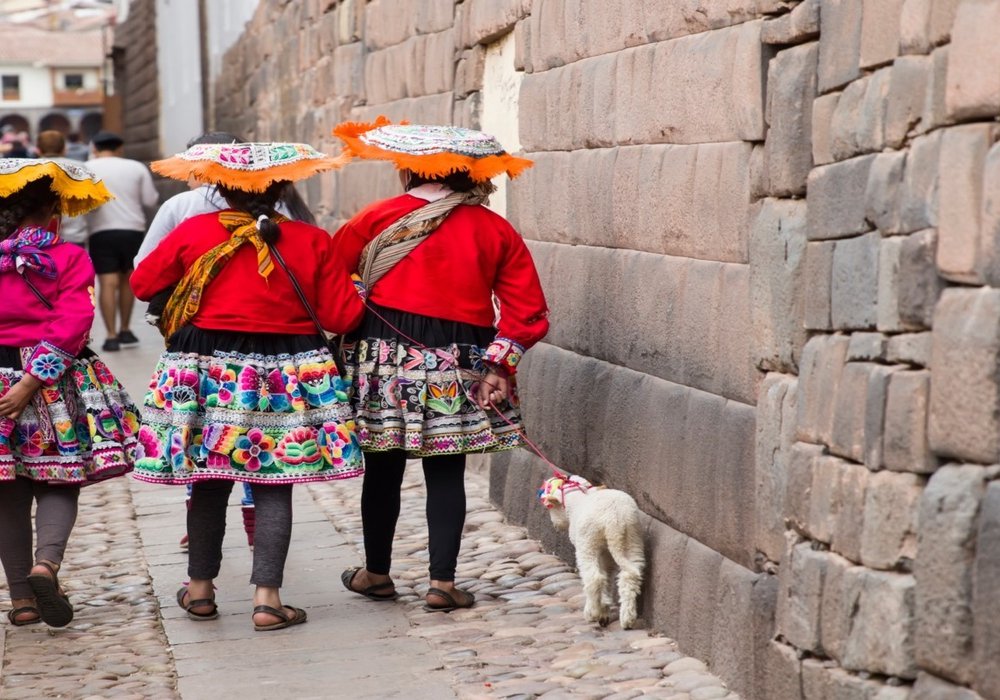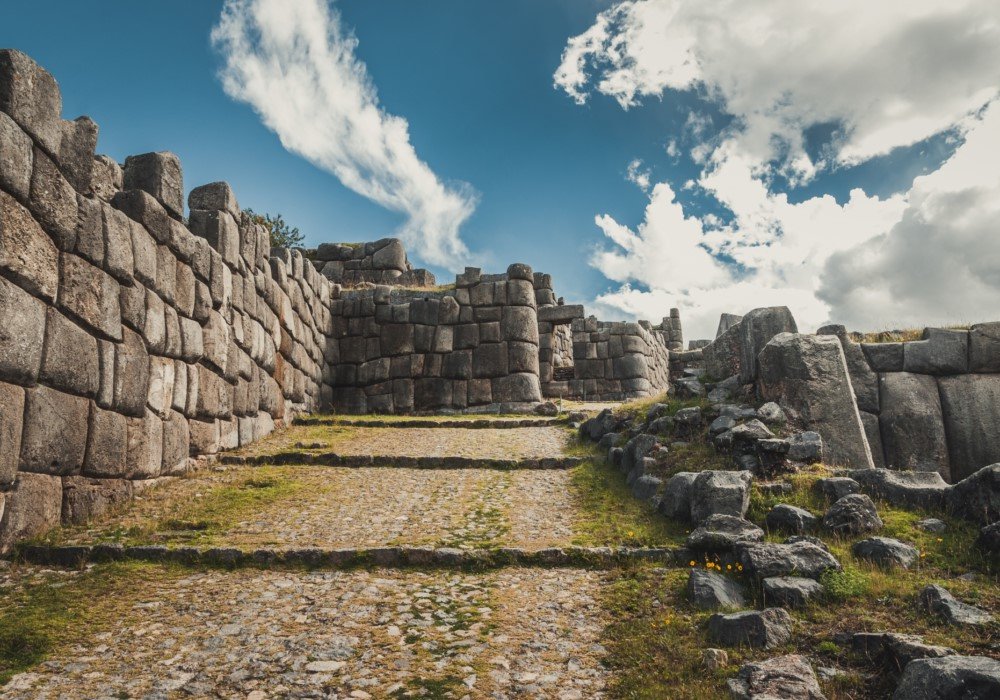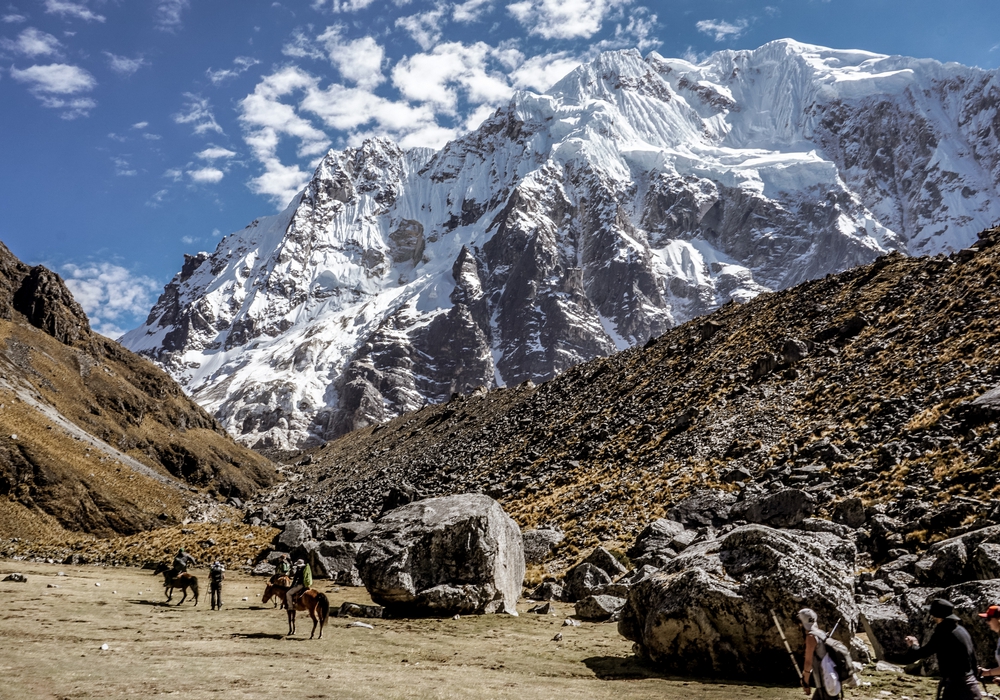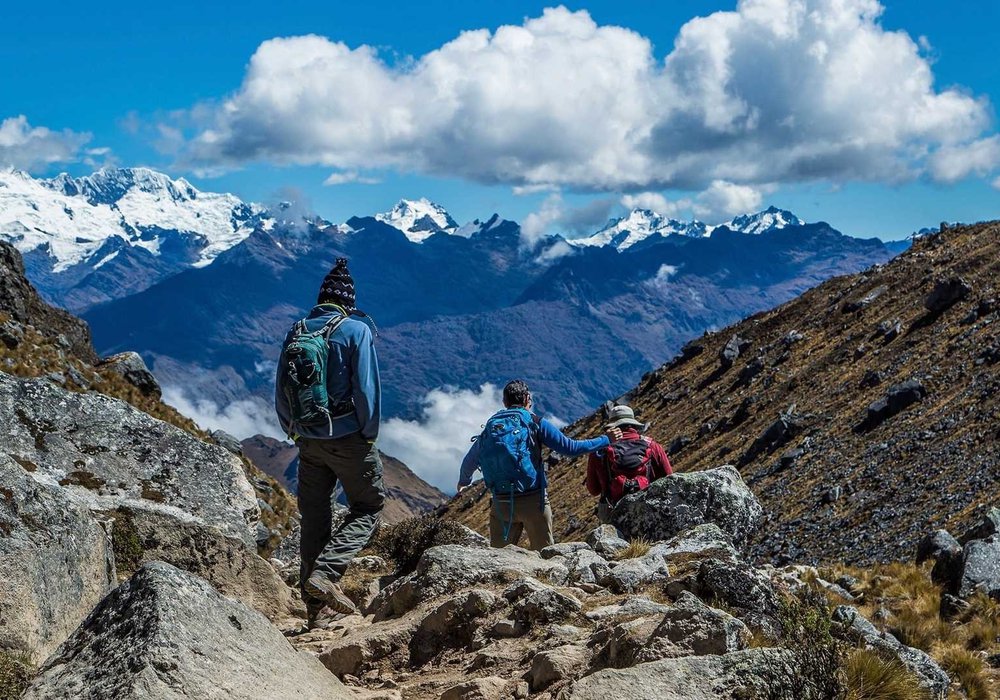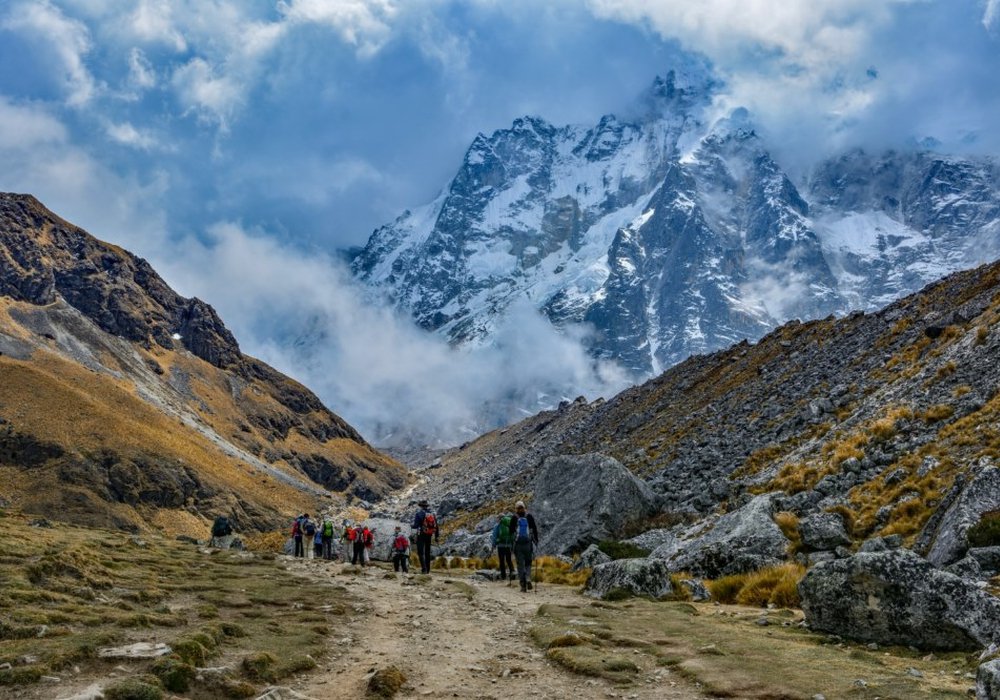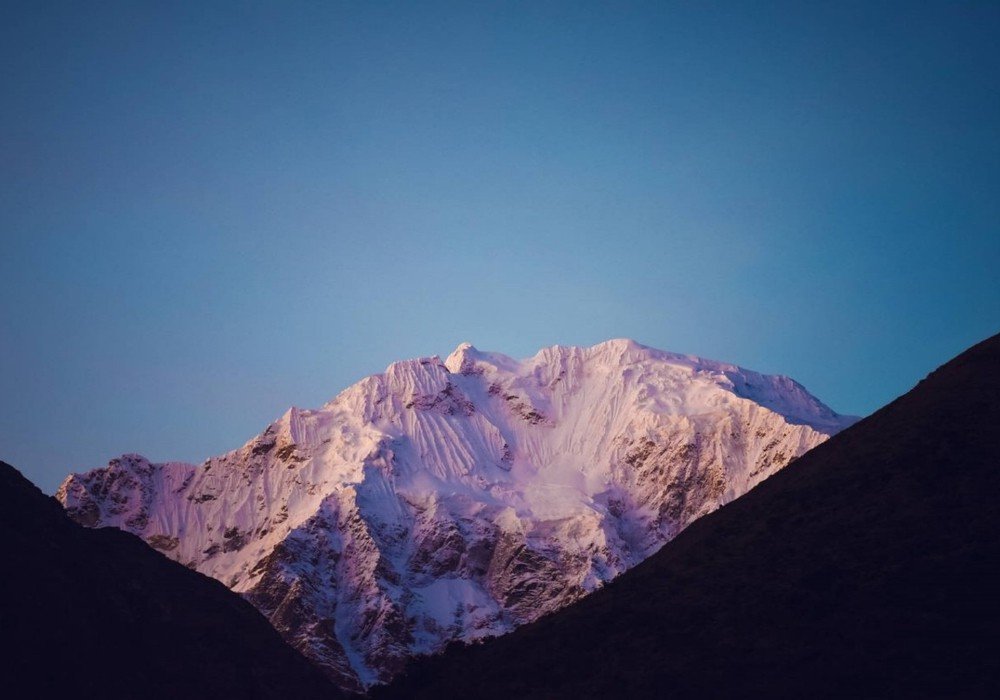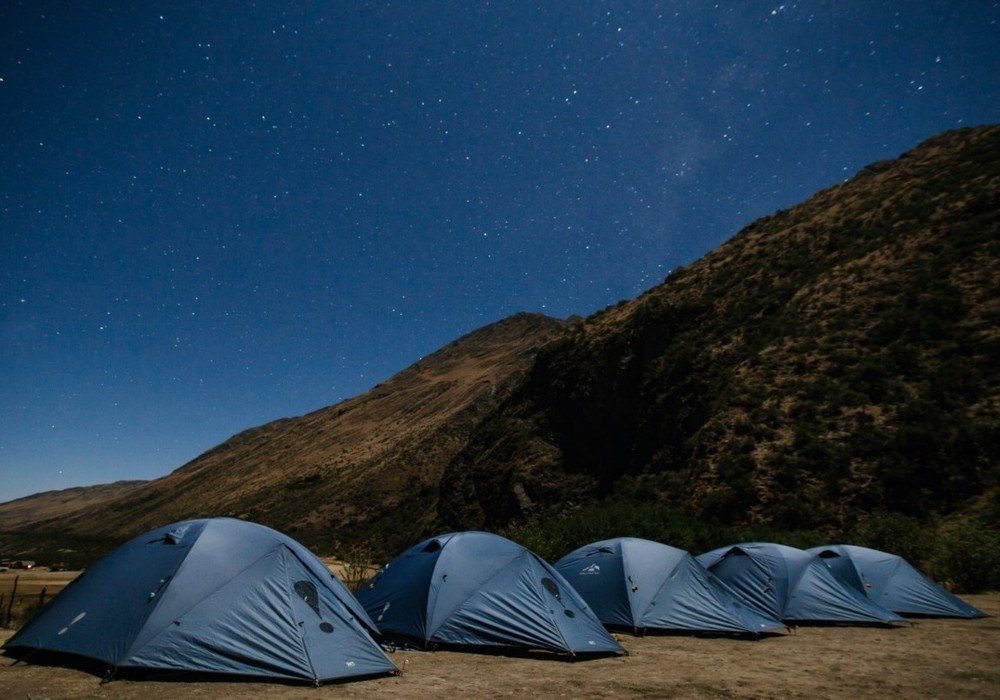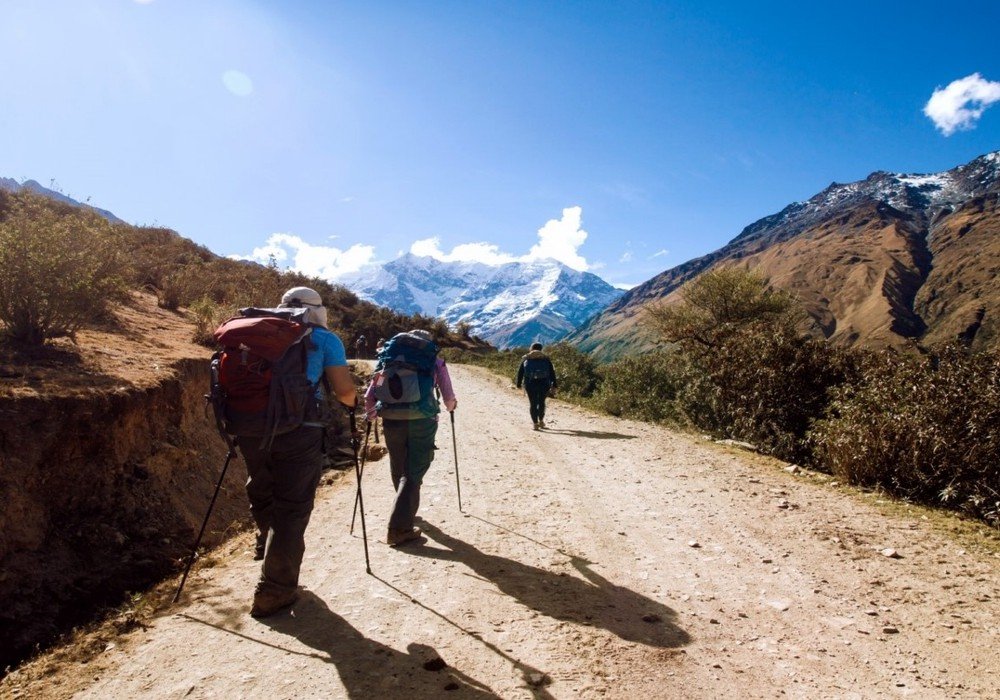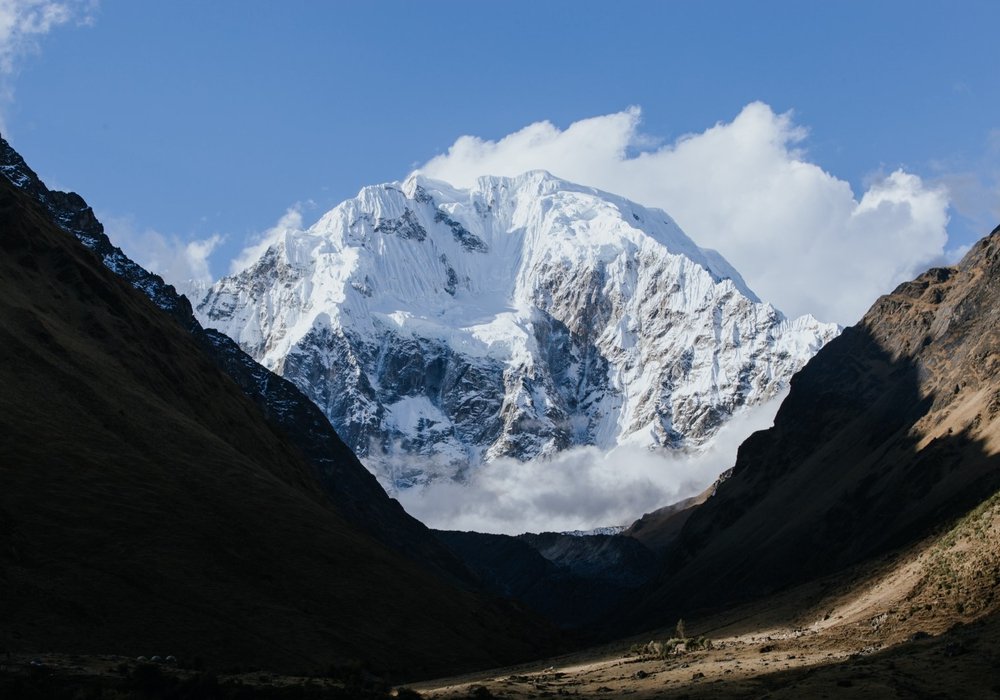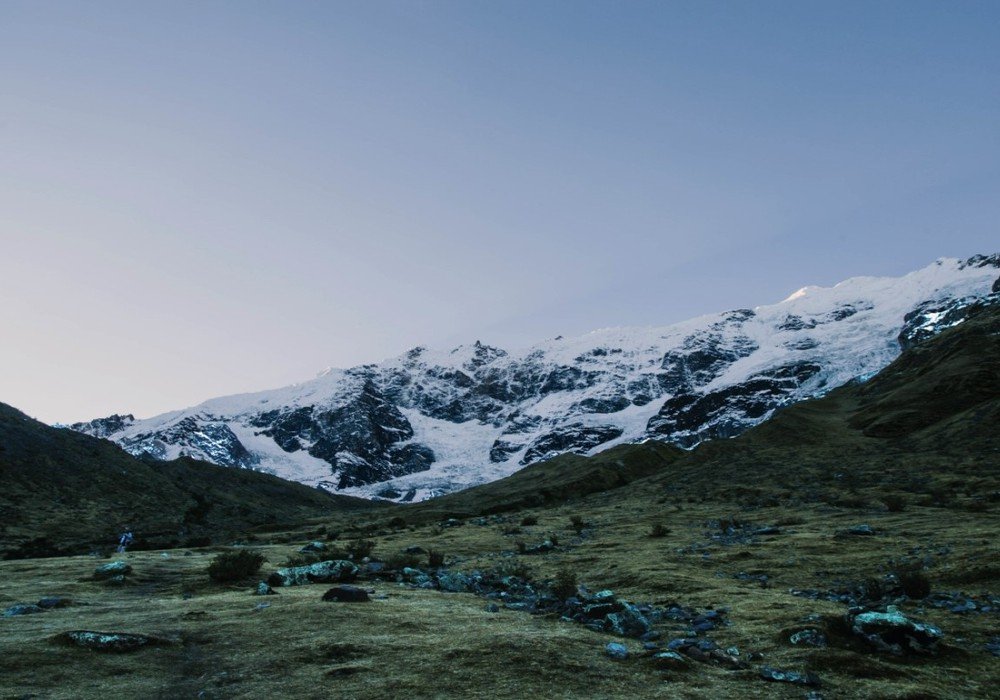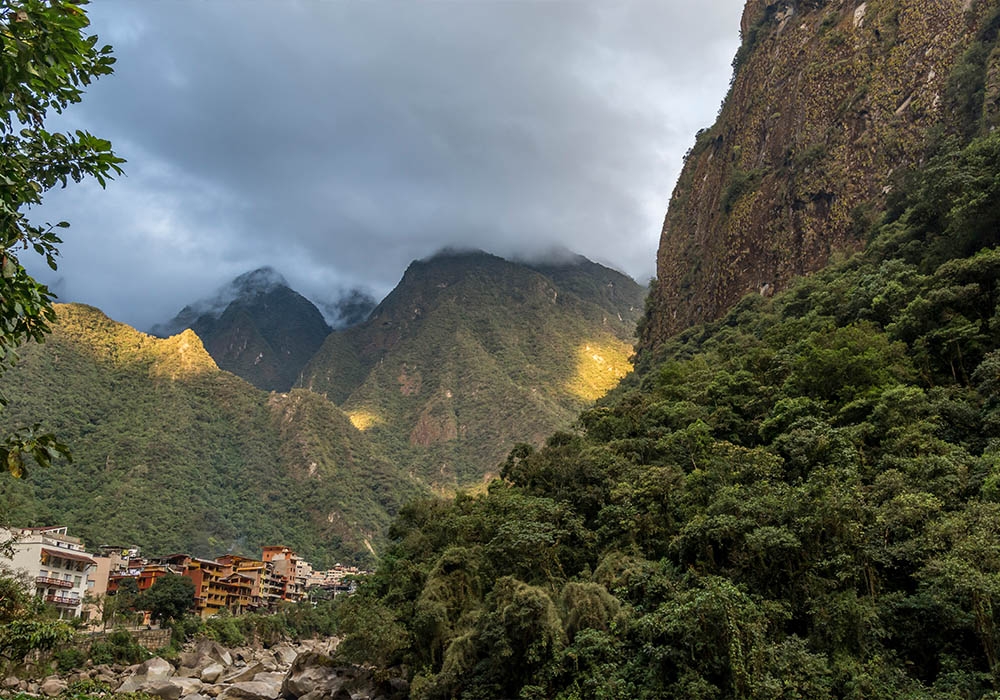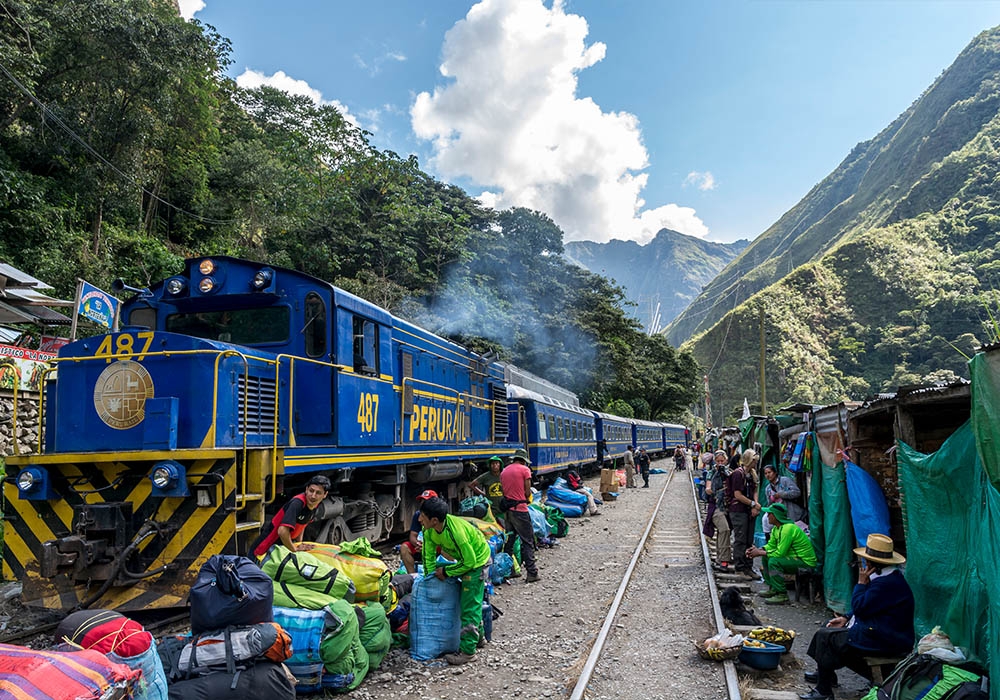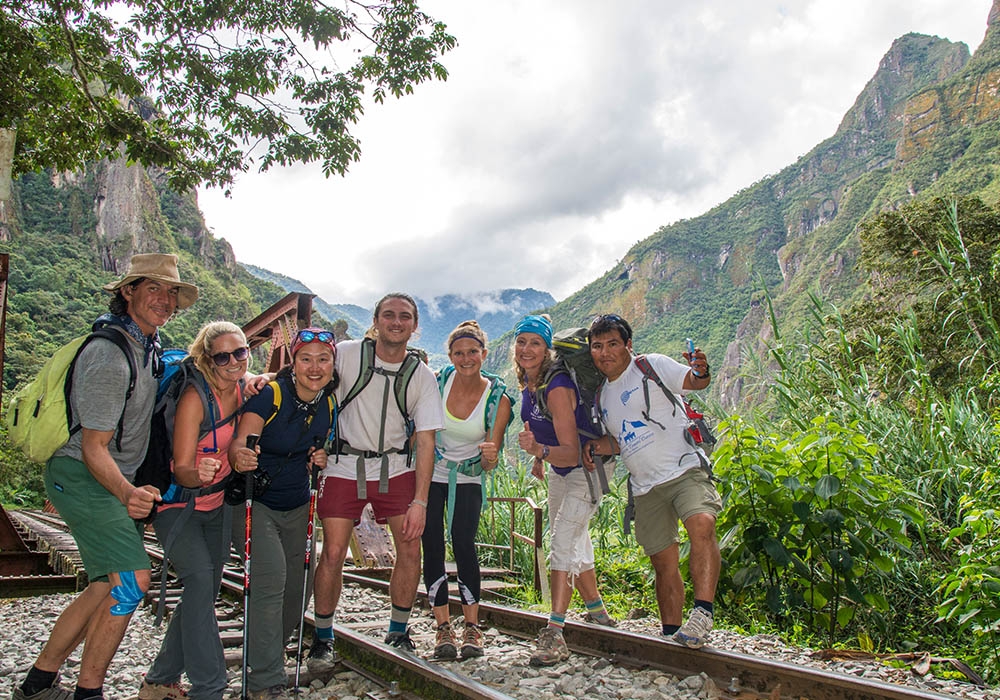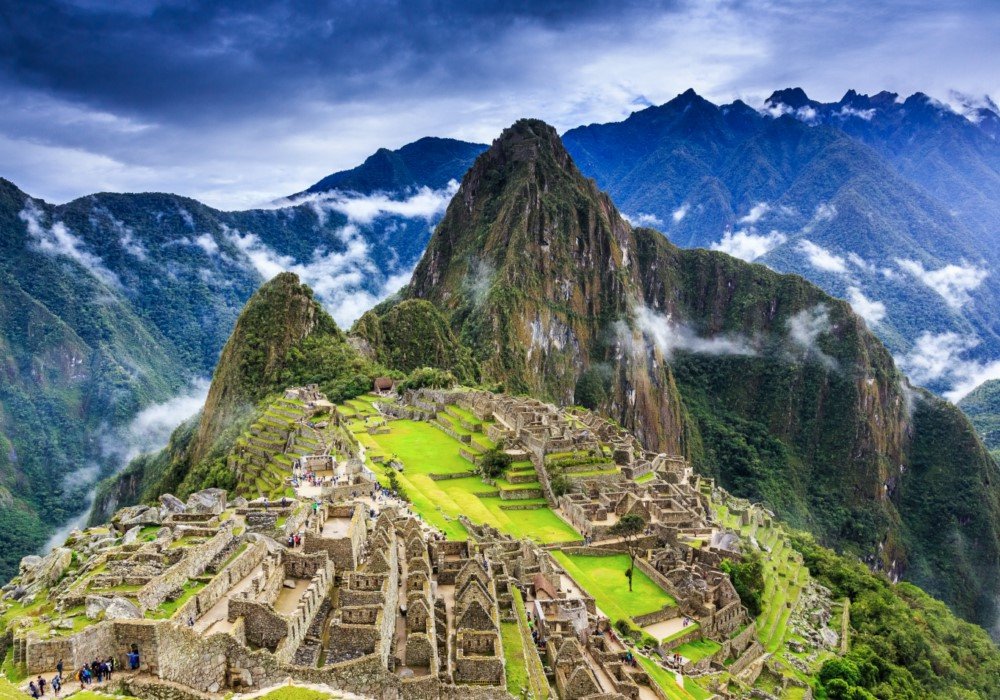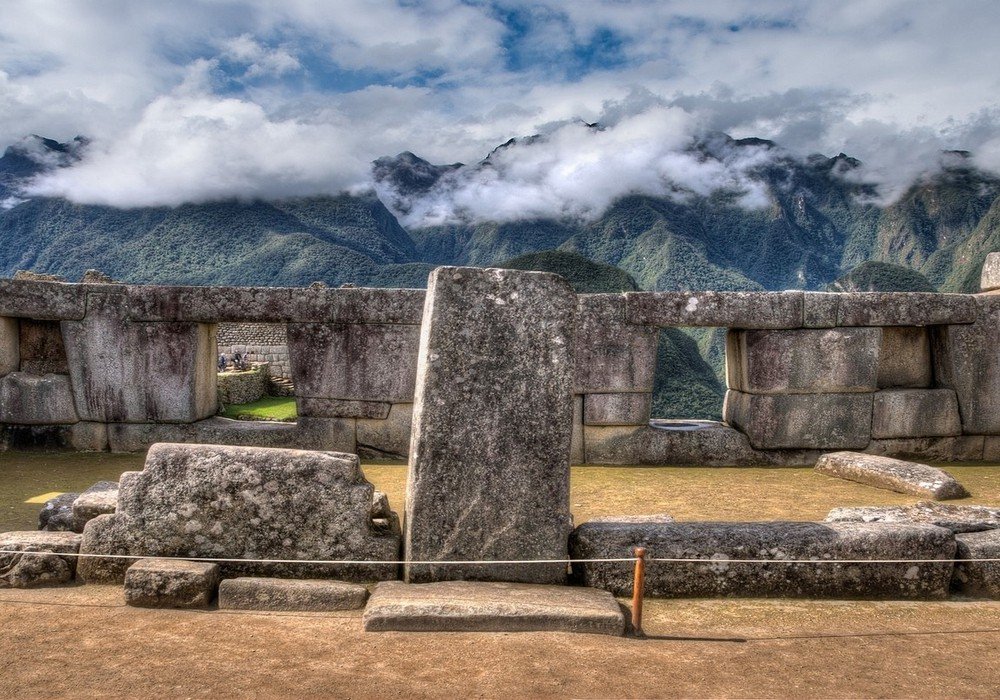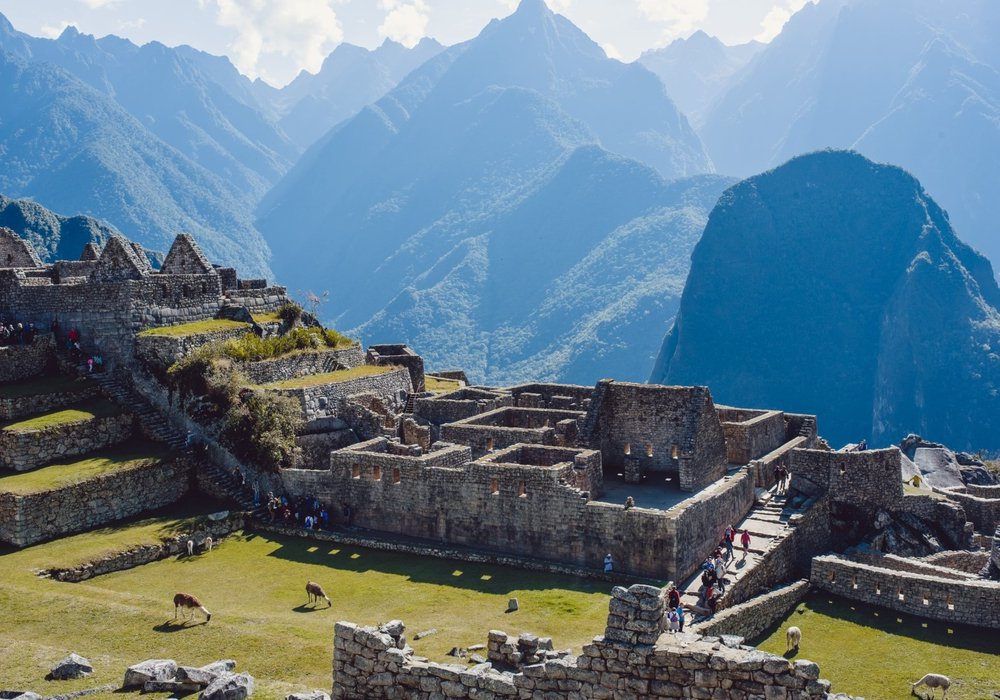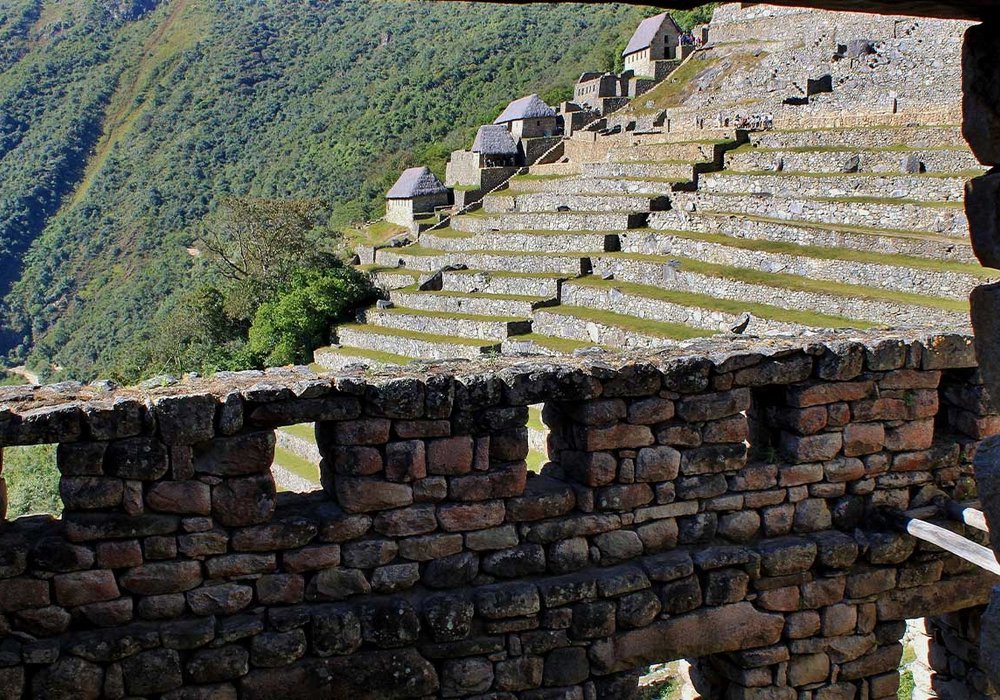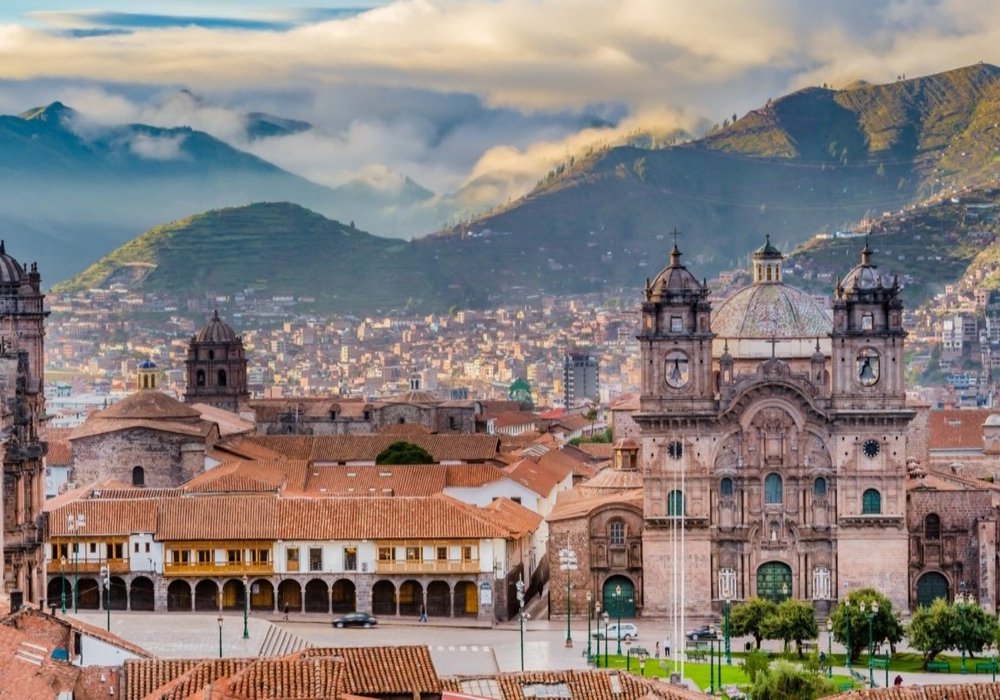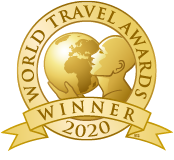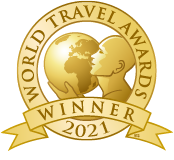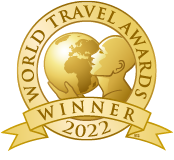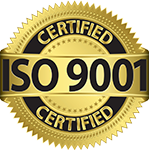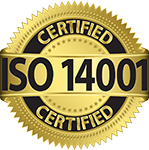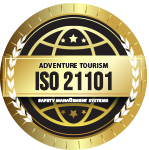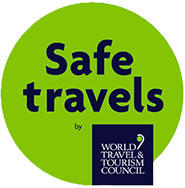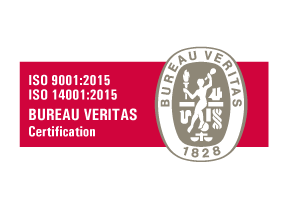Extraordinary prices for your upcoming vacation experience.
Our travel specialists are just a call away, every day of the week.
Our commitment to excellence is reflected in every positive review.
Extraordinary prices for your upcoming vacation experience.
- Trip preparation for the Inca Trail to Machu Picchu
- Family-Friendly Travel
- Food and Cuisine
- Safety and Security
- Technology and Connectivity
- Travel Logistics
- Environmental Responsibility
- Health and Well-being
- Planning & Booking Your Trek
- On the Trail - Salkantay trek
- Your Trek Experience - Salkantay trek
- Camp siteCamp site
- Entrance feeEntrance fee
- HotelsHotels
- SupportSupport
- Tour GuideTour Guide
- TrainTrain
- TransportationTransportation
Trip Overview - Salkantay Trek to Machu Picchu
Of all the various treks to Machu Picchu, none can compete with the Salkantay trekking tour in terms of scenery. It’s a spectacular route, passing through jungles and mountain passes, and dotted with azure lagoons. And at the heart of the Machu Picchu mountain hike is Salkantay Mountain, which at 6,271 m (20,574 ft) is the highest peak in the Vilcabamba mountain range and the twelfth-highest in Peru.
Our 8 day Salkantay trek to Machu Picchu hiking tour traverses the flank of this sacred mountain, offering some of the most awe-inspiring views in Peru. It’s one of the more challenging alternative routes to Machu Picchu, simply because of the high altitude. But it also receives far fewer trekkers than the classic Inca Trail, so you can walk through this natural and remote paradise comparatively free from fellow humans – but you might have to share the stunning scenery with Andean condors and other local wildlife. Why don’t you try off season? March, April, September and October are particularly good months, either side of high season, the weather is still decent and there are fewer people!
Day by day schedule - Salkantay to Machu Picchu Hike Details
Day 1: Arrival to Cusco For your Salkantay Trek to Machu Picchu
Your arrival to Cusco begins the Salkantay trekking package, with a transfer to your hotel. A welcome meeting will be organized by your guide for a detailed briefing of the Salkantay trek to Machu Picchu trek.
The rest of the day can be spent acclimatizing for your Salkantay trek to Machu Picchu and exploring Cusco. Cusco, the ancient capital of the Inca Empire, set in the Andes Mountains. This will help avoid altitude sickness on the Salkantay trek.
Discov...
Meals: Not Included
Hotels: Jose Antonio Hotel in Standard Room with private bath.
Day 2: Cusco Open Day
After breakfast, enjoy a free day to explore Cusco at your ease. This is vital for acclimatization for your Salkantay trekking package and preparing for your Salkantay Trek.
The capital city of the Inca Empire is now the undisputed archaeological capital of the Americas, as well as the continent’s oldest continuously inhabited city. You may visit the local archaeological sites of Saqsaywaman, Tambomachay and Qenqo or you can take part in a Peruvian cooking class or choco...
Meals: Breakfast
Hotels: Jose Antonio Hotel in Standard Room with private bath.
Day 3: Humantay Lake and The Soraypampa Campsite.
Salkantay Trailhead Transportation Options and Stargazing Opportunities on the Salkantay Trek.
Our Salkantay Trek to Machu Picchu begins when we pick you up from your hotel in Cusco at around 5 a.m. We’ll then travel in our private bus to Mollepata, which takes about four hours. It’s a lengthy trip, but it’s needed to get out to the remote region of your Salkantay trekking adventure. along the way, yo...
Meals: All Included
Camp site: Soraypampa
Day 4: Salkantay Trek Through the Mountains
Salkantay trek and Inca Trail comparison - The Hardest Day?
Today we will wake early on our Salkantay Trek to Machu Picchu and have breakfast around 5:30 a.m. We have a long day of trekking ahead of us on our Salkantay trekking package, through some of the most incredible scenery in Peru. This will be our most challenging day, as we ascend to the highest point on the trail; The Salkantay Pass.
We first make the climb to the Salkantay mountain pass at 4,650 m (15,200 ...
Meals: All Included
Camp site: Challay or Andenes
Day 5: Salkantay Trek - Heading Through the Cloud Forest
Salkantay Trek and Coffee Farm Visits, among Other Activities
Waking at 6: 30 a.m., we’ll have a hearty breakfast before setting off on today´s Salkantay to Machu Picchu trek. Today, much of our trekking takes us through a region of jungle known as the “ceja de selva” or eyebrow of the jungle: the swathe of jungle that lies between the Andes and the Amazon rainforest. This is an excellent opportunity for Salkantay trek cultural experiences as we pass ...
Meals: All Included
Camp site: La Playa
Day 6: Salkantay Trek To Llactapata and onto Aguas Calientes
Historic Inca Sites along the Salkantay Route.
On our final day of trekking on this Salkantay Trekking Package, we’ll have breakfast at 6:30 a.m. before setting off towards Llactapata. A historic Inca site along the Salkantay route. It will be a steady three-hour climb, and as we ascend we’ll have wonderful views of the Santa Teresa Valley below us. Eventually, we’ll reach Llactapata, an impressive Inca ruin that may have served as an important restin...
Meals: All Included
Hotels: Hatun Inti Boutique in Suite Room with private bath.
Day 7: Machu Picchu in all its Glory (and Return to Cusco)
Photography Tips for Salkantay Trek - Machu Picchu! (Ask your Guide!)
To best appreciate Machu Picchu, we’ll wake up early in the morning so we can get to the Machu Picchu citadel in good time. You’ll have time for breakfast first, and then your guide will pick you up from the hotel at around 5:40 a.m. Your Salkantay Trail permits and fees and Machu Picchu entrance tickets have all been taken care of and now the day has arrived; Machu Picchu!
We’ll ...
Meals: Breakfast
Hotels: Jose Antonio Hotel in Standard Room with private bath.
Day 8: Transfer to Cusco Airport
After breakfast, enjoy your last day in Cusco at leisure before your transfer to the airport for your return flight home, via Lima. Tjis marks the end of your adventure along The Salkantay Trek to Machu Picchu Tour Package!
Hasta Luego!
Meals: Breakfast
Our Travelers REVIEWS
At Valencia Travel, our mission is to craft unforgettable Peru vacation packages and machu Picchu tours that resonate long after they're over. Our secret? Listening to the stories shared by our travelers during their Peru tour packages. Through their five-star reviews, you'll uncover genuine experiences, from transformative holiday adventures across the majestic landscapes of Cusco to heartwarming connections with local communities on Cusco highland excursions. Each story is a reflection of our commitment to excellence and personalized care, inviting you to see the world through the eyes of those who have journeyed with us on their Peru tour trip. Join us in celebrating the moments that make Valencia Travel a top-rated choice for explorers on their Peru adventure tours from all around the globe.

Contact our travel specialist
Carla Esquivel
“Let me share with you my knowledge and passion for travelling , helping you to plan the best holidays of your life!”
Contact UsDates and Prices - Salkantay Trekking Package
Kickstart your Valencia Travel Peru vacation package by selecting your preferred month of travel in our Dates & Prices section. Here, you'll find all you need to know about our trekking tour package availability and pricing, tailored to fit every season and budget. Navigate through your options to discover the ideal time for your unforgettable tour trip. With just a few clicks, you're on your way to experiencing the beauty and thrill of our Peru adventure packages, or Machu Picchu tour packages, specially curated to your preferences.
Start your Valencia Travel tour package by picking the perfect date through our straightforward availability module. Choose your optimum timeframe to discover your preferred travel options and preferred dates for your Andean adventure of a lifetime. If the listed dates don't align with your plans, don't worry. Reach out to us, and we'll explore alternative dates or Peru trekking options tailored just for you. Our goal is to ensure your travel experience is exactly what you've envisioned and your Machu Picchu tour is perfect. Your dream vacation adventure is just a selection away. We're here to guide you through.
Secure your spot on the Inca Trail now with our real-time availability information.
Act quickly—these spots sell out fast!
Inclusions For The Salkantay Trek to Machu Picchu
Discover exactly what your Valencia Travel Peru vacation package offers. Our Inclusions section highlights everything include in the cost, from accommodations and guided tours to special experiences, ensuring a comprehensive and enriching Peru tour package. In the Exclusions section, we clarify what's not included, like certain personal expenses and optional adventure activities, to help you plan perfectly and customize your Peru trip as desired. Review these sections for a clear understanding of your Peru tour package's value and structure. Any Questions? Our team is ready to assist, ensuring your Peru travel adventures meet your expectations every step of the way.
What's included
- Transport: Private or shared depending on your tour.
- Your Journeys Highlight Moment: Salkantay Trail and Machu Picchu.
- Arrival and departure to Cusco transfer.
- Briefing to the tour one day before the trek at 19h00.
- All transport between destinations. and to/from included activities.
- Professional English-speaking guide service.
- Salkantay and Machu Picchu entrance fee.
- Train ticket from Aguas Calientes to Ollantaytambo.
- First aid kit.
- Round trip bus ticket from Aguas Calientes to Machu Picchu and back on the second day.
- 24/7 support and emergency line available throughout the itinerary.
What's not included
- Airfare to and from Cusco.
- Minimum medical and emergency evacuation insurance.
- Trip cancellation insurance or any other travel insurance
- Evacuation: in the event of a serious medical injury, we will coordinate with your travel insurance company to arrange evacuation.
- Visas.
- Any activity not described in What's Included.
- Meals on your own.
- Gratuities.
- Optional excursions.
- Personal equipment such as trekking gear.
- Camping equipment such as sleeping bag or walking sticks.
- Damages caused by the client to the bus or to the camping equipment.
Additional Information For The salkantay Trek to Machu Picchu
Dive into our Additional Information section for key insights and answers before your Machu Picchu tour package with Valencia Travel begins. Here's what you'll find:
- Meeting Times: Essential start details for your Peru adventure packages.
- FAQs: Quick answers to your Peru travel questions.
- Destination Insights: Everything you need to know about your travel destination.
This resource hub is designed to ensure you're well-prepared and excited for what lies ahead. Need more Peru info? We're just a message away.
GENERAL INFORMATION ABOUT TRAVELING TO PERU
Ok, so maybe you have heard of Machu Picchu, or you have learned about the incredible Inca civilisation and lost cities of gold in school, but did you know that Peru is a country of endless discovery? With its diverse culture, rich history, stunning scenery, and delicious food, Peru is a truly unforgettable destination that is on many travelers bucket-lists. Whether you want to hike the Inca Trail to Machu Picchu, sample the exquisite Peruvian cuisine in the top restaurants in the world, visit unique natural features that can only be found in this Andean country, sail on the highest navigable lake in the world, Titicaca, or explore the biodiverse regions of the largest jungle in the world, The Amazon. Peru really does have it all for the adventurous, and curious, traveler, looking for a vacation with a difference. Here is some general information about traveling to Peru.
Peruvian Territory
The Republic of Peru has a population of 31.92 million people who live on a landmass spanning 1.285 million km2, making for some densely populated areas like the capital, Lima.
The Different Regions of Peru
Peru is a country of diverse regions, each with its own unique culture, landscape, and attractions. Here is a brief overview of the three main regions of Peru:
The Coast:
The coastal region of Peru is a narrow strip of land that runs along the Pacific Ocean. It is the most densely populated region of Peru and is home to the capital city, Lima. When you travel to Lima, Peru its warm climate, arid landscape, and impressive surf beaches are evident. Some of the popular tourist destinations on the coast include:
- Lima: Peru's capital city is a vibrant metropolis with a rich history and culture. Many Lima, Peru tours visit the Plaza de Armas, the Cathedral of Lima, and the Larco Museum.
- Arequipa: This historic city is known for its white colonial architecture and its not far from Arequipa to Colca Canyon.
- Paracas National Reserve: This reserve is home to a variety of wildlife, including sea lions, penguins, and flamingos.
The Andes:
The highland region of Peru. It is home to the Andes Mountains, as well as the ancient Inca city of Machu Picchu. The Sierra is known for its cool climate, dramatic scenery, and traditional culture. Some of the popular tourist destinations in the Sierra include:
- Cusco: This historic city was the capital of the Inca Empire. It is a popular base camp for visitors to Machu Picchu.
- Machu Picchu: Any trip to Peru isn’t complete without a Machu Picchu vacation package. This ancient Inca city is one of the New Seven Wonders of the World. It is perched high in the Andes Mountains and is a must-see for any Peru adventure vacation.
- Sacred Valley: Any Sacred Valley tour from Cusco will take you to many important Inca ruins, including Pisac, Ollantaytambo, and Moray.
- Colca Canyon: From Arequipa to Colca Canyon is just a few hours drive. This canyon is one of the deepest in the world and is home to condors, the largest flying birds in the Western Hemisphere.
Amazon Rainforest:
The Amazon Rainforest is the largest rainforest in the world and covers over 60% of Peru. It is home to an incredible diversity of plants and animals, many of which are found nowhere else on Earth. The Amazon Rainforest is a great destination for travelers who are interested in nature and adventure. Some of the popular tourist destinations in the Amazon Rainforest include:
- Iquitos: Iquitos jungle tours are a great way to experience the Amazon and Iquitos is considered the gateway to the Peruvian Amazon. It is a popular base camp for visitors who want to explore the rainforest to the maximum.
- Madre de Dios: Madre de Dios is a region located in the southeastern part of Peru, in the Amazon rainforest. Visitors can enjoy activities such as hiking, rafting, canoeing, fishing, and wildlife watching.
- Manu National Park: Manu rainforest tours are a great way to see a variety of wildlife, including jaguars, macaws, and caimans.
- Tambopata National Reserve: This reserve is a great place for birdwatching, as it is home to over 1,000 different species. Famous for its stunning natural beauty and rich cultural diversity, a place that is sure to leave a lasting impression on visitors.
Peru´s Main Attractions:
- Machu Picchu: One of the New Seven Wonders of the World, Machu Picchu is an ancient Inca city that is nestled in the Andes Mountains. Any decent Machu Picchu Travel Agency like Valencia Travel will take you to the magical Inca citadel.
- Sacred Valley: The Sacred Valley is a region of Peru that is home to many important Inca ruins, including Pisac, Ollantaytambo, and Moray.
- Colca Canyon: The Colca Canyon is one of the deepest canyons in the world and is home to condors, the largest flying birds in the Western Hemisphere.
- Amazon rainforest: The Amazon rainforest is the largest rainforest in the world and is home to a diverse range of plants and animals.
- Lake Titicaca: Lake Titicaca is the highest navigable lake in the world and is home to the floating Uros Islands.
Entry and Visa requirements to enter Peru
In this comprehensive guide, we will explain the entry requirements for when you visit Peru, ensuring that your travel plans are not only well-informed but also hassle-free. Whether you are a seasoned traveler or setting foot in Peru for the first time, we will walk you through the visa regulations, and essential documentation needed to make your Peru adventure vacation a seamless and unforgettable experience.
Entry requirements for European and USA Citizens:
- A passport with six months validity is required to enter Peru. Immigration authorities may also require evidence of return/onward travel.
- Be sure your date and place of entry is officially documented by Peruvian Immigration, whether you arrive at a port, airport, or land border for your trip to Peru.
- Your length of approved stay will be determined by border officials at the time of entry and can range from 30 to 183 days. Extensions for tourists are usually not approved and overstays result in fines.
- The Embassy is unable to assist if you are denied entry. Peruvian immigration requires airlines to return travelers who are denied entry to their point of origin.
Requirements for Exit:
If you do not have an entry record, you will not be allowed to exit the country until immigration authorities confirm the time and place of your entry into the country. This can be a difficult process, costing considerable time and money to resolve.
Make sure the Immigration authorities record your entry, and then save the record for your exit. An entry record is required even at remote border crossings, where often the proper officials are not present.
Immediately report lost/stolen passports to local police and keep the report. You must apply for a new passport at the Embassy and obtain a replacement entry record from Immigration using your police report prior to exiting Peru.
Travel with Minors:
Regardless of nationality, all children who are traveling with both birth parents are required to have a valid passport and the necessary visa or citizenship of the country where they are traveling. Peruvian immigration procedures are complex for minors traveling without one or both parents/legal guardians.
For entry/exit from Peru, foreigners, minors under the age of 18, traveling alone or with only one parent, generally do not require additional documentation if entering as a tourist for less than 183 days. However, if the stay lasts more than 183 days, then a “Permiso Notarial de Viaje” is required.
* A Permiso Notarial de Viaje is a written, notarized authorization from the non-traveling parent(s). Peruvian immigration will not accept a document notarized by a foreign Embassy or a document notarized by a foreign notary in lieu of a Permiso Notarial de Viaje. Please be aware that these authorizations are valid for 30 days and one trip only.
Minors who are dual national Peruvians, traveling alone or with only one parent, require a “Permiso Notarial de Viaje”. Furthermore, step-parents or guardians accompanying a dual U.S.-Peruvian citizen minor must provide a Permiso Notarial de Viaje from the non-traveling minor’s parents (as listed on the birth certificate). Finally, if an accompanying parent has sole custody, legal documentation is required. For example, a foreign court-approved custody document stating sole custody, a death certificate, a Peruvian court-approved document for travel, or a birth certificate listing only one parent.
Visa Requirements and How to Apply
The detailed visa requirements for Peru vary depending on your nationality. Here is how to apply for a Peruvian visa: Step-by-step guide.
- Your passport must be valid for at least six months after your expected date of departure from Peru.
- You must have at least one blank page in your passport for an entry stamp.
- You must have a return or onward ticket.
- You may be asked to provide evidence of sufficient funds to support yourself during your stay in Peru.
Visa-free entry: Citizens of the following countries are eligible for visa-free entry to Peru for up to 90 days:
- Andorra
- Antigua and Barbuda
- Argentina
- Aruba
- Australia
- Austria
- Bahamas
- Barbados
- Belgium
- Belize
- Bolivia
- Brazil
- Brunei
- Bulgaria
- Canada
- Chile
- Colombia
- Costa Rica
- Croatia
- Curaçao
- Cyprus
- Czech Republic
- Denmark
- Dominica
- Dominican Republic
- Ecuador
- El Salvador
- Estonia
- Finland
- France
- Germany
- Greece
- Grenada
- Guatemala
- Guyana
- Haiti
- Honduras
- Hong Kong
- Hungary
- Iceland
- Ireland
- Israel
- Italy
- Jamaica
- Japan
- Korea (Republic of)
- Latvia
- Lesotho
- Liechtenstein
- Lithuania
- Luxembourg
- Malawi
- Malaysia
- Malta
- Mauritius
- Mexico
- Monaco
- Mongolia
- Montenegro
- Montserrat
- Mozambique
- Netherlands
- New Zealand
- Nicaragua
- North Macedonia
- Norway
- Oman
- Palau
- Panama
- Paraguay
- Poland
- Portugal
- Puerto Rico
- Qatar
- Romania
- Saint Kitts and Nevis
- Saint Lucia
- Saint Vincent and the Grenadines
- Samoa
- San Marino
- Saudi Arabia
- Serbia
- Seychelles
- Singapore
- Sint Maarten (Dutch part)
- Slovakia
- Slovenia
- Solomon Islands
- Spain
- Suriname
- Sweden
- Switzerland
- Taiwan
- Trinidad and Tobago
- Turks and Caicos Islands
- United Arab Emirates
- United Kingdom
- United States
- Uruguay
- Vanuatu
- Vatican City
- Venezuela
Visa on arrival
Citizens of the following countries are eligible for a visa on arrival to Peru for up to 180 days:
- Bolivia
- Brazil
- Chile
- Colombia
- Ecuador
- Paraguay
- Uruguay
Visa required
Citizens of all other countries require a visa to enter Peru. Visas can be obtained from Peruvian embassies and consulates around the world.
Additional requirements:
In addition to the general requirements listed above, you may also be required to provide the following documents when applying for a Peruvian visa:
- A completed visa application form
- A passport photo
- Proof of sufficient funds to support yourself during your stay in Peru
- A return or onward ticket
- A letter of invitation from a Peruvian resident (if required)
The specific visa requirements for Peru may vary depending on your nationality and the purpose of your visit. It is important to check with the Peruvian embassy or consulate in your home country for the latest information.
Travel Insurance in Peru - Everything You Need to Know for your Peru Adventure Vacation
Peru is a popular destination for adventure travelers, with activities like hiking the Inca Trail to Machu Picchu, mountain biking in the Andes, and surfing on the Pacific coast. However, it is important to note that these activities can be dangerous, and it is important to have travel insurance in case of an accident or illness, on any Peru vacation package. Here are some important pointers about understanding travel insurance-what you need to know.
What is travel insurance?
Travel insurance is a type of insurance that protects you against financial losses incurred while traveling. It can cover a variety of expenses, including medical bills, lost luggage, and trip cancellation.
Why is travel insurance important for Peru?
Peru is a developing country with limited medical facilities, especially in remote areas. If you have an accident or illness while traveling in Peru, you could face high medical bills. Travel insurance can help cover these costs, as well as the cost of transportation back home.
Additionally, Peru is a country with a wide range of climates and altitudes. It is important to be prepared for the possibility of altitude sickness, heatstroke, and other health problems. Travel insurance can help cover the cost of medical treatment for these conditions.
What types of adventure activities are covered by travel insurance?
Most travel insurance policies will cover a wide range of adventure activities, on your Peru adventure vacation, including:
- Hiking
- Trekking
- Mountain biking
- Surfing
- Whitewater rafting
- Scuba diving
- Skydiving
However, it is important to check your policy carefully to make sure that the specific activities you are planning are covered.
How to choose a travel insurance policy for Peru
When choosing a travel insurance policy for any of our Peru vacation packages, there are a few things to keep in mind:
- Make sure the policy covers the adventure activities you are planning. As mentioned above, not all travel insurance policies cover all adventure activities. Be sure to check your policy carefully to make sure that the specific activities you are planning are covered.
- Choose a policy with a high enough medical coverage limit. Medical costs in Peru can be high, so it is important to choose a policy with a high enough medical coverage limit to cover your potential expenses.
- Consider purchasing evacuation coverage. Evacuation coverage can help cover the cost of transporting you back home in case of a medical emergency. This is especially important if you are planning on traveling to remote areas of Peru.
How to file a travel insurance claim
If you need to file a travel insurance claim, you should contact your insurance company as soon as possible. They will be able to guide you through the process and help you get the compensation you are entitled to.
Travel insurance is an important investment for any traveler, but it is especially important for travelers to Peru. With its diverse landscape and range of adventure activities, Peru is a country where accidents can happen. Travel insurance can help protect you from financial losses in case of an accident or illness.
Tips for choosing and using travel insurance in Peru
- Read the policy carefully before you buy it. Make sure you understand the terms and conditions of the policy, including what is and is not covered.
- Purchase your insurance policy early. This will give you time to file a claim if necessary.
- Keep a copy of your insurance policy with you at all times. This will make it easy to file a claim if you need to, during your Peru adventure tours.
- Contact your insurance company if you have any questions or concerns. They will be able to help you understand your policy and file a claim if necessary.
Recommended Travel Insurance Companies
- WorldTrips: The Atlas Travel Insurance plan is our “best value“. One of the first insurers in the world to offer plans for purchase over the Internet, WorldTrips helps thousands of customers in over 130 countries. You get a range of benefits and excellent customer service at an affordable price.
- GeoBlue: The GeoBlue Travel Insurance is our best plan for US citizens traveling abroad. GeoBlue is a member of the world-renowned Blue Cross Blue Shield Association and has the premier network of doctors in over 180 countries.
- IMG: The Patriot Travel Insurance plan is one of the world’s leading global travel and medical insurance policies; IMG services members in over 190 countries.
- World Nomads: Adventure travelers from over 130 countries rely on World Nomads to cover them for over 200 adventure activities on your Peru adventure trip.
- Seven Corners Travel Insurance: Hundreds of thousands of international clients have trusted Seven Corners and their global network of healthcare providers to care for them while abroad.
- Global Underwriters: Global Underwriters are especially notable for their coverage of internationally organized sporting activities.
- AMEX Travel Insurance: American Express is the oldest company on the list, established in 1850. You don’t have to be a cardholder to get their insurance, but you will get special perks if you are.
- TripTime Insurance: TripTime has an easy-to-use interface for any trip, allowing you to add coverage for adventure sports, marine activities, and personal property on your Peru adventure vacation.
Local Culture and Customs in Peru
Peruvian culture and customs in Peru are a diverse mix of indigenous, Spanish, and African influences. The country is home to a variety of indigenous peoples, each with its own unique culture and traditions. The Spanish conquistadors arrived in Peru in the 16th century and brought their own language, religion, and customs with them. African slaves were also brought to Peru, and their culture has also had a significant impact on Peruvian culture. One of the most notable aspects of Peruvian culture is its music and dance. Peruvian music is a fusion of indigenous, Spanish, and African influences. Some of the most popular genres of Peruvian music include cumbia, salsa, and huayno. Peruvian dance is also a popular form of cultural expression. Peruvian cuisine is another notable aspect of a Peruvian culture vacation. Peruvian cuisine is known for its use of fresh ingredients and its variety of dishes. Peruvian culture is a rich and diverse tapestry of influences from all over the world. It is a culture that is full of life, color, and flavor and an integral part of the immersive experience on your Peru culture trip!.
Peruvian People
Peruvians are generally friendly and welcoming people. They are always happy to help visitors and share their culture with them. Peruvians have a strong sense of family and community. They are also very proud of their country's rich history and culture. Peru is a very religious country. The majority of Peruvians are Roman Catholic. Peruvians are known for their love of food and music. They also enjoy spending time with family and friends.
Peru Festivals
Peru has a number of vibrant festivals throughout the year. To immerse yourself in true Peruvian culture, try and visit a traditional festival in Peru. Some of the most popular festivals include:
- Inti Raymi: Inti Raymi is a Peru festival that celebrates the winter solstice and the sun god Inti. It is held on June 24th in Cusco.
- Qoyllur Rit'i: Qoyllur Rit'i is a festival that celebrates the Virgin of the Snow Star. It is held in the Ausangate mountains in May or June.
- Carnaval: Carnaval is a festival that celebrates the beginning of Lent. It is held in February or March and is celebrated throughout Peru.
Peru is a country that has something to offer everyone. Whether you are interested in culture, history, food, nature, or adventure, you are sure to find something to love in Peru. With its endless possibilities, Peru is a country that you can visit over and over again and always have a different and unique experience. So enjoy the best of Peru culture travel and immerse yourself in local Peruvian culture at every opportunity!.
Currency & Payments: How to Manage Money While Traveling in Peru
Traveling to Peru is an adventure that promises awe-inspiring landscapes, unique adventures, rich cultural experiences, and delicious cuisine. To make the most of your Peru trip, it's essential to understand how to manage your money efficiently on your Peru vacation package. In this comprehensive guide, we'll cover everything you need to know about handling your money in Peru, including currency exchange options, ATMs, exchange rates, and credit cards! Read on for our tips for managing currency and payments in Peru!
Currency in Peru
Peru's official currency is the Peruvian Sol (PEN). While major cities and tourist destinations often accept US dollars, it's advisable to carry some Peruvian Soles for smaller purchases and to avoid unfavorable exchange rates. All Major cities when you visit Peru have a number of options for withdrawing you cash and you can usually choose to withdraw US dollars, or Peruvian soles, which will charge the appropriate exchange rate as well as the withdrawal charge. It is recommended to convert your currency to Soles once you first arrive in Peru, for your Peru getaway, as the exchange rate should be better here than in your home country. There are lots of small changing booths located near the tourist center of any city in Peru and most have an honest exchange rate.
Fake Notes /Damaged Notes
Fake bills are fairly common in Peru and nearly everyone has their own way of checking. When you pay in cash you will see merchants holding up the bill to the light, running it between their hands or subjecting it to other tests. You can generally tell a fake note as they feel a lot smoother to the touch and don’t have the metal security line running through them. If in doubt ask them to change the note. Don't be alarmed, this is a normal on Peru vacation packages! Most people are looking for watermarks, metallic markings, and raised lettering that prove the bill is real. Most stores will not accept your money if it is too worn out or ripped.
When you exchange your money, on your Peru vacation package, don't hesitate to ask the changer for a different bill if you think the one, they gave you is too worn out or if it is ripped. If you do get stuck with an old, but real, bill that no one will take, then you can go to any bank and they will replace it free of charge with a bill of equal value.
US Dollars are commonly accepted for larger purchases. The dollar bills will only be received if they are brand new and not ripped in any way.
Currency and Payments in The Main Cities
Lima:
- ATMs: ATMs are widely available throughout Lima, especially in Miraflores, Barranco, and the historic center. Look for major banks like Banco de Crédito del Perú (BCP), BBVA Continental, Scotia Bank and Interbank, when you travel to Lima, Peru.
- Money Changers: When you visit Lima, you can find currency exchange offices in tourist areas, malls, and at the airport. For competitive rates, consider visiting exchange houses like Western Union or exchanging money at a bank.
- Credit Cards: Credit cards are widely accepted when you visit Lima, including at most hotels, restaurants, and shops. Visa and MasterCard are the most commonly accepted cards and American Express and Diners are accepted in in many establishments.
Cusco:
- ATMs: ATMs are readily available in Cusco's city center, around Plaza de Armas, and in the San Blas neighborhood. On your Cusco tours, look for Banco de Crédito del Perú (BCP) Interbank, Scotia Bank and Globalnet ATMs. That are on almost every street corner.
- Money Changers: Currency exchanges are numerous in Cusco, especially near Plaza de Armas and along Avenida El Sol, which you are sure to pass on your Cusco city tour. Check for competitive rates and fees.
- Credit Card: Credit cards are accepted in many establishments in Cusco, but it's wise to carry cash for smaller businesses, markets, and rural areas.
Arequipa:
- ATMs: ATMs are available in Arequipa's city center, especially around Plaza de Armas and Calle Mercaderes. Popular banks include Banco de Crédito del Perú (BCP) Interbank and Banco Continental, which you are sure to pass by on your Arequipa city tour.
- Money Changers: You can find currency exchange services in central locations, including banks and exchange offices. Compare rates for the best deal.
- Credit Card Acceptance: Credit cards are accepted in many restaurants, hotels, and shops in Arequipa's main tourist areas and on most Arequipa tours.
Puno:
- ATMs: ATMs are found in the city center of Puno, near Plaza de Armas, Lima Street, where the major banks such as Banco de Crédito del Perú (BCP), Interbank and Banco Continental are.
- Money Changers: Currency exchange offices can be found in central locations around Puno and easily visible on any of the Puno tours. Check rates and fees before exchanging money.
Credit Card Acceptance:
Credit cards are accepted in the restaurants and hotels you will visit on your Peru vacation package, but cash is preferred in many smaller establishments and local markets. If you are buying in local stores, soles are the only way to purchase. Try and break up your bigger notes in larger establishments as change is quite often an issue, especially in more remote regions.
Exchange rates in Peru:
Regarding exchange rates in Peru, it's essential to check with the specific businesses or hotels as rates can vary. In most cases, you'll be charged in Peruvian Soles (PEN), but some high-end establishments may offer the option to pay in US dollars at a potentially less favorable exchange rate. Always ask for the local currency amount to get the best value for your money. At the time of writing, there are $3.70 soles to the US Dollar.
Language Tips: Do You Need to Speak Spanish for a trip to Peru?
When planning a trip to Peru, one question that often arises is whether you need to speak Spanish to navigate this South American country. While it's true that knowing some Spanish can enhance your travel experience, it's not an absolute requirement. Let´s explore the advantages of speaking Spanish in Peru, the areas where it can be beneficial, and practical language tips for travelers who may not be fluent but still want to make the most of their Peru Machu Picchu trip.
The Advantages of Speaking Spanish in Peru:
Enhanced Cultural Experience: Speaking Spanish can open doors to a deeper understanding of Peruvian culture. You can engage in meaningful conversations with locals, learn about their traditions, and partake in cultural activities more easily on their Peru culture trip.
Improved Communication: In rural areas and small towns, English proficiency among locals may be limited. Knowing Spanish can help you communicate your needs, ask for directions, and seek assistance when required when you are traveling in the more remote regions of your Peru trip.
Navigating Public Transportation: While major tourist hubs often have bilingual signs, public transportation in smaller towns may not. Having basic Spanish skills can be invaluable when using buses, taxis, and local services, especially on any Lima tour packages.
Where You May Not Need Spanish
In Peru's popular tourist destinations like Lima, Cusco, and Machu Picchu, you'll find that many people in the service industry, such as hotel staff, tour guides, and restaurant workers, speak at least some English. In these areas, it's possible to get by with minimal Spanish skills. However, to truly immerse yourself in the local culture and explore off-the-beaten-path locations, on a Sacred Valley Tour from Cusco for example, having a grasp of the language can be immensely helpful.
Practical Language Tips for Travelers
Learn Basic Phrases: Even if you're not fluent, learning essential phrases like greetings, thank you, and please can go a long way. Peruvians appreciate when travelers make an effort to communicate in their language.
Use Language Apps: There are several language-learning apps and websites that can help you pick up basic Spanish before your trip. Duolingo, Babbel, and Rosetta Stone are popular options.
Carry a Pocket Dictionary: A pocket-sized Spanish-English dictionary can be a handy tool for quick translations when you're on the go.
Practice Pronunciation: While grammar and vocabulary are important, working on your pronunciation can make you more easily understood by locals.
Engage Locals: Don't be afraid to strike up conversations with locals. They are often eager to help and can provide valuable insights into their culture and language.
While speaking Spanish in Peru isn't mandatory, it can significantly enrich your travel experience. Learning a few basic phrases for your Peru vacation package, for being open to interactions with locals, and having some language tools at your disposal will empower you to explore this beautiful country with greater ease and authenticity, whether you're visiting popular destinations or venturing off the beaten path on your Peru trip.
The Top Kid Friendly Activities in Peru:
Peru offers a wide range of kid-friendly activities that can make your family trip both fun and educational. Here are some top options:
- Machu Picchu: While the hike itself might not be suitable for very young kids, a visit to Machu Picchu is a great way to introduce children to history and culture. They'll be amazed by the ancient ruins and stunning scenery.
- Cusco: The city of Cusco is filled with history and culture. Visit the Plaza de Armas, explore Inca ruins, and enjoy the local markets. Kids can learn about Inca history and see the fusion of Inca and Spanish architecture.
- Sacred Valley: Explore the Sacred Valley of the Incas. Visit Pisac and Ollantaytambo to see more ruins and experience local culture. The wide-open spaces are perfect for kids to run around and explore.
- Nazca Lines: Older kids with an interest in history and mysteries might enjoy a flight over the Nazca Lines. These massive geoglyphs in the desert are a fascinating sight.
- Amazon Rainforest: A family adventure in the Amazon jungle can be incredibly educational and fun. Kids can see unique wildlife, learn about the rainforest ecosystem, and experience boat rides and jungle walks.
- Arequipa: The Santa Catalina Monastery in Arequipa is like a mini city within the city. Kids can explore its narrow streets, colorful buildings, and historical rooms.
- Ballestas Islands: Take a boat tour to the Ballestas Islands to see penguins, sea lions, and a variety of bird species. It's like a mini Galapagos experience.
- Beaches: Peru has some beautiful beaches. Mancora, for example, is a family-friendly destination with warm waters and plenty of activities like swimming, surfing, and sandcastle building.
- Local Markets: Visiting local markets can be a cultural experience for kids. They can see traditional Peruvian products, taste local foods, and engage with locals.
- Chocolate Making: Peru is known for its delicious chocolate. Consider taking a chocolate-making workshop where kids can learn about the process and make their own treats.
- Inca Textile Workshops: In Cusco and the Sacred Valley, you can find textile workshops where kids can learn about traditional Inca weaving techniques and even create their own textiles.
- Parque de la Reserva (Magic Water Circuit): In Lima, this park features a series of fountains with colorful lights and music. It's a mesmerizing and entertaining experience for kids of all ages.
- Cusco Planetarium: A visit to the planetarium in Cusco can be an educational and interactive experience for kids, where they can learn about Inca astronomy and the night sky.
- Peruvian Cuisine: Let your children explore Peruvian cuisine. Encourage them to try ceviche, empanadas, and other local dishes. Many Peruvian restaurants are family-friendly.
Remember to adapt your activities to your children's ages and interests to ensure a memorable and enjoyable experience in Peru.
The Best Kid-friendly Hotels and Child care Options in Peru
Peru offers many family-friendly hotels and child care options to make your trip enjoyable and stress-free. Here are some recommendations for kid-friendly hotels and child care options in Peru.
Kid-Friendly Hotels:
- Inkaterra Machu Picchu Pueblo Hotel (Aguas Calientes, Machu Picchu)
This eco-friendly resort in the heart of the cloud forest is a great option for families. They offer various child-friendly activities and have spacious rooms and beautiful gardens. - Belmond Miraflores Park (Lima)
This luxury hotel offers family suites and amenities such as a pool and children's menu at their restaurant. It's conveniently located in the Miraflores district. - Sumaq Machu Picchu Hotel (Aguas Calientes, Machu Picchu)
This hotel offers family-oriented amenities and is located just a short walk from the Machu Picchu Sanctuary. They have a children's program that includes art and cooking classes. - Palacio del Inka, a Luxury Collection Hotel (Cusco)
A beautiful hotel in Cusco, offering family suites and proximity to the city's historic attractions. - Explora Valle Sagrado (Sacred Valley)
This all-inclusive resort offers family-friendly activities and excursions in the Sacred Valley, allowing kids to explore the region.
Child Care and Babysitting Services:
- Ask the Hotel:
Many hotels can arrange for babysitting services. Inquire with your hotel about their childcare offerings. They often have trusted local caregivers. - Local Babysitting Agencies:
In major cities like Lima and Cusco, you can find babysitting agencies that can provide reliable child care services. Examples include "Nanas y Amas de Casa" or "Bebeviajes." - Check Reviews:
Before choosing a babysitter or childcare service, read reviews and ask for recommendations from other travelers. Safety should be a top priority. - Online Services:
You can use online platforms like Babysits or Care.com to find local caregivers. Ensure you thoroughly vet and check references when hiring independently.
Remember that it's essential to take necessary precautions and thoroughly vet any child care providers. Ensure that they are experienced, trustworthy, and capable of communicating in a language you are comfortable with.
Additionally, when traveling with children in Peru, consider exploring family-friendly attractions like the Larco Museum in Lima, visiting the Pisac Market in the Sacred Valley, or taking a boat trip on Lake Titicaca. These destinations offer fun and educational experiences for kids.
The best Family Restaurants in Peru
Peru offers a rich culinary tradition, and there are many family-friendly restaurants where you can enjoy delicious Peruvian cuisine. Here are some of the best family restaurants in Peru:
- Panchita (Lima): Panchita is a popular family restaurant in Lima, known for its delicious Peruvian dishes, particularly grilled meats, and traditional side dishes. The atmosphere is welcoming, making it a great choice for families.
- La Lucha Sangucheria (Lima): La Lucha is famous for its mouthwatering sandwiches, including the classic Peruvian sandwich, "Butifarra." The casual and friendly ambiance is suitable for families with kids.
- Canta Rana (Lima): Located in the Barranco district, Canta Rana is a beachside restaurant with a relaxed atmosphere. They serve a variety of seafood dishes and have a kids' menu, making it a great choice for families.
- Pardo's Chicken (Various Locations): Pardo's Chicken is a Peruvian chain known for its delicious rotisserie chicken and a wide range of side dishes. It's a family-friendly spot with options for children.
- Tanta (Various Locations): Tanta is a popular chain of Peruvian restaurants owned by renowned chef Gastón Acurio. They offer a diverse menu with a mix of traditional and fusion dishes, making it a great choice for families seeking variety.
- El Mercado (Lima): El Mercado is a trendy but family-friendly restaurant in Lima, serving a mix of traditional and contemporary Peruvian cuisine. They offer a welcoming environment and a kids' menu.
- Papachos (Lima and Cusco): Papachos is a burger joint in Lima owned by celebrity chef Gastón Acurio. It's a great place for families looking for a taste of Peruvian-inspired burgers and casual dining.
- Jack's Café (Cusco): Jack's Café is a popular breakfast and brunch spot in Cusco. It's a cozy and family-friendly place, known for its delicious breakfast items, sandwiches, and smoothies.
- Sumaqcha (Cusco): Sumaqcha is a restaurant located near the San Pedro Market in Cusco. It serves authentic Peruvian food in a friendly, local atmosphere, making it a great option for families looking for an immersive experience.
- Cucharitas (Cusco): Cucharitas is an ice cream specialty restaurant with an excellent selection of dishes for parents and children .....the perfect family option!.
The Top Traditional Dishes to try in Peru
Peruvian food is a cuisine of contrast, robust yet delicate, acidic with sweet or starchy and hot and cold on the same plate. Traditional Peruvian food relies on different herbs and spices, producing bold flavors, ranging from the crisp and refreshing to the deep and hearty, combining opposites in a blend of culinary genius. While many people visit Peru to experience Machu Picchu and unparalleled trekking, Peru’s true treasure is its rich culinary heritage. Rich ingredients from the coast, the Andes and The Amazon combine with culinary techniques from Africa, Europe, and East Asia come together to produce unique taste sensations, giving Peru the title of the culinary capital of South America. Peru’s gastronomic boom began, reinventing dishes that had a long tradition in the kitchens of Peruvian families. Here is a list of top traditional Peruvian dishes to sample on your visit to Peru.
- Ceviche.- Let’s begin with the national dish of the country. Ceviche can be described as addictive and there are not many Peruvians who don’t class this Peruvian dish as one of their favorites. Other South American countries have their own versions of the dish, but this marinated fish or seafood, served cold, includes the catch of the day, marinated for a few minutes in lime juice, onion, salt, and hot chilies (aji) in Peruvian cuisine. Preparing a ceviche is an art that Peruvians like to experiment with to make other dishes like quinoa ceviche and even a mango ceviche for vegetarians!.
- Lomo Saltado.- There’s nothing more Peruvian than lomo saltado. As a country that is home to diverse cultures, the birth of this dish could only have been possible because of cultural influences in the kitchen. Lomo Saltado is originally a Chinese dish brought by Chinese immigrants. Combine sliced steak, marinated in soy sauce, red onions, french fries, ají amarillo or chili and you have the basic recipe, then serve with rice. Coming in second only to ceviche in popularity, lomo saltado is a mix of Chinese stir-fry and classic Peruvian cuisine. Originating from the coastal region of Peru, this world -famous dish is on most menus throughout the country these days and is a must -try on your Peruvian vacation.
- Aji de Gallina.- There are different stories about the origins of the deliciously creamy Aji de Gallina. Historians say that when Peru was taken over by the Spanish, a dish that came from Europe made with chicken breast and Arab seasonings, became the first version of Aji de Gallina. Another theory claims that poor citizens collected the hen bones that were thrown away by the rich and took the remains to their houses where they added chili and bread to make a bigger meal. Aji de Gallina today is generally made with strips of chicken, bread, potatoes, olives and eggs, and is one of the most unique dishes on your Peru vacation.
- Pachamanca.- Pachamanca originates from the Andean region and the cooking is done underground, somewhat like an underground barbecue! The word “pachamanca” is broken down into two: “pacha” meaning earth, and “manca” meaning pot. This impressive dish has been served at important ceremonies since pre-Columbian times. It is cooked with hot stones that cover the meat and vegetables, along with potatoes and other spices used according to the region, then covered with earth to do its thing!
- Cuy (Guinea Pig).-Guinea pig or “Cuy “in Spanish is the second most popular meat source in the Andes, with alpaca being the first. The thoughts of eating a rodent or a pet may seem an unfavorable idea for many, however a melt-in-your-mouth tender dark meat, infused with the taste of wood smoke, all beneath a crispy golden skin. Just imagine you’re eating a single-serving roast suckling pig or roast chicken and enjoy this tasty, low calory nutricious dish as the Incas once did.
- Arroz con Pollo /Pato.- On the surface, this appears to be a simple Spanish Creole recipe. In Peru, however, this is a signature dish with many regional variations. Typically, the rice is combined with cilantro paste, herbs, and dark beer to lend it a hearty, earthier flavor. Topped with a leg or thigh of roast duck or chicken, this dish is served up all over Peru both at home or in restaurants.
- Juane.- This traditional Amazonian dish is a must-try if you are heading into the jungle region of Peru. It consists of rice, chicken, eggs and olives all wrapped in macaw flower leaves. In some parts of the Amazon, you can find Juane with yuca root, “paiche” (the biggest fish in the Amazon), and fried plantains and if you are heading to a jungle lodge, is often served on the boats for lunch, due to its organic, takeaway style, packaging.
- Choritos a la Chalaca.- Along the coast of Peru, Choritos a la Chalaca make the best appetizers on any summer day. Originating from the port of Callao, this dish consists of mussels filled with onions, tomatoes, and corn kernels, while the fish marinates with the lime juice, just like a ceviche does. You do not even need a fork to eat Choritos a la Chalaca. Just eat it directly from the shell!
- Pollo a La Brasa .- Named the unofficial national dish of Peru, this spit roast chicken is Peruvian soul food. Chefs marinate a whole chicken in a potent combination of garlic, herbs and spices, then spit roast it over hardwood to give it its heavenly crisped skin and exotically earthy flavor. Whatever time you arrive to a destination in Peru, you can guarantee that the local “polleria” will be open to sample this delicious dish.
Vegetarian Food In Peru.-
Peruvian cuisine is celebrated worldwide for its diverse flavors and unique blend of culinary traditions. While the country is famous for its seafood and meat dishes, Peru also offers a delightful array of vegetarian options for those who prefer plant-based fare. From the highlands of the Andes to the coastal regions, there's a rich tapestry of vegetarian dishes waiting to be discovered in Peru. In this article, we'll delve into the world of vegetarian food in Peru and explore some of the must-try dishes.
- Quinoa- The Andean Superfood.- Peru is one of the largest producers of quinoa in the world, and this protein-rich grain is a staple of Andean cuisine. Vegetarians will find an abundance of quinoa-based dishes, such as quinoa salads, soups, and quinoa-stuffed vegetables. Try "Quinotto," a Peruvian take on risotto made with quinoa, cheese, and various vegetables. Quinoa provides a hearty and nutritious foundation for many vegetarian meals in Peru.
- Papas a la Huancaína.- Papas a la Huancaína is a beloved Peruvian appetizer. It features sliced boiled potatoes covered in a rich and creamy sauce made from queso fresco, aji amarillo (yellow chili pepper), and other secret ingredients. It's a spicy and satisfying dish that's a must-try for vegetarians.
- Causa Limeña.- Causa Limeña is a visually stunning dish that layers mashed yellow potatoes with a zesty filling of avocado, lime, and sometimes, vegetables like asparagus or carrots. These layers are often garnished with hard-boiled eggs, olives, and aji amarillo sauce. The combination of textures and flavors in Causa Limeña is a true Peruvian delight.
- Aji de Gallina without the gallina!.- While Aji de Gallina is traditionally made with shredded chicken, a vegetarian version is easy to find. This dish features a creamy sauce made from aji amarillo, bread, and nuts, served over sliced boiled potatoes. It's comfort food with a delightful kick of spice.
- Rocoto Relleno.- Rocoto relleno is a Peruvian pepper dish that can be made vegetarian. The rocoto pepper is stuffed with a mix of vegetables, cheese, and occasionally, nuts. It's often served with a side of potatoes or rice and offers a flavorful and spicy experience for adventurous vegetarians.
- Lucuma Peru's Unique Superfruit.- For those with a sweet tooth, don't miss out on trying Lucuma, a unique Peruvian superfruit. It's often used in desserts, such as ice creams, custards, and pies, providing a distinct caramel-like flavor that's truly one-of-a-kind.
- Vegetable Stir-Fries and Ceviche.- In coastal regions like Lima, you'll also find a variety of vegetarian-friendly options. Many restaurants offer vegetable stir-fries and ceviche made with fresh mushrooms or vegetables, providing a unique twist on traditional seafood dishes.
Our Veggie Restaurant Recommendations:
Cusco:
- Green Point - Cusco:
Location: Carmen Bajo, San Blas, Cusco.
Green Point is a beloved vegetarian restaurant located in the heart of Cusco. This cozy, eco-friendly eatery offers a diverse menu with a focus on organic and locally sourced ingredients. Diners can choose from an array of vegetarian and vegan options, including tasty burgers, hearty quinoa bowls, and Andean-inspired dishes. The restaurant's sustainability practices and welcoming ambiance make it a must-visit for vegetarians in Cusco. - Organika - Cusco.-
Location: Calle Tandapata 294, Cusco.
Organika is a tranquil haven in the historic district of Cusco. The restaurant's commitment to organic and sustainable dining is reflected in its diverse vegetarian and vegan menu. Patrons can savor dishes like the delectable pumpkin soup, Andean-style stuffed peppers, and innovative quinoa salads. The serene setting and the use of Andean superfoods in their recipes make Organika a standout choice for health-conscious diners. - El Jardín de Jazmín - Cusco.-
Location: Plazoleta Nazarenas 182, Cusco
Our next stop is Cusco, where we find El Jardín de Jazmín, a vegetarian restaurant that beautifully blends traditional Peruvian cuisine with a vegetarian twist. The menu boasts Andean delights such as Locro de Zapallo and Vegetarian Anticuchos, served in a charming garden setting. El Jardín de Jazmín captures the essence of Andean culture and flavors, making it a must-visit in Cusco. - Qura - Cusco.-
Location: Carmen Bajo 257, Cusco.
Qura is an upscale vegetarian and vegan restaurant that brings gourmet dining to the heart of Cusco. The menu combines international and Peruvian flavors to create beautifully presented dishes, such as beetroot risotto and quinoa-stuffed avocados. The restaurant's stylish decor and welcoming atmosphere make it a fantastic choice for a special evening of vegetarian indulgence. - Sonccollay - Cusco.-
Location: Calle Marques 252, Cusco.
Sonccollay, a vegetarian and vegan restaurant in Cusco, offers a diverse selection of dishes, including flavorful soups, hearty salads, and creative wraps. The restaurant's dedication to promoting plant-based cuisine and environmentally friendly practices aligns perfectly with the ethos of many vegetarian diners.
Lima:
- Santo Remedio - Lima.-
Location: Jirón Colina 110, Barranco, Lima.
Santo Remedio is a vegetarian restaurant in the artistic district of Barranco in Lima. Known for its warm and welcoming atmosphere, it serves a diverse array of vegetarian and vegan dishes, from veggie stir-fries to gourmet salads. Santo Remedio is a testament to the evolving vegetarian scene in Lima, offering creative and flavorful options for all diners. - La Bodega Verde - Lima.-
Location: Av. Mariscal La Mar 737, Miraflores, Lima.
Just a short stroll away from the coastline, La Bodega Verde is a gem nestled in the heart of Miraflores. The restaurant offers a tranquil ambiance, complete with lush greenery and cozy seating. Their diverse menu includes scrumptious vegetarian and vegan options, including savory stuffed empanadas, colorful Buddha bowls, and a variety of fresh smoothies. Don't miss their delectable vegan desserts!. - El AlmaZen Verde - Lima.-
Location: Av. Paseo de la República 245, Lima
Our journey begins in the capital city, Lima, with El AlmaZen Verde. This delightful vegetarian restaurant prides itself on using locally sourced, organic ingredients. The menu is a testament to Peru's agricultural diversity and offers a wide array of vegetarian and vegan dishes. From hearty quinoa salads to creative veggie-packed sandwiches, El AlmaZen Verde is a haven for health-conscious diners.
Peru's vegetarian culinary landscape is diverse and rich, offering a wide range of flavorful dishes that cater to those who prefer plant-based eating. From the ancient grains of the Andes to the spicy coastal delights, there's something for every vegetarian palate to savor in this gastronomic paradise. So, if you're planning a trip to Peru or just looking to explore new flavors, don't miss the opportunity to experience the vibrant world of vegetarian food in Peru. It's a journey your taste buds won't soon forget.
Peruvian Cooking Classes and Pisco making Classes.-
Peru is known for its rich culinary heritage and diverse cuisine, which includes dishes like ceviche, lomo saltado, and anticuchos. If you're looking to learn more about Peruvian cooking and enhance your culinary skills, you might consider taking cooking classes in Peru. Here are some of the best cooking classes and culinary schools in the country.
- Lima Gourmet.-
Lima, the capital of Peru, is a great place to explore Peruvian cuisine. Lima Gourmet offers various cooking classes, including ceviche and Pisco sour workshops. They also provide market tours to help you understand the ingredients used in Peruvian dishes. - Rooftop Kitchen.-
Located in Cusco, Rooftop Kitchen offers classes that focus on traditional Peruvian dishes and the use of native ingredients. You'll have the opportunity to learn from experienced chefs and enjoy the stunning views of Cusco while cooking. - Casa de Avila.-
This cooking school in Arequipa offers classes on Peruvian and Arequipeño cuisine. You can learn to make traditional dishes like rocoto relleno and ocopa, as well as desserts like queso helado. - Peruvian Cooking Experience (Cusco).-
This school provides a comprehensive cooking experience in Cusco, allowing you to prepare a full meal from appetizers to dessert. You'll get hands-on experience with Peruvian ingredients and cooking techniques. - Cusco Culinary.-
This cooking school in Cusco offers a variety of classes, including traditional Peruvian cuisine, chocolate making, and mixology. You can choose the class that best suits your interests. - Peruvian Cooking Classes in the Sacred Valley.-
If you're staying in the Sacred Valley near Cusco, consider taking a cooking class there. You'll get to use fresh, locally-sourced ingredients and learn about traditional Andean and Peruvian cooking. - Peruvian Cooking Classes Online.-
In addition to in-person classes, you can also find online cooking classes and workshops that teach you how to prepare Peruvian dishes from the comfort of your own kitchen. Check websites like Airbnb Experiences or platforms that offer virtual cooking classes. - Pisco Sour making Classes.-
Cusco is a great place to learn how to make a traditional Peruvian cocktail, the Pisco Sour. Many cooking schools and bars in Cusco offer Pisco Sour making classes so you can learn how to make Peru´s world-famous cocktail!
When choosing a cooking class in Peru, consider the location, the dishes you want to learn, the duration of the class, and your budget. Make sure to read reviews and book in advance, especially during the high tourist season. These classes are not only an opportunity to learn about Peruvian cuisine but also a fun and memorable cultural experience.
When traveling to the enchanting country of Peru on your Peru vacation package, your top priority should be experiencing its rich culture, stunning landscapes, and mouthwatering cuisine. But just as important is ensuring the safety of your valuable possessions while you enjoy your journey. Many hotels in Peru offer a valuable solution in the form of safety deposit boxes. Here, we will delve into the importance of these secure storage options and how they can provide peace of mind for travelers during their trip to Peru.
Protection for Valuables
Safety deposit boxes in Peruvian hotels serve as a reliable and secure means of safeguarding your most valuable belongings, such as passports, cash, jewelry, electronics, and important documents. Knowing that your possessions are locked away can help you relax and fully immerse yourself in you Peru travel experience.
Convenience and Accessibility
Most hotels in Peru provide safety deposit boxes in the rooms or at the front desk. This accessibility ensures that you can easily access your belongings when needed, without the hassle of carrying everything with you at all times, during your Peru vacation.
Peace of Mind
Traveling can be stressful, and the last thing you want to worry about is the safety of your valuables. Safety deposit boxes offer travelers the peace of mind they need, allowing them to focus on enjoying their trip rather than constantly checking on their possessions on the numerous Peru tours.
Enhanced Security Measures
Hotels in Peru take guest safety seriously, and safety deposit boxes are typically equipped with advanced security features, including digital locks or keycard access. This provides an added layer of protection against theft or unauthorized access.
Insurance and Liability
In the unfortunate event that any of your belongings are lost or stolen while stored in a hotel's safety deposit box, many hotels offer liability protection and insurance, providing compensation for the loss. Be sure to check with your hotel about their specific policies.
Practical Usage
Safety deposit boxes are not only for securing valuable items but can also be used to store important travel-related documents, such as travel itineraries, tickets, and visas. Having all these essentials in one secure location simplifies your travel experience. All hotels that we use have safety deposit boxes in the hotel rooms or at the reception for your safety during your visit to Peru.
When planning your trip to Peru, make sure to prioritize the safety of your belongings by utilizing the safety deposit boxes provided by your hotel. It's a small but crucial step that can enhance your travel experience and ensure that your focus remains on exploring the wonders of this incredible country, free from the worry of your valuables. In Peru, safety and security are paramount, and the availability of safety deposit boxes in hotels is a testament to the commitment of the hospitality industry in ensuring your peace of mind during your vacation in Peru. These tips for ensuring a safe and secure trip in Peru will help you have a safe and pleasurable trip to Peru!
Peru is a country in South America, located on the western side of that continent, encompassing a part of the Andes Mountain range that runs the length of South America, and facing the South Pacific Ocean. Peru shares its borders with Ecuador and Colombia to the north, Brazil, and Bolivia to the east and Chile to the south. What makes this country stand out among all the other countries in the world are its unsurpassed cultural diversity and history. The archaeological heritage of pre-Columbian cultures and the nexus of the ancient Inca’s empire attract the true adventure lovers to this country. Every year it gets thousands of visitors thanks to its wonders. Lots of travelers head straight to Machu Picchu as it’s the most famous destination in the country, but there is so much more to see and do. Peru has amazing beaches and its beauty is not only about historical sites and colonial cities like Lima and Cuzco. Of course, we can't forget about the natural wonders like Rainbow Mountain, Titicaca Lake, Amazon Rainforest, and the mysterious Nazca Lines. Unfortunately, Peru is also famous to be a quite dangerous country, for different reasons. The Media and Embassies often say it’s a dangerous country, it’s not unusual to see violent strikes and violent protests in the cities due to the dissatisfaction towards the government, and pickpockets are pretty common.
But if you listen to all what media says, you would never go to Peru. They generally focus on the negative aspects of the country, they only talk about strikes, violence, protests, social problems, drugs, and poverty. Of course, we are not here to deny that these issues exist, just like every other country, Peru has its issues, yet you can travel safely throughout Peruvian territory especially if you join a tour group on a Peru vacation package
The press rarely talks about how amazing the Peruvians are. They are kind people and always interested in making friends and they just want travelers to enjoy their time in the country and fall in love with their wonderful Peru. They want travelers to know that there is much more in Peru than crimes and social problems. It won’t take long to make Peruvian friends. They are really friendly, they have a Latin soul after all, and they are so lively. Of course, like in every country, not everybody is genuine and kind. Scams do exist on a small scale so it is important to have your wits about about you during your trip to Peru.
Some Issues
There are sometimes issues in Peru regarding protests and the strikes, more recently due to the arrest of the ex- President Pedro Castillo. However, this type of unrest is not generally directed at tourists. Most of the time Peruvians are just fighting for their rights in their country, because they want better conditions of life and work, they deserve a better country and they don’t want a government that makes bad decisions. The people are calling for a re-election but this has not been addressed by the government. Protests are generally not directed at tourism and tourists are generally safe unless they get caught up in the protests by accident, or the streets and tourist destinations are closed due to the protests.
Embassy /Consulate Recommendations
Embassies are advising that you should avoid any protests or government buildings where protests are likely to take place. The current protests could spread to other parts of the country and lead to road closures, further rail suspensions and closure of airports. Travellers are therefore advised to monitor local social media and adhere to government advice. They should also travel with a sufficient supply of food, water and medication, as well as local currency in cash.
Is Peru safe for family vacations?
In general, Peru is a safe country to travel with children. People are kind, the landscapes are truly stunning and the learning experiences are culturally enriching and fascinating. Many families travel to Peru, some more adventurous than others however, there are few basics to remember. For example, talk to your doctor before taking babies under 2-year-old to high elevation. Book in advance with a reputable tour operator and make sure that all activities you book are suitable for the younger members of the family.
Is it safe to travel to Peru alone?
The general answer is yes, single travelers don´t usually have too many issues. It is recommendable to learn some Spanish before your travel, a little goes a long way, when you are getting around Peru.
Female travelers
Peru is generally safe for female travellers. Women will however, get more unwanted attention, such as dealing with wolf whistling and cat calls. Women should be prudent if alone at night, you may be seen as an easy target for thieves; also, if you are at the bar, you should never leave your drink unattended.
How safe is the water and food in Peru?
In some countries, it is appropriate to drink tap water. Unfortunately, this is not an option in Peru. Make sure you boil the tap water before drinking it at least for 1 minute. In general, the tap water is loaded with limescale and is detectable on drinking even when boiled. If you are staying at hotels, we recommend bringing a refillable bottle with you to stock up on water from their “bidon” of purified water, and avoid the use of plastics.
Contact us here if you are uncertain about travel to Peru and we will put your mind at rest. Peru is generally a safe country to visit in South America yet still has its periods of unrest like anywhere else in the world! Please contact us if you are concerned bout your safety in Peru!
Peru, a mesmerizing country known for its rich cultural heritage, ancient ruins, and stunning landscapes, beckons adventurers from all around the world. While the allure of Peru is undeniable, so is the presence of pickpockets, a common challenge for tourists. Here, we will shed light on the crafty pickpockets of Peru and provide essential tips to help travelers safeguard their belongings and enjoy a secure exploration of this Andean gem. Here are some Safety tips for travelers to Peru.
The Pickpocket Predicament
Pickpocketing is a prevalent issue in many major cities and tourist destinations in Peru, including Lima, Cusco, Arequipa, and Machu Picchu. These nimble-fingered thieves often target distracted or unsuspecting tourists in crowded areas, public transportation, markets, and even historical sites. The methods employed by pickpockets are as diverse as the country itself, making it crucial for travelers to be vigilant during their visit to Peru.
Safety Tips for Travelers
Conceal Valuables
Keep your money, passport, and other valuable documents concealed in an under-clothing pouch or a money belt. Avoid carrying large sums of cash or flashy jewelry.
Use Anti-Theft Bags
Invest in anti-theft bags with features like lockable zippers, cut-resistant straps, and RFID-blocking compartments. These will make it much harder for pickpockets to access your belongings.
Stay Aware
Pay attention to your surroundings, especially in crowded places. Be cautious of individuals who get too close, bump into you, or exhibit unusual behavior.
Divide and Secure
Divide your valuables into multiple pockets and bags. This way, even if a pickpocket succeeds in taking one item, the rest will remain safe.
Beware of Distractions
Pickpockets often use distraction techniques. Be cautious if someone spills something on you, asks for directions, or engages you in conversation abruptly.
Opt for Secure Transportation
When using public transportation, especially buses and trains, be on guard. Keep an eye on your belongings and use luggage locks if necessary.
Prevent Digital Theft
Use password protection and tracking apps for your electronic devices. Ensure your gadgets are secure, and avoid using public Wi-Fi networks for sensitive transactions.
Know Emergency Numbers
Familiarize yourself with local emergency numbers and contact information for your country's embassy in Peru in case you need assistance.
Stay Informed
Stay updated on the latest travel advisories and safety recommendations for your destination. Local insights from fellow travelers in Peru can be invaluable.
Blend In
Avoid drawing attention to yourself by dressing like a local and speaking quietly in public. Dress modestly and respectfully when visiting religious or cultural sites.
Exploring the enchanting land of Peru is an unforgettable experience, but it's essential to be aware of the presence of pickpockets and take measures to protect your belongings. By following the safety tips outlined in this article, you can minimize the risk of falling victim to theft and fully enjoy the remarkable attractions, culture, and hospitality that Peru has to offer. Stay vigilant, stay prepared, and create lasting memories in this captivating trip to Peru.
On a Peru Vacation package to explore the enchanting landscapes of Peru, staying connected is crucial. Whether you want to share your incredible experiences with friends and family or ensure access to navigation apps and travel information, getting a local SIM card is a convenient and cost-effective solution. Here we'll guide you through the process of purchasing a SIM card in Peru, so you can stay connected and make the most of your journey.
Why Buy a Local SIM Card in Peru?
Cost-Effective Communication
Roaming charges from your home country can quickly add up, making it expensive to stay in touch while traveling in Peru. Purchasing a local SIM card is a budget-friendly alternative, allowing you to enjoy affordable data, call, and text rates, saving you money in the long run.
Reliable Coverage
Local SIM cards in Peru are more likely to provide better coverage in remote and rural areas compared to international roaming services. This is especially important when you plan to explore places like the Andes Mountains, the Amazon Rainforest, or the Sacred Valley of the Incas.
Convenient Data Access
With a local SIM card, you can access the internet on the go, making it easy to use mapping and translation apps, check bus or train schedules, and search for nearby attractions, restaurants, and accommodations.
Staying in Touch
Having a local number during you Peru vacation package makes it easier for friends, family, or fellow travelers to reach you, reducing the hassle of international dialing codes and ensuring you can be reached in case of emergencies.
Buying a SIM Card in Peru: Step by Step
Choose a Network Provider
Peru has several mobile network providers, but the two most popular and widely used ones are Claro and Movistar. Both offer reliable coverage and a range of prepaid plans suitable for travelers. You can purchase SIM cards from their stores or authorized resellers.
Requirements
You will need your passport to purchase a SIM card in Peru. It's a legal requirement for registration purposes, so make sure to carry it with you when you visit a provider's store or kiosk.
Select a Plan
Once you have chosen a network provider, discuss your needs with the store staff. They will help you select a suitable prepaid plan based on your data, call, and text requirements. Plans often come in different sizes, with varying amounts of data and validity periods.
Registration
The salesperson will register your SIM card using your passport information. This process is straightforward and should only take a few minutes.
Insert the SIM Card
After you have completed the registration and purchased a plan, the salesperson will help you insert the SIM card into your phone. They will also set up any necessary network settings.
Top Up Your Credit
Prepaid plans come with a fixed amount of credit for data, calls, and texts. You can top up your credit at most convenience stores, kiosks, and authorized dealers. Be sure to check your balance regularly to avoid running out of credit.
Enjoy Your Stay
With your new Peruvian SIM card, you're now ready to explore the country without worrying about expensive roaming fees. You can stay connected, share your experiences, and access valuable travel information on the go.
Buying a SIM card in Peru is a simple and cost-effective way to ensure seamless communication during your journey through this captivating country. With reliable coverage and affordable data plans, you'll have the freedom to explore Peru's diverse landscapes, engage with its rich culture, and stay connected with loved ones. So, before you embark on your Peru adventure trip, remember to grab a local SIM card and enjoy a well-connected and hassle-free travel experience.
Peru, with its diverse landscapes, rich history, and vibrant culture, is a captivating destination for travelers. As you plan your Peru Vacation package to this South American gem, it's essential to be well-prepared, and one of the often overlooked aspects of travel is understanding the country's electrical system, plug sockets, and power chargers. Electrical voltage and adapter requirements in Peru, may be different from your home country, so this guide will help you navigate the complexities of Peru's power infrastructure, ensuring your devices stay charged throughout your Peru adventure trip.
Peru's Electrical System
Peru's electrical system operates at a voltage of 220 volts and a frequency of 60 hertz. This is different from many countries, including the United States and Canada, which use 110-120 volts and 60 hertz. It's crucial to check the voltage requirements of your electronic devices before plugging them into Peruvian outlets to avoid damage or malfunction.
Plug Types in Peru
Peru primarily uses two types of plug sockets:
- Type A: This plug has two flat pins, similar to those used in North America. However, due to the higher voltage in Peru, it's not advisable to use a Type A plug for devices designed for 110-120 volts. If your device is dual voltage (110-240 volts), you can use a Type A adapter.
- Type C: Type C plugs are the standard European two-pin plugs, with round pins. Most modern hotels and accommodations in Peru are equipped with Type C outlets.
Some upscale hotels and establishments in Peru may also have Type B outlets, which are the same as Type A but have an additional grounding pin. These can accommodate both Type A and Type B plugs.
Adapters and Converters
To ensure your devices can be used safely in Peru, consider bringing the following:
- Adapter: If your device is dual voltage (110-240V), you will only need a plug adapter to convert your plug type to match Peruvian outlets. These are inexpensive and readily available online and in most travel supply stores.
- Voltage Converter: If your device is not compatible with 220 volts, you will need a voltage converter. Be cautious when using converters, as they can be bulky and may not be suitable for certain high-power devices like hairdryers or curling irons. It's often more convenient to invest in dual-voltage travel-friendly appliances or purchase them locally on your Peru vacation package .
Charging Your Devices
When charging your devices in Peru, follow these essential tips:
- Check the voltage requirements: Always check your device's voltage requirements before plugging it in. Most modern electronic gadgets like laptops, smartphones, and cameras are dual voltage, meaning they can handle both 110-120V and 220-240V.
- Use surge protectors: Consider using surge protectors for sensitive electronic devices to safeguard them against voltage fluctuations and power surges that might occur in some areas.
- Uninterrupted Power Supply (UPS): In regions with inconsistent power supply, a UPS can help protect your equipment and prevent data loss during power outages.
Understanding Peru's electrical system and the plug sockets used in the country is essential for a smooth and enjoyable travel experience. By knowing the plug types, having the right adapters, and being aware of voltage requirements, you can keep your devices charged and ready to capture the beauty on your Peru adventure trip. Traveling to Peru prepared ensures you can fully enjoy your journey without any unnecessary disruptions.
Peru, with its rich cultural heritage, stunning landscapes, and archaeological wonders, has become a bucket-list destination for many travelers. From the mystical Machu Picchu to the vibrant city of Lima and the breathtaking Amazon rainforest, Peru offers a diverse range of experiences waiting to be explored. To embark on this unforgettable journey, you'll first need to navigate the logistics of getting there. Here we will explain all about getting to Peru, flight tips and essential travel information for your visit to Peru.
Choosing Your Entry Point
Peru is a vast country with several international airports, but the two primary entry points for most travelers are Lima and Cusco.
1. Jorge Chávez International Airport (LIM), Lima
Why Choose Lima: Lima, the capital city, serves as the primary gateway to Peru. It boasts the largest and most well-connected international airport in the country, making it a popular starting point for many travelers.
Connecting Flights: If you're coming from North America, Europe, or Asia, chances are you'll have to take a connecting flight to Lima. Major airlines like LATAM, American Airlines, and Delta operate flights to Lima from various international hubs.
Domestic Connections: Lima offers seamless domestic connections to other Peruvian destinations, including Cusco, Arequipa, Juliaca and Iquitos.
2. Alejandro Velasco Astete International Airport (CUZ), Cusco
Why Choose Cusco: Cusco is the gateway to the world-famous Machu Picchu and the Sacred Valley. If your main focus is exploring these historical and archaeological wonders, flying directly into Cusco may be a convenient option.
Connecting Flights: While Cusco has limited international flights, they are mostly from neighboring countries. Most travelers from outside South America will have to connect through Lima or other major hubs in the region before reaching Cusco.
Booking Your Flight
When booking your flights for your visit to Peru, keep the following tips in mind:
- Timing: Peru's peak tourist season generally runs from May to September. Prices tend to be higher during this period, so consider traveling to Peru during the shoulder seasons (April, October) for more affordable options and fewer crowds.
- Flexible Dates: Use flight comparison websites and apps to find the best deals. Be flexible with your travel dates to take advantage of lower fares.
- Multiple Airports: Check if you can save money by flying into one airport and departing from another, such as flying into Lima and departing from Cusco, or vice versa.
- Airlines: Research airlines that serve Peru and compare prices, baggage fees, and in-flight services to find the best fit for your needs.
Best airlines and tips for flying to Peru
From Europe
Major European airlines like British Airways, Air France, Iberia, KLM, and Lufthansa operate flights to Lima. They often offer convenient connections from various European cities.
From the USA
If you're traveling from the United States, you can choose from several airlines, including American Airlines, Delta Air Lines, United Airlines, and Spirit Airlines, which offer flights to Lima.
From Canada
Air Canada and WestJet are popular choices for travelers departing from Canada to Lima. They provide connecting flights from major Canadian cities.
From Australia
While there are no direct flights from Australia to Peru, you can connect through major hubs like Los Angeles, Dallas, or Santiago with airlines like Qantas, LATAM, or American Airlines.
Entry Requirements
Before you travel to Peru, make sure you have the necessary entry requirements in place:
- Passport: Ensure your passport is valid for at least six months beyond your planned departure date from Peru.
- Visa: Depending on your nationality, you may not need a visa for short stays in Peru (up to 90 days). Check the specific visa requirements for your country before traveling to Peru.
Preparing for Your Arrival
To make your arrival in Peru smooth and hassle-free, here are some important steps to take:
-
Currency: Exchange some currency into Peruvian Soles (PEN) before you arrive or withdraw money from ATMs at the airport for initial expenses.
-
Language: Learn a few basic Spanish phrases, as English is not widely spoken outside of major tourist areas.
-
Transportation: Arrange transportation from the airport to your accommodation in advance. Many hotels and hostels offer airport transfers.
-
Travel Insurance: Consider purchasing travel insurance that covers medical emergencies and trip cancellations. It's a valuable safety net for unexpected situations.
Getting to Peru is the first exciting step in your journey to explore this captivating country. Whether you start your adventure in Lima or Cusco, careful planning and preparation will ensure a smooth and enjoyable Peru trip. Remember to check the latest travel advisories and entry requirements before departure, and be ready to immerse yourself in Peru's rich culture, history, and natural beauty. From the Andes Mountains to the Amazon rainforest, Peru has something extraordinary to offer every traveler and this useful information about the best airlines and tips for flying to Peru will make your Peru vacation all that more enjoyable!
The most famous attraction in Peru, by far is Machu Picchu, which attracts visitors from all over the planet. The archaeological site sits on an isolated mountain ridge where the Andes Mountains meet the Amazon Rainforest. For your Peru Machu Picchu trip, one of the most iconic archaeological sites in the world, and for any Machu Pichu vacation package, you will need to plan ahead, as it is located in a remote area of Peru. Here are the best ways to get to Machu Picchu.
By Train and Bus from Cusco
Cusco to Aguas Calientes: Start your Peru Machu Picchu trip by flying into Cusco, the nearest major city to Machu Picchu. From Cusco, take a train to Aguas Calientes (also known as Machu Picchu Pueblo). Several train companies, such as Peru Rail and Inca Rail, offer daily services. The train ride is a scenic experience in itself.
For travelers short on time and otherwise not able or willing to trek to Machu Picchu, most travelers on a Peru vacation package will arrive in Aguas Calientes by train, the ideal solution. It is also the only option with which travelers can avoid an overnight stay in Aguas Calientes altogether and instead arrive in the morning from either Ollantaytambo or Poroy (Cusco).
Prices for train tickets to Machu Picchu differ depending on the advanced time of booking, the time slot chosen for the day of travel and the type of train.
The Vistadome and Expedition trains come with large panoramic windows and skylights through which passengers can enjoy the stunning views of the Sacred Valley. Trains depart for the three-hour train journey from Poroy, a small village outside Cusco, or the 1:30-minute ride from Ollantaytambo several times a day.
The Belmond Hiram Bingham offers a luxury level of service with the inclusion of gourmet food, drinks and on-board entertainment. Running only between Poroy and Machu Picchu, the service offered during the three-hour train is reminiscent of luxury exclusive train travel on the orient Express, with all the creature comforts thrown in.
Hiking
The Inca Trail
The Inca Trail to Machu Picchu is the most authentic trail to Machu Picchu and one of the most iconic trekking experiences in the world. If your dream is to hike the Inca Trail to Machu Picchu, then you will be hiking an extensive Andean Road system built by the Incas called the Qapaq Ñan, spanning 30,000 kms and was declared a UNESCO world heritage site in 2014.
With a length of 45 kms and reaching an altitude of 4,200m in elevation, the Inca Trail to Machu Picchu passes through several types of Andean environments, including cloud forest and alpine tundra, with many Incan ruins along the way. It is the only trail which actually reaches the Sun Gate, Inti Punku, the historic entry point to Machu Picchu, from which hikers enjoy a spectacular view over the sacred city. Hikers are not permitted to trek the Inca trail without a guide and as a result, books out months in advance, especially in high season.
The Short Inca Trail
Getting to Machu Picchu on the two-day Inca Trail consists of a stunning train journey, to access Km 104 of the Inca Trail hike.
You will disembark the train around 30 minutes before Aguas Calientes at what will appear to be the middle of nowhere, the stop KM 104. From here, the short Inca Trail hike will take you into the Andes Mountains and will ascend up around and down this mind-blowing mountain range. It is an intermediate hike that can take anywhere from 5-8 hours. There are plenty of steep climbs and tight curves, but they are all worth the stunning views from the top of the world in Peru. This shorter option joins the classic Inca trail on its day 3 allowing you to trek into Machu Picchu through the sun gate, but with no camping involved. After the first day’s trekking, you will spend a night in Aguas Calientes in a hotel with the Machu Picchu visit on the second day.
Salkantay Trek
If there are no permits for the Inca Trail to Machu Picchu, then the second favourite option is the Salkantay Trek to Machu Picchu. The trek offers a similarly diverse trekking experience with a mix of different terrains, ranging from snowy peaks to tropical areas. The biggest highlight of the 55-km trek is crossing the Salkantay Pass at a lung-bursting 4600m elevation with spectacular vistas into the valley below and views of the surrounding snow-capped peaks.
Starting in Mollepata or Soraypampa, the Salkantay Trail finishes in Aguas Calientes, where hikers stay for the night before visiting Machu Picchu the next day. Officially renamed Machu Picchu Pueblo, Aguas Calientes is the town closest to Machu Picchu and the principal access point through which most visitors must pass either on their way to the sacred city.
Alternative Hikes
A number of different hikes have been adapted with Machu Picchu being the final destination, via of course Aguas Calientes. These include the magnificent 4-day Lares trek, The 9-day Choquequirao Trek, not for the feint-hearted and The Moonstone Inca Quarry trek which takes 5 days. Whichever your chosen option, the prize at the end of the day is the magnificent Machu Picchu!
By Bus and Hike from Hydroelectric Station
An economical option is to take a bus from Cusco to Hydroelectric Station, which takes around 6-7 hours. From there, you can hike along the train tracks to Aguas Calientes, which takes about 3 hours. This option is more time-consuming but cheaper than taking the train. Dozens of minibuses take passengers to nearby Hidroelectrica, a hydroelectric power station at the end of a long and narrow dirt road in the Urubamba Valley. Hidroelectrica is connected to Aguas Calientes via a train line, but many people prefer complete the route on foot instead.
Tour Package
Many tour operators such as Valencia Travel offer comprehensive Peru tour packages for your Peru trip, that include transportation, accommodation, entrance tickets, and guided tours. This can be a convenient option for those who want a hassle-free experience. This way you can forget about all the logistics for your Machu Picchu vacation package and concentrate on the magnificent scenery and awe-inspiring archaeological site !
Visiting Machu Picchu is a unique and awe-inspiring journey that combines history, culture, and natural beauty. It's a place that appeals to travelers of all interests and backgrounds, making it a must-visit destination for those exploring Peru and South America. Whether you trek, train, or bus to Machu Pichu on your Peru holiday package is however you decision!
Traveling around Peru offers a diverse range of experiences, from exploring ancient ruins like Machu Picchu to enjoying the vibrant culture of cities like Lima and Cusco. The best ways to travel around Peru depend on your interests, budget, and the regions you plan to visit. Often traveling around Peru comes down to one deciding factor; How much time you have. If time allows, you can travel the country by bus, car or train to see this magical country. However, if your vacation is a short one, then air travel could be the best option. As they say, travel is the main part of the journey, not just the destination! Here are some options to consider.
Domestic Flights
Peru is a large country with diverse geographical features, so domestic flights are often the quickest way to cover long distances. Major cities like Lima, Cusco, Arequipa, and Iquitos have well-connected airports. Airlines such as Latam, Star, Sky, or Jetsmart are the main domestic airlines. If you are booking domestic flights, please bear on mid that the cheaper flight options only include hand luggage which should be reserved at the time of booking.
Buses
Peru has an extensive and affordable long-distance bus network. Several bus companies offer different levels of service, from budget to luxury. The main companies are Oltursa, Cruz del Sur, Civa or Ormeño. While travel times can be long, the scenic routes offer beautiful landscapes and the opportunity to interact with locals.
Trains
Consider taking the train for certain routes, especially between Cusco and Machu Picchu. The scenic train ride to Aguas Calientes at the base of Machu Picchu is an experience in itself. Peru Rail an Inca Rail are the main operators to Machu Picchu and you can choose between Expedition tourist class, Vistadome or the luxury Hiram Bingham to Machu Picchu. You can also take the Andean Explorer from Cusco to Puno, or visa versa for stunning landscapes and an element of luxury through the altiplano.
Taxis
In cities like Lima, Cusco, and Arequipa, apps like Uber or take taxis for convenient transportation within the city. Ensure you use reputable companies for your safety.
Colectivos
These shared minivans or taxis are a common mode of transportation for short distances or reaching places not easily accessible by buses. The destinations are usually called out at the bus stops or the stops are listed on the windscreen.
Walking
Many cities in Peru, especially Cusco and Arequipa, have compact and walkable historic centers. Exploring on foot is a great way to soak in the culture and architecture.
Bicycles
Some cities, like Lima, have bike-sharing programs, and you can also rent bicycles for exploring various destinations, including the scenic Miraflores boardwalk in Lima. This can be incorporated into any Lima city tour. You can also hire bikes and mountain bikes to explore the Sacred Valley either independently or on any Sacred Valley tour from Cusco!
Boats
In regions like the Amazon rainforest and Lake Titicaca, boats are often the primary mode of transportation. Consider taking boat tours to explore these areas.
Combis
These are small public buses that operate in cities and towns. They are inexpensive but can be crowded and less comfortable.
Hiking
If you're adventurous and in good shape, consider trekking options like the Inca Trail to Machu Picchu or the Huayhuash Circuit for breathtaking scenery.
Taxis Collectivos
These are shared taxis that follow specific routes and are a faster option than buses for some routes.
Rental Cars
While not always necessary, renting a car gives you the flexibility to explore off-the-beaten-path destinations. However, be aware of the challenging driving conditions and road quality in some areas.
Guided Tours
If you prefer a hassle-free experience, consider joining a guided tour that includes transportation, accommodations, and activities. This can be particularly convenient for trekking and exploring remote areas as well as the more traditional destinations on your Peru vacation package.
Remember that while traveling in Peru, it's essential to consider your safety and make informed choices about transportation. Always research the latest travel advisories and use reputable transportation providers. Additionally, be prepared for high altitudes in some areas, so acclimatize properly to avoid altitude sickness. By knowing your transportation options in Peru, you can discover this amazing country to the maximum!
Peru, a land of diverse landscapes and rich cultural heritage, offers travelers a myriad of experiences. Whether you're exploring the ancient ruins of Machu Picchu, trekking through the Amazon rainforest, or savoring the flavors of Peruvian cuisine, on your Peru visit, this South American gem has something for everyone. To make the most of your journey, it's essential to understand the ins and outs of domestic flights within Peru. Here, we will explore the cost of domestic flights and provide you with valuable cost-saving tips for booking domestic flights in Peru for your Peru vacation package.
Getting around Peru by plane, the main destinations
The main destinations when you visit Peru can be easily reached by air in around 1 to 2 hours from Lima, the capital city. Some of those cities in the south of Peru are Cusco, Arequipa, Juliaca (Puno), Puerto Maldonado (Tambopata) and Ayacucho. In the north: Trujillo (La Libertad), Chiclayo (Lambayeque), Piura (Mancora), Tumbes, Jaen, and Iquitos. The average cost of a domestic flight for your Peru getaway can be anywhere between $50 USD (one way) and $250 USD (one way, depending on the time of year, how far you book in advance, and how much luggage you have, to mention just a few influential factors.
Flights to cities like Cusco and Arequipa have many departures during the day. Yet, some others only have one or two daily frequencies (or even every 2 days). To make sure you find a good flight schedule, we recommend checking your dates on the airline web page in advance to plan your trip according to it.
The Cost of Domestic Flights in Peru
The average cost of a domestic flight on your Peru trip can be anywhere between $50 USD (one way) and $250 USD (one way), depending on the time of year, how far you book in advance, and how much luggage you have, to mention just a few influential factors.
- Understanding Seasonal Variations: Like many travel destinations, the cost of domestic flights in Peru can vary significantly based on the time of year. Peak tourist seasons, typically from June to August and around Christmas and New Year, tend to see higher prices due to increased demand. To save on flights, consider traveling during shoulder seasons or the off-peak months when prices are more budget-friendly.
- Booking in Advance: One of the golden rules for saving on domestic flights for your trip to Peru is to book your tickets well in advance. Airlines often offer discounted fares for travelers who plan their trips ahead of time. Aim to book your flights at least a few months before your intended travel date to secure the best deals.
- Flexible Travel Dates: If your travel schedule allows for flexibility, consider adjusting your departure and return dates. Sometimes flying a day earlier or later can result in substantial savings. Use fare comparison websites or flexible date search options on booking platforms to find the most cost-effective options.
- Comparison Shopping: The Peruvian domestic flight market is competitive, with several airlines operating routes within the country. Take advantage of this competition by comparing prices across different carriers. Popular domestic airlines in Peru include LATAM Airlines, Avianca, and Viva Air. Be sure to explore budget options, as they often offer competitive fares.
- Frequent Flyer Miles and Loyalty Programs: If you frequently travel within or visit Peru, consider joining a frequent flyer program or loyalty program offered by a Peruvian airline. Accumulating miles and loyalty points can lead to discounts and free flights, saving you money in the long run.
Which airline should I use to book my domestic flights within Peru?
You are probably wondering with which airline should you book your domestic flights on your your Peru vacation package. There are not many options to choose from, but some of them are more reliable than others and have many departures. We recommend Latam Airlines, Sky Airlines (low cost), and Avianca (only for Lima to Cusco or visa-versa). There are other airlines, such as Star Peru or Viva Air, that also offer departures to the major destinations. But have lesser frequencies and not a very good reputation in punctuality and service.
Latam
Flying to 15 different destinations within Peru, LATAM has made a name for itself as the biggest airline in the country, with the highest frequency of domestic flights in Peru. It is probably the airline with the biggest and most modern plane fleet in the country, and probably the most reliable airline for your Peru adventures.
Destinations: Arequipa, Ayacucho, Cajamarca, Jaen, Chiclayo, Cusco, Iquitos, Lima, Piura, Puerto Maldonado, Pucallpa, Juliaca (Puno), Tacna, Tarapoto, Trujillo, and Tumbes.
Pros: Great variety of flight frequencies, big aircraft, inflight service, good reputation on safety onboard, sustainability programs, and variety of rates depending on your preferences on board.
Cons: Some of the highest rates on domestic flights.
Sky Airlines
The big Chilean low-cost airline that has recently started operations in Peru in 2019, has quickly consolidated their position in the Peruvian airline market with their low rates, punctual flight departures, and many departures for your Peru trip.
Destinations
Puerto Maldonado (Tambopata), Juliaca (Puno), Cusco, Arequipa, Piura, Trujillo, Tarapoto, Pucallpa, Iquitos, Ayacucho and Tumbes.
Pros: Flights to the most important and popular cities within Peru, many departures, good aircraft conditions, reliable reputation, and some of the cheapest rates for flights in Peru.
Cons: As a low-cost airline, it doesn’t include service on board or snacks. The base price for a flight doesn’t include carry-on or checked bags, it only consists of an 8-kg personal item (but you can add more bags for an additional fee).
Avianca
Although Avianca was the second leading airline in Peru, they went bankrupt last year. Then, they decided to stop their domestic flight operations within the country (except for Cusco) and only offer flights and other countries outside Peru. A member of Star Alliance, Avianca also complies with the highest standards in terms of safety, innovation, and customer service.
Destinations: Cusco
Pros: Modern plane fleet, overall excellent passenger experience, both airport and flight services run very smoothly, great frequent flyer program, snack onboard.
Cons: Only operates flights from Lima to Cusco and visa-versa. Not many daily departures.
Viva Air
Considered as a sister airline with Viva Colombia, Viva Air was the first low-cost airline established in Peru. Its prices are low, competitive and it targets travelers looking for a quick break for their vacation to Peru or those who would like to visit their family and friends.
Destinations: Cusco, Arequipa, Piura, Iquitos, Tarapoto, Jaen, Chiclayo, Cajamarca, Tacna, and Juliaca (Puno).
Pros: Low and standardized prices according to each destination. Flights to the most important and popular cities within Peru.
Cons: Any service is included onboard as a low-cost airline. Not a very good reputation due to delays in transited destinations.
Star Peru
Star Peru is one of the smallest airlines in Peru. Although it’s an ok airline with much cheaper rates than Latam, friendly staff, and proper flight schedules, it doesn’t have a good reputation for punctuality and has reported many flight cancellations.
Destinations: Ayacucho, Cusco, Huanuco, Iquitos, Lima, Pucallpa, Puerto Maldonado, and Tarapoto.
Pros: Good fares, small waiting lines, good flight schedules, small but comfortable planes, friendly crew.
Cons: Difficult to book tickets online, old airline fleet, canceled flight departures, and bad reputation in punctuality.
Booking Tips for Domestic Flights in Peru
Online Booking
The easiest and most convenient way to book domestic flights in Peru is through online booking platforms. Websites and mobile apps offered by airlines or third-party booking agencies provide a hassle-free way to compare prices, check flight availability, and make reservations.
Local Travel Agencies
In some cases, local travel agencies in Peru can offer competitive prices and personalized assistance for booking domestic flights. While online booking is generally more convenient, it's worth exploring this option if you want an in-person touch.
Language
Most airline websites and booking platforms offer English-language options. However, having some knowledge of basic Spanish can be helpful, especially when interacting with local travel agencies or airport staff.
Baggage Policies
Different airlines in Peru may have varying baggage policies and fees. Be sure to check these details before booking to avoid unexpected charges at the airport.
Airport Taxes
Keep in mind that some airports in Peru charge departure taxes, which are not included in your ticket price. Ensure you have enough local currency (Peruvian Soles) to cover these fees when departing from such airports.
Navigating domestic flights in Peru can be an essential part of your travel experience, allowing you to explore the country efficiently and comfortably. By using these cost-saving tips for booking domestic flights in Peru and following these booking tips, you can optimize your travel budget, leaving you with more resources to immerse yourself in the beauty and culture of this captivating nation. So, start planning your Peru adventure trip today, and let the domestic flights take you to new heights!
Traveling to a country as diverse and culturally rich as Peru is an incredible experience that can leave a lasting impact on both the traveler and the destination. As tourism continues to grow, it's essential for visitors to be mindful of their actions and choices to ensure that their presence contributes positively to the local communities, environment, and culture. This article aims to provide valuable insights and guidelines on how to be a responsible tourist when exploring the enchanting landscapes and vibrant traditions of Peru.
Respect Peruvian Culture and Traditions
Peru boasts a remarkable cultural heritage that includes ancient civilizations like the Inca, as well as the customs and traditions of its indigenous communities. As a responsible tourist, it's crucial to respect and appreciate the local culture. This includes dressing modestly when visiting sacred sites, asking for permission before taking photos of people, and refraining from disrupting religious ceremonies.
Support the Local Economy
One of the most effective ways to positively impact a destination is by supporting its local economy. Prioritize staying in locally-owned accommodations, dining at local restaurants, and purchasing handmade crafts and products from local artisans and local businesses. This practice ensures that the money you spend directly benefits the communities you visit, creating a sustainable source of income for them. You will probably also get a lower price too!
Choose Sustainable Tour Operators
When planning your trip to Peru, opt for tour operators such as Valencia Travel that prioritize sustainability and responsible tourism practices. Look for those that follow ethical guidelines, focus on minimizing their environmental footprint, and support local initiatives. Responsible tour operators often provide educational experiences that foster an understanding of the local culture and environment.
Porters Rights
If you are planning to trek along the Inca Trail to machu Picchu, select a tour operator such as Valencia Travel that values and respects the rights of porters. Ethical tour companies ensure that porters are treated fairly, paid decent wages, provided with proper equipment, and work in safe conditions. They limit the weight porters carry and prioritize porter welfare throughout the journey.
Minimize Plastic Waste
The issue of plastic pollution affects destinations worldwide, and Peru is no exception. Bring a reusable water bottle and a cloth bag to avoid single-use plastic items. Many hotels and restaurants in Peru are adopting eco-friendly practices, so support their efforts by using eco-friendly products and avoiding unnecessary plastic consumption.
Conserve Natural Resources
Peru is home to diverse ecosystems, from the Amazon rainforest to the Andes Mountains. Be conscious of your water and energy usage, especially in regions where resources might be scarce. Opt for eco-friendly activities like hiking and wildlife spotting that have minimal impact on the environment.
Wildlife and Nature Interaction
Peru is known for its unique wildlife, including the majestic condors and colorful Amazonian creatures. However, it's vital to maintain a respectful distance from animals and their habitats. Avoid touching, feeding, or attempting to get too close to wild animals, as this can disrupt their natural behavior and ecosystems.
Dispose of Waste Responsibly
Whether you're exploring the bustling streets of Lima or the remote trails of Machu Picchu, always dispose of your waste responsibly. Use designated trash bins and recycling facilities, and if none are available, carry your trash with you until you find an appropriate place to dispose of it.
Being a responsible tourist in Peru is about making conscious choices that preserve its cultural heritage, protect its environment, and support its communities. By respecting local traditions, supporting the local economy, and choosing sustainable practices, you can leave a positive impact on this beautiful country while creating unforgettable memories for yourself. Remember that your actions as a responsible traveler in Peru can inspire others to follow suit, ensuring that Peru remains a vibrant and cherished destination for generations to come.
Peru, has long been a magnet for travelers seeking an adventure that combines natural wonders and historical intrigue. From the awe-inspiring ruins of Machu Picchu to the lush biodiversity of the Amazon rainforest, the allure of Peru is undeniable. However, as the global movement towards eco-consciousness gains momentum, it becomes imperative for travelers to explore this remarkable country with a commitment to sustainability. From supporting indigenous artisans to responsible wildlife viewing in the Amazon, reducing plastic waste to choosing eco-friendly accommodations, this guide is your roadmap to responsible and sustainable travel in Peru. Discover how you can immerse yourself in Peru's wonders while leaving only footprints and taking away unforgettable memories and a sense of fulfillment. Join us on this journey to explore the best of Peru in a way that respects its heritage and protects its natural beauty.
Support Local Communities
Stay in locally-owned accommodations, eat in local restaurants, and buy handicrafts from local artisans. This helps the local economy and reduces the carbon footprint associated with large, international chains.
Responsible Wildlife Viewing
When visiting the Amazon rainforest or other natural areas, choose operators that follow ethical wildlife viewing guidelines. Avoid tours that engage in activities harmful to animals, such as riding them or getting too close to nesting sites.
Respect Cultural Heritage
Peru has a rich cultural history. When visiting archaeological sites like Machu Picchu or historic towns like Cusco, be respectful of the heritage. Do not touch or climb on ancient structures and follow the guidance of local authorities.
Reduce Plastic Use
Carry a reusable water bottle and use water purification methods to reduce the need for single-use plastic bottles. Avoid using plastic bags and opt for reusable bags.
Minimize Energy and Water Consumption
Conserve resources by turning off lights, air conditioning, and heating when not in use. Limit your water usage and choose accommodations with water-saving initiatives.
Choose Sustainable Tour Operators
Look for tour operators like Valencia Travel that have sustainability initiatives, such as waste reduction, renewable energy use, and low-impact transportation options. They should also employ local guides who can provide insight into the culture and ecosystem.
Responsible Trekking
If you plan on hiking along the Inca Trail to Machu Picchu, use the services of operators who follow Leave No Trace principles. Pack out your waste, and choose responsible tour companies with responsible camping practices.
Public Transportation
Use public transportation or shared transportation options when moving between cities or exploring regions. This helps reduce the carbon footprint associated with private vehicles.
Opt for Eco-Lodges
Choose accommodations that are certified as eco-friendly or sustainably operated. These lodges often have initiatives in place to minimize their environmental impact.
Learn About the Local Ecosystem
Take the opportunity to educate yourself about the local flora and fauna. Understanding the environment helps you appreciate it more and encourages its protection.
Reduce Water Waste
Be mindful of water consumption, especially in regions where water is scarce. Take shorter showers and reuse towels to reduce the need for frequent washing.
Dispose of Waste Properly
Always use designated trash and recycling bins, and do not litter. In rural areas, pack out your trash to avoid impacting local ecosystems.
Support Conservation Efforts
Consider donating to local conservation organizations working to protect Peru's natural and cultural treasures. Visit museums and cultural centers that contribute to preservation efforts.
Offset Your Carbon Emissions
If flying when you travel to Peru, consider offsetting your carbon emissions by investing in carbon offset programs.
Respect Wildlife and Nature
Do not disturb wildlife, and stay on designated paths in protected areas to minimize your impact on the environment.
By following these sustainable practices, eco-friendly tourists can help preserve Peru's stunning natural beauty and rich cultural heritage for future generations while also supporting local communities and minimizing their environmental footprint, during your trip to Peru. Eco-friendly tourism practices not only enrich your travel experience but also ensure that the natural beauty and cultural richness of Peru are preserved for generations to come, and will allow you to savor the splendors of Peru while minimizing your environmental footprint and contributing positively to the local communities.
Peru, a land of astonishing ecological diversity, rugged mountain ranges, and ancient civilizations, stands as a testament to the remarkable harmony between nature and culture. From the Amazon rainforest to the majestic Andes and the mysterious Nazca Lines etched in the arid desert, Peru's landscapes hold an exceptional beauty that has captured the world's imagination. Yet, beneath this enchanting facade lies a delicate balance that requires our vigilant care and environmental consciousness. Environmental awareness is of vital importance whenever people visit on their Peru vacation package. Find out more here.
Biodiversity and Conservation
Peru is one of the world's most biologically diverse countries, home to a wide range of ecosystems, including the Amazon rainforest, Andes mountains, and coastal deserts. Preserving this biodiversity is crucial for the health of the planet and for future generations.
Indigenous Communities
Many indigenous communities in Peru rely on the environment for their livelihoods and cultural identity. Environmental awareness is essential to protect their rights and ensure that their traditional knowledge is respected.
Climate Change
Peru is particularly vulnerable to the impacts of climate change, including glacial melting in the Andes and extreme weather events. Raising awareness about climate change is essential for mitigating these effects and adapting to new challenges.
Sustainable Agriculture and Food Security
Peru is a major producer of agricultural products, including quinoa and coffee. Environmental awareness in Peru is critical for promoting sustainable farming practices that preserve soil and water resources.
Ecotourism
Peru's natural beauty, including the Amazon River, Machu Picchu, and the Nazca Lines, is a major driver of its economy through tourism. Environmental conservation is essential for preserving these attractions and maintaining the tourism industry.
Water Resources
Access to clean water is a fundamental human right, and many Peruvians rely on rivers and lakes for their water supply. Protecting these water sources from pollution and overuse is essential for public health.
Illegal Logging and Mining
Peru faces challenges from illegal logging and mining activities, which can have devastating effects on the environment. Environmental awareness can help combat these illegal activities and promote sustainable resource management.
International Commitments
Peru is a signatory to international agreements and conventions aimed at environmental protection, such as the Paris Agreement and the Convention on Biological Diversity. Environmental awareness is crucial for fulfilling these commitments.
Public Health
Environmental degradation can have a direct impact on public health in terms of air and water pollution. Promoting environmental awareness can help reduce these health risks.
Long-term Economic Viability
Sustainable environmental practices are essential for the long-term economic well-being of the country. Environmental degradation can lead to increased costs, reduced agricultural productivity, and the loss of natural resources.
In conclusion, environmental awareness in Peru is crucial for preserving the country's unique natural resources, protecting the rights and livelihoods of Peru´s indigenous communities, and ensuring a sustainable and healthy future for its citizens. It also plays a significant role in Peru's global commitments to environmental protection and its economic stability. The importance of environmental awareness in Peru cannot be overstated. This nation is both a treasure trove of biodiversity and a testament to the enduring traditions of indigenous communities. It is a place where the effects of climate change are acutely felt, where sustainable agriculture and responsible tourism are pivotal to the economy, and where the protection of vital water resources is non-negotiable. Peru's environmental challenges and triumphs resonate globally, as it navigates the intricate interplay of conservation, culture, and development.
Essential Vaccinations for Travel to Peru
Planning a trip to Peru is an exciting adventure, as this South American country offers breathtaking landscapes, rich cultural experiences, and the opportunity to explore ancient Incan ruins. However, before embarking on your journey to this diverse and beautiful destination, it is crucial to ensure your health and safety. One of the most important steps in preparing for your trip to Peru is to get the recommended vaccinations. Peru, like many other international destinations, presents unique health risks that travelers should be aware of. Let’s explore the essential vaccinations for travel to Peru to help you stay healthy and enjoy your trip to the fullest.
Routine Vaccinations.-
Before considering specific vaccinations for your vacation to Peru, it's essential to ensure that your routine vaccinations are up to date. These typically include:
- Measles, Mumps, and Rubella (MMR) vaccine
- Diphtheria, Tetanus, and Pertussis (DTaP) vaccine
- Polio vaccine
- Influenza vaccine
- Varicella (chickenpox) vaccine
- Hepatitis A.-
Hepatitis A is a viral infection that can be contracted through contaminated food and water. Given the possibility of consuming street food and unfamiliar water sources in Peru, getting the Hepatitis A vaccine is highly recommended for your trip to Peru. It is a two-dose series, with the second dose administered 6 to 12 months after the first. - Typhoid.-
Typhoid is another waterborne disease that is common in Peru. Travelers should consider getting the typhoid vaccine, which can be administered orally or as an injection. The oral vaccine offers more extended protection but requires planning as it needs to be taken one to two weeks before your trip to Peru. - Yellow Fever.-
Yellow fever is a viral disease transmitted by mosquitoes in certain regions of Peru, primarily in the Amazon rainforest. If you plan to visit areas at risk, such as Iquitos or Manu National Park, a yellow fever vaccination is mandatory. Be sure to carry your International Certificate of Vaccination or Prophylaxis (ICVP) as proof, as some regions may ask for it at the point of entry. - Hepatitis B.-
Hepatitis B is a viral infection primarily transmitted through contact with infected blood and bodily fluids. It is recommended for travelers to Peru who may engage in activities that can lead to contact with blood or who plan on extended stays in Peru. This vaccine is administered in a three-dose series. - Rabies.-
Rabies is present in Peru, particularly in rural and jungle areas. While vaccination is not mandatory, it may be advisable if you plan on extended stays or if your trip to Peru involves activities that bring you in close contact with wildlife. Rabies is a series of three shots over a month. - Malaria Prophylaxis.-
Malaria is prevalent in some parts of Peru, particularly in the Amazon rainforest. Travelers should consult with a healthcare professional to determine if malaria prophylaxis is necessary for their specific itinerary. Taking antimalarial medication, such as chloroquine, Malarone, or doxycycline, may be recommended. - Tetanus and Other Infections.-
Travelers should ensure they are up to date on their tetanus vaccine, especially if engaging in outdoor activities. Depending on your travel plans and activities, you may also consider vaccines for diseases like meningitis or rabies.
Traveling to Peru is a rewarding experience, but it's essential to prioritize your health and safety. By getting the recommended vaccinations and consulting with a healthcare professional before your Peru trip, you can minimize the risk of contracting preventable diseases and ensure a safe and enjoyable journey. Remember that vaccination requirements and recommendations may change, so always stay updated on the latest information from health authorities and consult with a travel medicine specialist for personalized advice on your specific itinerary. With the right precautions, you can explore Peru's wonders with peace of mind.
How to keep fit and healthy during your trip to Peru.-
Traveling to any destination anywhere in the world can be hard both emotionally and physically. Peru and South America are no exception; you need to take care of your health to enjoy your Peruvian vacation. This article contains tips for healthy travel and some advice to stay healthy during your Peru vacation package.
Before you leave home.-
-
Visit a medical clinic before you travel, your doctor will be able to give you the injections you need for the locations you wish to visit. Vaccines and medications are one of the best ways to protect yourself while traveling. Vaccines for Hepatitis B, Typhoid, Cholera and Travelers Diarrhea are the most common you will need when traveling to Peru.
-
Pack a good first aid kit, you may think that you do not need this but this is an essential part of any trip. Take the essentials like anti diarrheal medication, antihistamine, anti-motion sickness medication, pain relievers, laxative, antacid, anti-bacterial ointment, hand sanitizer, band aids, cream for sunburn and rehydration salts, if you don’t need it then great, but it is better to have it.
-
Travel Insurance, we all know when traveling this is an extra expense that you might not be able to afford, but a basic policy is essential for every trip you take. Should something happen, you can at least rely on your policy to help get you home. Without it, you may be in serious trouble during your trip to Peru.
-
Build up your fitness level with aerobic training, or cardiovascular training. This refers to activities that use oxygen to adequately meet the demands of exercise through aerobic metabolism, and should be the focus of your preparation. Swimming, running, and hiking, are all good ways to prepare for your Peru treks.
-
Mental Preparation. Training for Machu Picchu is as much about your physical endurance as it is about your mental stamina. There will be points where the trek is particularly tough, usually on the trails up to high passes. Despite tired legs and sore bodies, you will need to be able to dig deep to push yourself up and over passes. Make sure you have a good attitude before arriving in Cusco. That means preparing yourself mentally for a proper challenge.
During your trip
-
Water, anywhere you travel in the world you need to be careful with the drinking water. Normally what most people do is buy bottled water, this is the best idea but make sure that the seal is intact. Taking purification tablets with you is a good idea if you feel that you will not be able to get bottled water, the taste is a little strange but it is better than getting sick. Hot drinks also are the way to go, as you know that the water has been boiled on your vacation to Peru.
-
Eat healthy and in reputable restaurants to avoid illness that could take away valuable travel time on your trip to Peru. Wait until after any multi day treks, to try or experiment with the local cuisine and try all of the delicious dishes on offer in Peru.
-
The Altitude. Take it easy when you arrive at altitude and drink plenty of water. Do not take the altitude lightly this can make you feel bad and you do not want to spoil your Peru holiday package. Do nothing more than stroll around for the first few days until you feel your breathing is normal and you are used to the thinner air. After a couple of days do some day hikes around the local archaeological sites or some mountain biking in The Sacred Valley.
-
Save the parties and drinking until after any trek you have planned, your body will thank you for it. Alcohol can cause terrible hangovers at altitude and should be avoided, at least while you are acclimatising 😊
-
The top-end hotels throughout Peru usually have decent gym and excellent spa facilities to help you keep fit and well during your stay. There are a number of wellness options for those who are looking to maintain a healthy lifestyle during their trip, ask us at Valencia travel for more information on wellness options for the destinations you will be visiting.
Staying for long periods of time in Peru.
- If you plan to stay in Peru for a while, there are plenty of hiking options o help you keep fit. There are a number of hiking clubs in Cusco for example, where you can keep fit and also enjoy some of the more off the beaten track trekking routes in the company of other trekkers.
- You can also sign up to a local gym of you want to maintain your fitness regime from back home. Explain to a trainer how long you have been traveling in Peru, or at high altitude, to make sure you are not over exerting yourself, especially in Cusco or other high -altitude cities.
- The top-end hotels throughout Peru usually have decent gym facilities and excellent spa facilities to help you keep fit and well during your stay.
Happy and healthy Travels!
Essential First Aid Tips and Packing Guide for Your Trip to Peru
Planning a trip to Peru is an exciting adventure filled with stunning landscapes, rich cultural experiences, and a chance to explore ancient ruins and vibrant cities. To ensure your vacation to Peru is enjoyable and safe, it's important to be prepared for unexpected situations. This article will provide essential first aid tips and a comprehensive packing guide to help you stay healthy and safe during your trip to Peru.
First Aid in Peru.-
Peru is a diverse and geographically varied country with a range of climates and terrains, from the Amazon rainforest to the Andes Mountains to the coastal desert. Travelers can encounter a variety of health and safety challenges, so being well-prepared with a first aid kit is crucial. Here are some first aid tips to consider for your Peru vacation package.
Vaccinations and Health Precautions.-
Before your trip, consult a travel clinic or your healthcare provider to ensure you are up-to-date on routine vaccinations and to discuss any additional vaccinations or precautions recommended for your visit to Peru.
Altitude Sickness.-
If you plan to visit high-altitude areas of Peru like Cusco or Machu Picchu, be prepared for the potential effects of altitude sickness. Consult your doctor and consider packing medication prescribed for altitude sickness.
Food and Water Safety.-
To prevent foodborne illnesses, stick to bottled water and avoid consuming raw or undercooked food. Carry a water purification system or tablets in case you need to purify water. Also pay extra attention to ice in drinks and make sure it is prepared using purified water during your vacation in Peru.
Insect Protection.-
Peru is home to insects that can transmit diseases like malaria and dengue. Pack insect repellent, long-sleeved clothing, and bed nets if you plan to visit jungle areas.
Sun Protection.-
Protect yourself from the strong UV rays at high altitudes and in sunny coastal regions. Pack sunscreen, sunglasses, and a wide-brimmed hat, especially in the heigh elevations of Cusco, Puno and Machu Picchu.
First Aid Kit.-
Assemble a comprehensive first aid kit including bandages, antiseptic wipes, adhesive tape, pain relievers, antihistamines, diarrhea medication, and any prescription medications you require. Also, include a basic medical manual for reference.
Essential items to include in your first aid kit for your trip to Peru:
-
Adhesive Bandages: Assorted sizes to treat minor cuts, scrapes, and blisters.
-
Sterile Gauze Pads: Used for wound cleaning and covering.
-
Adhesive Tape: To secure bandages and gauze in place.
-
Antiseptic Wipes: For cleaning wounds and preventing infection.
-
Tweezers: To remove splinters or foreign objects from the skin.
-
Scissors: Useful for cutting tape, gauze, or clothing if needed.
-
Cotton Balls or Swabs: For cleaning and applying topical medications.
-
Pain Relievers: Over-the-counter pain relievers like ibuprofen or acetaminophen.
-
Antihistamines: For allergies, insect bites, or allergic reactions.
-
Diarrhea Medication: Over-the-counter anti-diarrheal medication.
-
Prescription Medications: Any prescription medications you regularly take, along with a copy of your prescription.
-
Medical Gloves: Disposable gloves for hygiene and protection.
-
Digital Thermometer: To monitor your body temperature.
-
CPR Face Shield or Mask: For performing CPR safely.
-
Moleskin or Blister Pads: To prevent and treat blisters.
-
First Aid Manual: A basic first aid guide for reference.
-
Emergency Contact Information: Include emergency phone numbers, personal medical information, and a copy of your travel insurance details.
Remember to check the expiration dates on medications and regularly update your first aid kit as needed. Additionally, consider any specific medical needs or allergies when assembling your first aid kit for your Peru vacation package.
How to Protect Yourself From Mosquitoes and Other Hazards
Peru is a captivating destination, known for its rich cultural heritage, stunning landscapes, and diverse ecosystems. However, like any foreign country, it presents its own set of challenges and hazards for visitors. Among these challenges, mosquito-borne diseases top the list. To ensure a safe and enjoyable vacation in Peru, it's crucial to take precautions and be informed. Here, we will guide you on how to protect yourself from mosquitoes and other hazards during your Peru vacation package in this beautiful South American country.
- Mosquito-Borne Diseases.-
- Peru is home to a variety of mosquito species, some of which can transmit diseases like malaria, dengue fever, and the Zika virus. To safeguard your health, follow the following tips:
- Vaccinations and Medications.-
Check with your healthcare provider to determine if vaccinations or medications like anti-malarial drugs are required or recommended for your specific travel plans. - Insect Repellent.-
Use a quality insect repellent containing DEET, picaridin, or oil of lemon eucalyptus. Apply it generously to exposed skin and clothing. Reapply as needed, especially during peak mosquito activity at dawn and dusk. - Cover Up.-
Wear long-sleeved shirts, long pants, and socks to minimize exposed skin. Choose lightweight, breathable fabrics to stay comfortable in the tropical climate. - Bed Nets.-
Use bed nets impregnated with insecticide, especially in areas where mosquito-borne diseases are prevalent such as the Amazon Rainforest.
Your vacation in Peru promises unforgettable experiences, but it's essential to take precautions to protect yourself from potential hazards. By following these guidelines and being well-informed, you can ensure a safe and enjoyable trip, allowing you to fully immerse yourself in the beauty and culture of this fascinating country. Enjoy your adventure trip in Peru with peace of mind and a sense of security!
The Truth About Drinking Tap Water in Peru
Peru is a country renowned for its rich cultural heritage, stunning landscapes, and delectable cuisine. Yet, when it comes to something as fundamental as the quality of tap water, many travelers and even residents often question its safety. The question that looms large is: Can you drink the tap water in Peru without any concern? In this article, we'll explore the state of tap water in Peru, the challenges it faces, and the measures you can take to ensure your drinking water is safe, during your Peru vacation.
The State of Tap Water in Peru:
- Varied Quality.-
Tap water quality in Peru can vary widely depending on where you are in the country. In cities like Lima and Cusco, the water treatment infrastructure is generally better, making the tap water safer to drink. However, in more remote or rural areas, access to safe drinking water can be a significant challenge. - Contamination Concerns.-
Peru faces issues with water contamination, which can include bacteria, viruses, and pollutants from industrial and agricultural sources. This contamination can lead to health risks, particularly for those with weaker immune systems. - Boiling Water.-
Boiling tap water is a common practice in Peru to make it safe for consumption. Boiling water kills most microorganisms, making it a straightforward method to ensure safer drinking water. However, it may not remove chemical pollutants. - Bottled Water.-
Many locals and tourists opt for bottled water during their visit to Peru to avoid any potential risks associated with tap water. While this is a convenient option, it can contribute to plastic waste, an environmental concern that should not be overlooked. - Improvements in Water Quality.-
Peru has made efforts to improve water quality in recent years. Water treatment plants, infrastructure upgrades, and government initiatives have all aimed to make tap water safer for consumption during your trip to Peru. The extent to which these improvements have reached every region of the country varies. - Safety Tips for Drinking Tap Water in Peru.-
Boil the Water: If you're in an area with questionable tap water quality, it's best to boil the water for at least one minute before using it for drinking or cooking.- Use a Water Purifier: Investing in a portable water purifier or filter can be a smart choice, especially if you plan to explore remote areas of Peru.
- Bottled Water: While it may contribute to plastic waste, opting for bottled water is a safe and convenient choice. Look for reputable brands and ensure that the seal is intact.
- Ask Locals: When in doubt, consult locals or your accommodation staff for advice on the safety of tap water in the area.
- Avoid Ice: In restaurants and bars, it's wise to ask for your beverages without ice, as it's often made with tap water.
Drinking tap water in Peru is not universally safe, and the safety of the water can vary greatly depending on the location. While improvements have been made to water treatment infrastructure, it is essential when traveling to Peru to exercise caution. Boiling water, using purifiers, and opting for bottled water are practical measures to ensure that you can enjoy your vacation in Peru without risking your health. Always prioritize your well-being when deciding whether to drink tap water in Peru, and remember that prevention is better than a cure.
To hike the Inca Trail to Machu Picchu in Peru, is one of the world's most iconic trekking routes, offering travelers an unparalleled opportunity to walk in the footsteps of the ancient Incas while experiencing breathtaking landscapes and archaeological wonders. However, the Peruvian government has implemented strict regulations to preserve this cultural and natural heritage, including a limited number of Inca Trail permits issued each year. In this comprehensive guide, we will look at the details of how to obtain these coveted permits for your once-in-a-lifetime adventure on the Inca Trail to Machu Picchu.
Understanding the Inca Trail Permits
Inca Trail permits are required for all hikers who wish to hike the Inca Trail to Machu Picchu. There are two main options; The classic 4-day Inca Trail trek to Machu Picchu, or the shorter 2-day Inca trail to Machu Picchu. These permits are issued to regulate the number of visitors on the trail, protect the fragile ecosystem, and preserve the historical sites along the route. Here's what you need to know about these permits:
Types of Inca Trail Permits
There are two types of permits:
- a. Classic Inca Trail Permit: This permit allows you to hike the entire 4-day Inca Trail to Machu Picchu route, experiencing the full beauty of the trail and its archaeological sites.
- b. Short Inca Trail Permit: This permit is for those who want to complete the shorter 2-day Inca Trail to Machu Picchu trek, starting from KM 104 and concluding at Machu Picchu.
Availability
Permits are limited and in high demand, especially during the peak season (May to September). Only 500 permits are available per day for the Classic Inca Trail to Machu Picchu, and that includes guides and support staff for the trek. It's crucial to plan well in advance to secure your desired dates.
How to Obtain Inca Trail Permits
Now that you understand the importance and types of permits, let's explore the steps to obtain them:
1. Plan Your Trip
Start by planning your trip well in advance. Decide on your preferred trekking dates, the number of days you want to spend on the trail, and whether you want to book a group deaparture or a private service along the Inca Trail to Machu Picchu.
2. Check Permit Availability
Visit the official website of the Peruvian Ministry of Culture or use authorized tour operators' websites to check permit availability for your desired dates. It's recommended to have a few alternative dates in case your first choice is sold out.
3. Book with an Authorized Tour Operator
To hike the Inca Trail to Machu Picchu, you must book with an authorized tour operator, such as Valencia Travel. These operators handle the permit application process on your behalf. Ensure that your chosen operator is reputable, experienced, and follows sustainable and ethical practices, such as treating their Porters fairly and keeping to established weight restrictions.
4. Provide Required Information
Once you've selected a tour operator, you'll need to provide them with essential information, including passport details, personal information, and any dietary or medical requirements. This information is necessary for the permit application.
5. Pay for Your Trek
Pay the required trek fee, which includes the cost of the permit, entrance to Machu Picchu, camping along the trail and transportation. Keep in mind that permit fees can vary based on the operator, time of year, and the type of trek you choose.
6. Receive Your Inca Trail Permit
Your tour operator will handle the permit application process, and upon successful confirmation, we will provide you with a copy of your Inca Trail permit. Ensure you keep this document safe as it will be checked at various points along the trail. Your guide will keep a copy also for the control points along the Inca Trail to Machu Picchu.
Tips and Considerations
Here are some additional tips and considerations to make your Inca Trail permit acquisition smoother:
- Book Early: The earlier you book, the better your chances of securing permits, especially during peak season.
- Choose the Right Season: Consider trekking during the shoulder season (April, October, and November) for fewer crowds and favorable weather.
- Physical Preparation: Be sure to prepare physically for the trek as it can be demanding due to altitude and varying terrain.
- Respect the Environment: Follow Leave No Trace principles and respect the natural and cultural heritage of the Inca Trail to Machu Picchu.
- Travel Insurance: Consider purchasing travel insurance that covers trip cancellations and emergencies.
Obtaining Inca Trail permits for your Machu Picchu Inca Trail trek, is a vital step in ensuring a memorable and responsible adventure. By understanding the process, planning ahead, and choosing a reputable tour operator such as Valencia Travel, you can secure your permits and embark on a remarkable journey through the heart of the Inca Empire, discovering ancient ruins, breathtaking vistas, and the rich cultural history of Peru. Remember, the Inca Trail to Machu Picchu is a once-in-a-lifetime experience, so make the most of it by respecting the environment and heritage it preserves. Allow us to take the stress out of purchasing Inca Trail permits so that you can simply enjoy the breathtaking adventure that is The Inca Trail to Machu Picchu!
If you find that Inca Trail permits are unavailable for your desired travel dates to Machu Picchu in Peru, don't worry; there are several alternative treks and routes you can consider to reach this iconic destination. Each of these alternative treks offers unique experiences and beautiful landscapes. Here are some popular and spectacular alternatives.
The Salkantay Trek
Distance: 32 miles (51 km)
The Salkantay Trek is a spectacular alternative Inca Trail when permits are sold out for the Inca Trail. When it comes to Andean landscapes, you couldn’t ask for more and the Salkantay trek covers several Andean microclimates. First, trekkers climb up into the alpine tundra facing the imposing Apu Salkantay. Then you descend into subtropical cloud forest as you approach Machu Picchu. The vibrant blue-green Humantay Lake also sits along the trail, as well as the Inca ruins Llactapata. Trekkers will also enjoy soaking in hot springs at Santa Teresa and enjoying locally grown, freshly roasted and brewed coffee.
The Salkantay trek takes five days. The first four days are full trekking days, while the fifth day is the visit to Machu Picchu. Salkantay ends at Aguas Calientes where you can hike the train tracks into Aguas Calientes or take the daily train. You will spend the night in a hotel before you visit Machu Picchu.
The Lares Trek
Distance: 21 miles (34 km)
Lares trek is one of the best treks in Peru for hikers who are also culture enthusiasts. It winds through the Sacred Valley, passing through Andean villages and llama herds. In fact, it is even nicknamed the “Weaver’s Route” for the traditions of textiles the area. On top of cultural heritage, Lares boasts incredible mountain views and hot springs. Most consider Lares to be a moderate trek. However, it’s still at high elevation, reaching higher elevations than the Inca Trail to Machu Picchu, that can be tough if you’re not acclimated. This trail is another alternative to the Inca Trail but ends far from Machu Picchu. On the third day of the trek, you end in Ollantaytambo where you take the train to Aguas Calientes. On the fourth day, you are able to tour the Inca citadel Machu Picchu. If you missed out on the Inca Trail permits and still dream of walking through the Sun Gate, it’s still possible. You can combine the first two days of Lares with the 2-day Inca Trail to experience both of these incredible treks.
The Choquequirao Trek
Distance: 28 miles /45km
Authentic and remote, The Choquequirao trek to Machu Picchu is the more challenging and isolated alternative to get to Machu Picchu for hikers seeking a route steeped in Inca history. Located in the Apurimac Valley, this archaeological site whose name means "cradle of gold” in Quechua, is believed to be three times bigger than its famous sister city of Machu Picchu and can only be reached on foot.
The starting point is from the village of Cachora walking to the Capuliyoq pass, from where trekkers descend into the Apurimac Canyon. Terraced farmlands on the edge of the canyon’s river eventually give way to an exhilarating shift from vertical desert to high-elevation jungle as hikers ascend to the site. Finally, after reaching 10,000ft above sea level (3050m), hikers can appreciate the impressive view of the magnificent ruins. It is estimated that half of the site of Choquequirao has been excavated and today there are 12 visible sectors across three hilltops can be seen with the added bonus of very few, if any other visitors to the archaeological site. You can also hike the 9-day Choquequirao Trek, which is a remote and challenging trek allowing Choquequirao ruins exploration, diverse landscapes, and cultural immersion along the way. The trek ends at Machu Picchu after a scenic train journey for the final section of this longer Choquequirao hike.
Ausangate Trek
Distance: 43 miles (73 km)
The Ausangate trek is one of the best off the beaten path treks in Peru. The trail is remote and boasts spectacular and untouched Andean scenery. Highlights include the snow-capped peaks, glaciers, jewel-toned lakes and traditional Andean villages. There is also the option to add an extra day to visit the famous Rainbow Mountain Vinicunca. Thanks to mineral deposits in its soil, this mountain has natural rainbow colors, more visible now the snow caps have melted.
However, trekkers should keep in mind that this is one of the more difficult Peruvian treks due to the high elevation, reaching a high point of 5,120 meters. With tour options ranging from four days to six, it’s best to pick a longer tour if you’re not an experienced hiker. This will give you more time to rest along the trail and better enjoy the impressive landscape. If you don’t have time for a multi-day trek, you can spend a full day hiking to the top of Rainbow Mountain.
The Moonstone trek to Machu Picchu
Distance: 24 miles (38 ½ km)
This incredible trek is somewhat a secret and is perfect for those who want to trek in areas that are more remote and off the beaten track. The trail leads at the magnificent Quillarumiyoc site which was an ancient Inca temple of a water cult and in honor to the moon. The head to the Inka quarry of Cachicata where the stones were taken to build other more famous Inca sites. Enjoy spectacular landscapes, remote rural communities, Inca aqueducts chullpas and a sun gate along an original Inca Trail to Machu Picchu as you head to the main attraction of Machu Picchu.
Remember to plan ahead and book your trek with a reputable tour operator like Valencia Travel for your Peru adventure trip. Also, consider the level of difficulty, duration, and your personal interests when choosing an alternative trek. Whichever route you choose, you'll still have the chance to experience the natural beauty and archaeological wonders of the Peruvian Andes while ultimately reaching the awe-inspiring Machu Picchu. As you can see there are a number of alternatives for your alternative Inca trail and Machu Picchu tour.
There’s no doubt about it; Peru is one of the best places in the world to go for adventure travelers. The huge variety of landscaped and unique places to visit is enough for anyone to want to head to this wonderful country to see what it has to offer. But the question arises, how far in advance do I need to book my trip to Peru? Here are our recommended booking times for Peru travel and trekking.
Plan Your Itinerary
Before you do anything else, you need to know exactly where you’ll be going and what activities you plan on doing. Do you want to stay by the sea? Or are you hoping to do the world-famous Inca Trail to Machu Picchu? Or maybe you want to hike through all types of climates and vegetation. Take time to carefully plan where you want to go and how you’ll do it. Know how you’ll travel from place to place and how much time it should all take. We recommend doing this well in advance because things can get booked up months ahead of time, especially the Inca Trail. Does this sound daunting? Don´t worry, our expert travel advisors will be with you every step of the way during the planning process of your Peru trip!
Inca Trail Permits
The Inca Trail to Machu Picchu is the only trek that requires permits and numbers are limited. Ideally, you should try to book the Inca Trail about six months in advance, especially if you want to go during high season (June, July, and August). During these months, trail permits can sell out six months in advance. The months surrounding high season can also sell out ahead of time. If you want to hike the Inca Trail in April, May, September, October or November, try to book at least four months in advance.
Trekking in Peru
When looking at treks to reserve, it’s a good idea to consider your hiking ability. Some people are seasoned hikers and do it all year round, whereas some people come for the first time to somewhere like this. You should be fit and healthy and know your limits. Also, be aware that trekking at high altitudes is much more strenuous, so enjoy a few days at a city or town in the region before setting off on foot. The more you spend acclimatizing, the better trekking experience you will have. The ideal time to book a trip to Peru for trekking can vary depending on several factors, including the specific trek you want to hike, the time of year you plan to visit, and your personal preferences. Here are some general guidelines to help you determine when to book your trek in Peru.
Peak Season vs. Off-Season
Peru's peak tourist season typically coincides with the dry season, which runs from May to September. During this time, popular treks like the Inca Trail to Machu Picchu and Salkantay Trek can get fully booked several months in advance. If you plan to trek during these months, it's advisable to book at least 4 to 6 months ahead.
Shoulder Seasons
The shoulder seasons, which include April and October, can be a good compromise between avoiding the crowds and the risk of bad weather. You can often book treks for these months with a bit less advance notice, around 2 to 4 months ahead.
Rainy Season
The rainy season in Peru typically lasts from November to March. While some treks are still possible during this time, such as the Lares Trek to Machu Picchu, you'll need to consider the weather and trail conditions. If you're flexible and willing to take a chance on weather disruptions, you can book treks in the rainy season with shorter notice, perhaps 1 to 2 months ahead. You also need to decide if you want to be trekking in the rain for 4 or more days or whether you prefer drier weather, and reserve accordingly.
Group Tours vs. Private Treks
If you plan to join a group tour, it's a good idea to book as early as possible to secure your spot, especially if you have specific dates in mind. Group treks have fixed dates so you need to book your trip around these dates and have flexibility with your travel dates. For private treks, you may have more flexibility in booking closer to your desired departure date, but it's still wise to plan ahead to ensure availability. Group treks with be more cost-effective as the expenses are shares between all group members. Private treks will be more expensive but you will have a completely personalized trekking service, trek at your own pace, and leave on the date of your choice.
Holiday and Festivals
Consider any major holidays or festivals in Peru when planning your trip, as these can impact the availability of accommodations and tours. Booking earlier is advisable during these times.
Book Everything You Need
It is highly recommend booking as much as possible in advance. This way, you will have all your trip set out and won’t need to worry about anything upon arrival. The last thing you want after hours of traveling is to then need to walk around town finding a hotel and booking a hike.
Sort Out Travel documents in Advance
You will need to have travel insurance if you plan to go hiking in Peru, as many companies won’t allow you to trek with them if you are uninsured. You also don’t want to be injured on a trip and then be presented by a huge hospital bill. Health care isn’t cheap in Peru, so make sure you’re prepared. You also need to make sure that your passport has at least 6 months validity. It is a good idea to make copies of important documents in case anything gets lost on your Peru adventure vacation, including tickets, booking information, passports and vaccination card.
Inform Your Bank
You’re almost ready to jet off, but there’s something else that’s very important you should do before you leave for your Peru adventure trip. Many people forget to let their bank know when they’re traveling abroad and then find that they can’t take cash out at an ATM because of the bank suspects suspicious activity. A few days before you leave, or even the same day, give them a call or access your account online and inform them that you’re going away. Let them know exactly for how long and to which places so you don’t come up against any issues.
We’ll see you soon!
The ideal length of your vacation in Peru can vary depending on your interests, budget, and the specific places you want to visit. Here are some guidelines to help you plan for how long your vacation in Peru should be!
Machu Picchu
If Machu Picchu is a priority for you, like most people who visit Peru, you'll want to allocate at least 2 to 3 days for this experience. This includes travel time to and from Cusco or Aguas Calientes (the town closest to Machu Picchu) and the time spent exploring the site itself.
Cusco
Cusco is a beautiful city with a rich history and plenty to see and do. Plan for at least 2 to 3 days to explore the city and acclimatize to the high altitude before heading from Cusco to Machu Picchu.
Sacred Valley
The Sacred Valley, which includes towns like Ollantaytambo and Pisac, is worth dedicating 2 to 3 days to explore. It offers stunning landscapes, archaeological sites, and a glimpse into local culture. Many Peru vacation packages include a visit to The Sacred Valley of The Incas.
Lima
Peru's capital city, Lima, is often a starting point for international travelers. Spending 2 to 3 days in Lima doing a Lima city tour, allows you to explore its historical center, try its renowned Peruvian cuisine, and visit some museums.
Other Regions
If you have more time, consider exploring other regions of Peru, such as Arequipa, Lake Titicaca, the Amazon rainforest, or the coastal desert. Each of these areas offers unique experiences, and you should allocate several days to each destination on your Peru holiday package.
Trekking in Peru
If you want to include trekking in your Peru vacation, you should allocate extra time for the specific trek you plan to undertake. Here are some popular treks in Peru and their recommended duration
Inca Trail: The classic Inca Trail trek to Machu Picchu typically takes 4 days and 3 nights. This is one of the most iconic and sought-after treks in the world, so you should book it well in advance.
The Salkantay Trek: The Salkantay Trek is an alternative route to Machu Picchu and usually takes 4 to 5 days. It offers stunning mountain scenery and a more off-the-beaten-path experience.
The Lares Trek: The Lares Trek to Machu Picchu is a shorter option, usually lasting 2 to 3 days. It allows you to explore traditional Andean villages and hot springs along the way.
Choquequirao Trek: If you're interested in exploring the "sister" city of Machu Picchu, Choquequirao, the Choquequirao trek to Machu Picchu typically takes 4 days with a transfer to Machu Picchu or if you are feeling extra adventurous there is a 9-day Choquequirao trek to Machu Picchu!
Huayhuash Circuit: For more experienced trekkers, the Huayhuash Circuit in the Peruvian Andes is a challenging trek that can take about 10 to 14 days to complete.
Colca Canyon Trek: Located near Arequipa, the Colca Canyon trek can vary in duration from 1 to 3 days, depending on the route you choose. It's known for its breathtaking views and the opportunity to see condors.
When planning your Peru vacation, make sure to account for the duration of the trek itself, including preparation and acclimatization time, as well as the travel time to and from the trek starting point. Additionally, consider adding a day or two for rest and recovery after completing a multi-day trek, as these treks can be physically demanding due to high altitudes and varying terrain. Including trekking in your Peru vacation can be a rewarding experience, but it will extend the overall duration of your trip, so plan accordingly.
Relaxation: Don't forget to factor in some downtime or relaxation days into your Peru itinerary. Traveling in Peru can be physically demanding due to the altitude and various activities, so it's important to rest as well.
In summary, a well-rounded trip to Peru can vary from 10 days to 3 weeks or more, depending on how many destinations you want to explore and how much time you want to spend in each. It's essential to consider your interests and priorities when planning your itinerary, and don't forget to account for travel time between destinations. Additionally, take into account any seasonal considerations, such as weather conditions, when planning your Peru trip.
How to secure your Machu Picchu tickets in advance:
Machu Picchu, the ancient Incan citadel nestled high in the Andes Mountains of Peru, is a UNESCO World Heritage Site and one of the most iconic archaeological wonders in the world. In any Peru vacation package, Machu Picchu is the highlight and standout attraction in Peru. Visiting this remarkable site is a dream and a bucket-list item for many travelers, but obtaining Machu Picchu tickets can be a complex process due to high demand and limited daily visitor quotas. Here, we will walk you through the process of obtaining Machu Picchu tickets, ensuring your visit to this extraordinary archaeological site goes smoothly on your Peru vacation. Plus, we will explain how to secure your Machu Picchu tickets in advance.
Step 1: Decide on Your Travel Dates
Before you can secure your Machu Picchu tickets, you must decide when you want to visit. Keep in mind that Machu Picchu is open year-round, but the best time to go is during the dry season from May to September when the weather is most favorable.
Step 2: Choose Your Type of Ticket
Machu Picchu offers several types of tickets to cater to different preferences and budgets. The most popular options include:
General Admission Ticket: This ticket grants you access to the main archaeological site, including the citadel and some surrounding areas.
Machu Picchu + Huayna Picchu Ticket: If you're looking for an extra adventure, this ticket includes access to both Machu Picchu and the nearby Huayna Picchu mountain, which offers breathtaking panoramic views.
Machu Picchu + Machu Picchu Mountain Ticket: For those seeking a different perspective, this ticket grants access to Machu Picchu and the Machu Picchu Mountain, which provides equally stunning vistas.
Machu Picchu + Museum Ticket: This ticket combines a visit to Machu Picchu with the Manuel Chávez Ballón Site Museum, giving you a deeper understanding of Incan history and culture.
Step 3: Check Ticket Availability
Machu Picchu has a daily visitor limit to preserve the site's integrity. Tickets often sell out months in advance, especially during the peak tourist season. To check availability and book your tickets, visit the official Machu Picchu website or use a reputable tour agency such as Valencia Travel that specialize in Peru travel.
Step 4: Purchase Your Tickets
Once you've determined the availability of your desired ticket type for your chosen date, proceed to purchase your tickets online. Be prepared to provide personal information for each traveler, including passport details, as this information is essential for entry. Alternatively, you can book your Machu Picchu vacation package with us, and we will take care of the rest!
Step 5: Plan Your Arrival in Aguas Calientes
The town of Aguas Calientes, located at the base of Machu Picchu, is the gateway to the archaeological site. You'll need to arrange transportation to Aguas Calientes from either Cusco or Ollantaytambo, where most travelers begin their journey. Trains and buses are the primary modes of transportation, on your Peru Machu Picchu trip and reservations should be made in advance, especially during busy seasons.
Step 6: Acquire the Necessary Documents
Before leaving for Machu Picchu, ensure you have the following documents:
- Passport: You must carry the same passport used for booking your tickets as it will be checked upon entry.
- Machu Picchu Ticket: Print a physical copy of your ticket or have it readily available on your smartphone.
- Train and Bus Tickets: If you've booked transportation to Aguas Calientes, have these tickets ready.
Step 7: Arrive at Machu Picchu
On the day of your visit, arrive at the entrance gate to Machu Picchu early. The site opens at 6:00 AM, and arriving early allows you to enjoy the site with fewer crowds and cooler temperatures. Remember to respect the rules and regulations of the site to help preserve this ancient wonder for future generations.
Obtaining Machu Picchu tickets on any of our Peru adventure tours requires careful planning and preparation, but the reward is an unforgettable journey to one of the world's most awe-inspiring archaeological sites. By following this step-by-step guide and making the necessary arrangements in advance, with our help, you can ensure a smooth and enriching experience exploring the wonders of Machu Picchu.
Enjoy your adventure in the heart of the Inca Empire!
In today's unpredictable world of travel, having a reliable trip cancellation policy is like having a safety net beneath your adventures. Whether you're planning a dream vacation to Peru or an iconic hike along the Inca Trail to Machu Picchu, unexpected circumstances can arise, and plans can quickly unravel. Here, we delve into the essential aspects of our trip cancellation policy, why they matter, and how they can offer you peace of mind in an ever-changing travel landscape. So, fasten your seatbelt as we embark on a journey to understand the ins and outs of safeguarding your travel investment in a Peru vacation package.
If You Cancel Your Trip
At the time we receive a written notice, that you want to cancel your trip, the following fees will be charged:
- 30 to 59 days before departure date: 40% of trip cost
- 7 to 29 days: 70% of trip cost
- Less than 7 days before departure date or no-show: 100% of trip cost
On all our Peru vacation Packages, Valencia Travel Cusco, guarantees and provides transportation, bilingual guides, equipment, and food as stated in the detailed itinerary. All tour prices include the services of a driver and/or guide.
Miscellaneous costs are not included. For example: any service which is not outlined in the itinerary, such as hotel extras, (washing and ironing of clothes, alcoholic drinks, telephone calls etc.), excess baggage costs, airport taxes, visa costs, etc.
Valencia Travel Cusco is not responsible for delays, inconveniences, and/or expenses of any kind whatsoever resulting entirely, or in part from causes beyond the company’s control, neither for losses or additional expenses due to delays, sickness, bad weather, strikes, riots or other similar circumstances during your Peru Vacation.
Changes and Cancellations made by Valencia Travel Cusco
We always make our best efforts to carry out tours / services according to the original schedules as listed in the reservation details for your Peru vacation package. However, by entering into this agreement with Valencia Travel Cusco, the client accepts that necessary changes may need to be made to a Tour/Trek/Trip/Rental/Service due to circumstances beyond our control.
Valencia Travel Cusco reserves the right to change or cancel any facilities, services and substitute for reasonable alternative of comparable value, during your vacation to Peru.
In case of a major changes to any of our Peru holiday packages , the client will be notified as soon as possible and we kindly present options and ask the client to accept the change.
Inca Trail
*IMPORTANT!
PLEASE NOTE THAT, FOR THE INCA TRAIL, PERMITS ARE NON- TRANSFERABLE, NON-REFUNDABLE, AND DATES CAN'T BE CHANGED UNER ANY CIRCUMSTANCES
TRAVEL INSURANCE
We strongly advise you to take out a travel insurance that covers accidents, medical expenses (including rescue and air ambulance) and emergency repatriation. We also recommend that it covers cancellations and loss of luggage. Make sure that this insurance reimburses you for non-refundable trip costs. Once you have purchased travel insurance, please forward a copy of the insurance company name and policy number to us by email. Also bring the information with you when you come to our office.
To review the full cancellation policy for Valencia Travel in Cusco, visit the official website or contact us directly via our customer support. Valencia Travel has a comprehensive cancellation policy outlined in their terms and conditions, which you will have received at the time of booking. It's essential to review the cancellation policy before booking any services to understand the terms and conditions associated with cancellations and refunds. See more here https://www.valenciatravelcusco.com/terms-conditions
The safety and comfort of our passengers is our top priority on any of our Peru hikes. Here is some important information about our trekking safety measures and hygiene protocols that we follow on all our Peru treks. We provide tailor-made trekking for private groups and pride ourselves on paying attention to every last detail, making sure your time on the trail is enjoyable and worry-free.
TREKKING SAFETY MEASURES
Applying World Class Standards to All Our Operations
Risk Assessment
This includes risk assessments in regards to travel (especially in the rainy season)
We have extensive systems in place that cover
safety checks on cars
safety review on accommodation
and all elements of risk that could occur during your trip.
For more details see our Risk Policy.
Annual Wilderness First Aid Training
When you are on the trail, your guide is prepared eventuality, ready to help no matter what the situation. Every year, our guides and key field staff receive Western-style first aid training which is updated bi-annually. This covers every common injury that might be encountered on the trail, plus a special component on altitude sickness. It also covers emergency evacuation training, including practice rescues.
Satellite Phone
Our guides carry a satellite phone on most treks. This allows them to stay in touch with our office in Cusco in case there is an emergency.
First Aid on the Trail
Each trip departs with a complete first aid kit and an oxygen tank. If you have specific medications that you take, or other particular needs, please bring these with you. We do not include altitude tablets in our kit. Please note that the blister care that we have is Peruvian-style (band-aids and cotton wool); we do not have Western-style “second skin” blister treatments. All of our guides are trained in First Aid and will take care of you in the event of an emergency.
Riding Horse
On most routes, we send a mule to accompany the group in case of emergencies (such as a sprained ankle or altitude sickness) or in case someone gets tired. Your guide may also recommend you ride the horse if your pace is significantly less than the group average. If the guide recommends it, please ride the horse! It is in the best interests of the entire group to reach the campsite in good time.
The horse is more of a cross between a mule and a horse and is not comfortable to ride for long periods. It should also be noted that in extremely wet, muddy or steep conditions, it may be safer to walk rather than ride the horse, and you may be asked to dismount.
Protecting Yourself Against Theft on the Trail
Trekking in the Andes is generally quite safe. There is minimal theft, though it does sometimes occur on the more touristed routes such as Salkantay Trek. Our advice is to be cautious, not paranoid! We do recommend always sleeping with your valuables (money belt, passports) near your head or in your sleeping bag. Your camera and day packs should also be kept near your head, never near the flap of your tent. Shoes should also be stored inside your tent.
Health and Hygiene
Bathing
There are few opportunities for bathing on our treks, but we will provide you with some warm water to wash your hands and face in the mornings and evenings. Cold water shower facilities are available on the Choquequirao trek.
For a real chance to bathe on the trail, considering upgrading your trek to our Luxury Camping option! Luxury Camping includes a shower tent for (short) hot showers, among other perks.
Toilets
We provide toilet tents on most of our trekking routes; on other routes, there are existing facilities which you can use. Please relieve yourself at least 70m from any water source, and a good distance away from the trail as well. Bring plenty of toilet paper with you, but follow International Leave No Trace Rules and carry used toilet paper out with you. We recommend bringing plastic Ziploc bags for this purpose!
All of our guides are trained in First Aid and carry a full first aid kit along the trek, including oxygen. By law they are not allowed to administer medication, so please bring any prescribed medication with you. Now you have a better idea about Emergency Protocols and Safety Precautions on The Trail.
Trekking in Peru is a thrilling and adventurous way to explore the breathtaking landscapes and ancient ruins of this South American gem. With a rich tapestry of trails that wind through the Andes Mountains and other diverse terrains, Peru offers a plethora of trekking opportunities. Whether you're planning to hike the iconic Inca Trail to Machu Picchu, embark on a challenging adventure through the Salkantay Pass, or discover the remote beauty of the Choquequirao ruins, trekking in Peru promises an unforgettable experience. To help you prepare for your trek, here are some frequently asked questions (FAQs) that will guide you through the essentials of this remarkable outdoor adventure. From permits to packing, altitude concerns to choosing the right route, these FAQs will provide you with valuable insights to make the most of your trekking expedition in Peru.
How do I get there?
All international flights into Peru route come in via Lima, with connections to all major cities in the country. Some flights out of the USA and Europe arrive late in the evening after the last flight to Cusco. In these cases, an overnight stay in Lima is necessary before heading to Cusco. Your Travel Advisor at Valencia Travel will be happy to help with any hotel reservations. There are 3 airlines that fly round-trip between Lima and Cusco: LATAM Airlines, Avianca Airlines and Star Peru. All offer similar schedules with LATAM having the most options. but we usually recommend either LATAM who are generally the most helpful when flight cancellations or delays occur. We can also assist you in choosing the best flight options for your Peru trip.
Can you help me to book my hotel?
Of Course! We always suggest our clients spend a few days acclimatising in Cusco to explore this magnificent city Cusco, before you head out on your adventure. Depending on availability, we would be happy to book a hotel for you in the category of your choice. We also recommend spending an extra night at Machu Picchu for fuller experience of this impressive archaeological site.
Can I add other activities to my trip?
Valencia Travel can also help you plan other excursions that you might like to experience during your time in Peru. We offer a number of options to some of Peru’s other notable destinations: Lima, Arequipa, Nazca, Lake Titicaca, the Amazon Rainforest and of course, near Cusco and The Sacred Valley. Please let us know if you would like to add extra services and we can build them into your trip.
Do I need travel insurance?
All clients will need a comprehensive travel insurance, including specific coverage for adventure travel activities in Peru and Covid -related cover. Companies such as World Nomads have a good reputation for travel in the region.
How do I physically prepare for this trip?
Pre-trip preparation should include challenging cardiovascular exercise including regular hikes on varied terrain, and a healthy, balanced diet. Comfortable hiking boots and additional acclimatization nights in Cusco or the Sacred Valley before the trek are essential, the more the better but a 2-day minimum is highly recommended. Our Peru hikes are carefully tailored so that you can hike at their own pace and take breaks whenever needed to ensure a successful and enjoyable trek for all. Pre-trip fitness, well-worn hiking shoes, and extra acclimatization nights in Cusco before the trip are the best recommendations for any Peru adventure vacation.
What will the weather be like?
The weather in Cusco is defined by two seasons- The wet/rainy season and the dry season. The wet season runs from November through March, with average temperatures of approximately 13.3°C (56°F). Occasional showers are expected throughout this period, with the heaviest rains occurring in January and February. Dry season is normally from May through October, during which time you can expect mostly sunny days followed by chilly evenings and the possibility of morning frost. The average daytime temperature around this time is 12°C (56°F). July is usually the coldest month of the year and on some treks, it will reach a night-time temperature of below zero 0°C (32 ° F). In the Anden region, expect the unexpected with very variable weather conditions. Rain can occur in the middle of July just as sun may appear in January, so it is always important to be prepared for all weather conditions.
How can I avoid altitude sickness during my trip?
Altitude sickness is most common at elevations above 2000m and results from the body adjusting to a reduced amount of oxygen. This is why we recommend spending two nights in Cusco prior to the start of your adventure activity. It is always important to drink plenty of water at altitude, also and coca tea/chewing coca leaves, has been used for thousands of years to combat altitude symptoms. In the case of extreme altitude sickness, both oxygen and hyperbaric chambers are available in Cusco and your guide always carries an oxygen tank o the treks.
How much luggage can I take?
Once you have booked your Valencia Travel Peru adventure trip, you will receive a packing list that outlines the items that you will need for the trip. We recommend packing your belongings in a mid-sized soft duffle bag, which we will provide. You will only need to bring a day-pack on the the hikes and your duffel bag will be carried by mules or porters, depending on the trek. Please be aware that the train to Machu Picchu imposes a baggage weight limit of 8kg/18lbs per person. if you think that your luggage will exceed this weight, please let us know at the pre-trek briefing, where you can hire additional porters/ mules. Your main luggage e can be stored safely at your Cusco hotel or in our office for when you return from the trek.
Is the electricity the same as where I’m traveling from?
Peru operates with an electrical current of 220V, if this is different from your home country, then an adapter is highly recommended for your electrical items.
What variations in terrain should I expect?
The Andes are the second highest mountain range on the planet, second only to the Himalayas, averaging at 5,800m 19,000’ ft. The rugged Andean landscape is comprised of dramatic mountain ranges separated by deep canyons and green valleys. The eastern slopes of the Andes are covered with cloud forests which receive abundant rainfall as they head into the Amazon Rainforest. All of the trekking trails are well-maintained and safe. Adventurers can expect to cross sections of original Inca Trails in addition to newer paths that may sometimes include steep, rocky, or even muddy terrain. Be prepared for varied ecosystems almost every day.
Will Valencia Travel provide ground transportation during my trip?
Valencia Travel has its own fleet of vehicles for transportation and is included in the cost of your trek. We have comfortable passenger vans, with professional drivers who are well acquainted with each route. You will be picked up and returned to your Cusco hotels at the beginning and end of any trekking adventure. The same vehicle and driver will stay with each group for your entire Peru journey.
What should I know about Peruvian currency?
The official currency of Peru is the “Nuevo Sol”, although US Dollars are also widely accepted. If you are carrying USD, be sure to bring crisp, new US bills since torn or defaced currency will not be accepted locally. ATM machines dispense both US Dollars and Nuevo Soles are readily available in the city of Cusco. Credit cards are generally accepted only in the more upscale restaurants and shops in Cusco and the Sacred Valley. Note: VISA is most widely accepted, followed by MasterCard. American Express is accepted in very few places.
During your trip, you will only need to carry a small amount of cash for souvenirs, minor personal expenses and tips. We recommend taking Nuevo Soles in small denominations for purchases along the route. Optional tips for trip leaders, assistant guides, and any other staff can be given in either currency.
Are tips included?
Tips for guides, porters, muleteers and field staff are not included. Please tip according to your enjoyment of the trip and tips are by no means, obligatory.
Will I have access to phone and email communication during the trip?
A lot of the treks are off-grid with no telephone signal. The guide will carry an emergency satellite phone when on the remote trekking routes for emergencies. We highly recommend disconnecting from your daily routine for an even better opportunity to recharge during your time with us in the Peruvian highlands and once we reach Cusco again there is always time to re-connect to the “real-life” 😊
What kind of emergency procedures do you have in place?
Valencia Travel follows a detailed protocol in the event of a medical emergency. Every guide has completed First Aid certification and carries a comprehensive first aid kit, portable oxygen, and communication radio on the trail at all times. Your pre-trip information packet will include an emergency contact number in the event that family or friends at home need to reach you.
Post Trip
Keep up to date with Valencia Travel via our social media
Feedback
We are sure you have already told friends and family about your incredible trip. Please take a moment (or more!) and tell us about the highlights of your journey, about your companions and guides, and anything else that made your Peru Adventure trip unique. Your guide will provide a feedback form after the trip to complete on TripAdvisor and we will write to you to find out more about your Peru trip. This is how we continue to improve our already excellent service. 😊
If you are planning to travel to Peru, you will experience an incredibly diverse range of landscapes and habitats to take part in all types of adventurous and cultural activities. One of the ultimate experiences to be enjoyed in Peru is the incredible Inca trail to the ancient Inca Citadel of Machu Picchu that can be found at over 2400 meters above sea level, close to the city of Cusco. Trekking the Inca Trail can be a phenomenal experience for even the most worldly-wise trekker however, acclimatization to the altitude is just as important as not forgetting your walking boots as this is one important health factor that can’t be cured just by simply popping a few tablets. Here are some top tips to help you avoid suffering from high altitude when traveling in Peru.
Take it Easy
On arrival to high elevation, there should be no rushing around. The best thing to do is take it easy for the first 24 hours, the remarkable Inca sites will still be there the next day! The same can definitely be said for the Andes and if you have made plans to trek at high altitude in Peru, then plan your ascent over a period of days, rather than just heading off into the mountains after leaving your bags at your hotel.
Relax
There are plenty of amazing things to do in the city of Cusco and if you can allow yourself as much time as possible to relax and take things easy then you will be in much better shape for when you start to take things to a higher level. Coffee shops, reading material and getting to know the area, are all excellent ways to relax in Peru, and as there are some impressive examples of Inca architecture to be visited before you set off on your hike and it is definitely worth taking a look around Cusco as part of your acclimatization to high altitude in Peru.
Pack Light
Make sure you only take the absolute necessities on the trek. Carrying an overweight back pack will not only slow you down, but will over-exert you in areas where there is less oxygen at higher elevations and difficult terrains that you may face.
Eat Well
This refers to eating the correct way and the right meals, not eating everything in sight! Salads, sandwiches and plenty of water are excellent in order to prepare your body for any altitude issues. Don´t forget, your digestive system slows down at high altitude so smaller more frequent meals are the way to go instead of massive plates of food.
Avoid Alcohol
Although all that sitting around can often lead to the more sociable side of life in Peru, it is worth avoiding alcohol until your body acclimatised to the altitude. Feeling nauseas, dizzy and suffering severe headaches can really take their toll even without a few drinks and when altitude is combined with alcohol the effects can be seriously nasty. Save the pisco sours until after the trek!
The Magical Coca Leaf
For centuries, the humble coca leaf has been used for medicinal and ceremonial purposes in the Andes, which help to combat altitude symptoms, are diuretic and is downright tasty! Whether you make a herbal brew or chew them directly, this incredible natural remedy will help with the headaches and other side effects of high altitude, immediately. The porter on the Inca Trail, swear by them (take some to give to the porters as a gift…and they will be eternally grateful!) for the extra energy boost as will you when you are climbing Dead woman´s Pass!
Time is a great healer as they say, and it certainly is when it comes to adequate acclimatization. Allow in general 2 to 3 days acclimatization before even thinking about a trek in The Andes. Your body will thank you for it and you will have a much better trekking experience if you are feeling at your best. Find out more about trekking in The Andes with Valencia Travel here.
Peru's Salkantay Trek is a remarkable journey that takes adventurous travelers through some of the most breathtaking landscapes in the world. As you prepare to embark on this epic adventure, one crucial aspect to consider is how far you hike each day. Here are starting and ending points for your Salkantay Hike, ensuring you have a seamless and unforgettable experience.
Day by Day
- Day 1: 7 Km / 4.35 miles
- Day 2: 16 Km / 9.94 miles
- Day 3: 15 Km / 9.32 miles
- Day 4: 12 Km / 7.45 miles
- Day 5: Machu Picchu (3 km aprox)
The Salkantay Trek to Machu Picchu is not just a physical adventure but also a spiritual and cultural experience. It's a pilgrimage through stunning natural beauty and ancient history, connecting you to the heart of the Andes and the Inca civilization.Now you know the day by day distances for the Salkantay Trail to Machu Picchu.
Machu Picchu is one of those places that is on most people´s most people’s bucket lists. As a wonder of the world, and an incredible feat of Inca engineering, the sense of awe and amazement you feel when you arrive there, will always surpass your expectations. While there are many ways to get to Peru’s famous Machu Picchu, the hike to Machu Picchu along Salkantay Trek is one of the most popular ways to arrive at the mid-blowing Machu Picchu. This 5-day, 4-night hike has fewer trekkers than the Inca Trail, and while it’s no walk in the park, the sense of achievement is fully accomplished when you arrive at the majestic site that is Machu Picchu. When you plan your trip, one of the biggest dilemmas is what to pack. Here is the essential Packing List for The Salkantay Trek to Machu Picchu.
Any reputable company will provide a duffel bag for your main luggage. This will be carried by a pack mule along the trek so you will only need to carry a small daypack with essential items for that days´ trekking. The ultimate tip is to pack light. You will have weight limits for your duffle bag so you’ll be forced to pack light. A weight restriction of 7 KG approx. is the normal weight allowance and 3 kilos will be for your sleeping bag and sleeping pad.
Clothing for the trek
- Jacket
- Mandatory for the trek, as there will be extremely cold weather at certain points along the trail.
- Raincoat or waterproof jacket
- The elevation of Machu Picchu is more than 2000 meters above sea level, and is situated in a cloud forest so you can always encounter rain at those altitudes.
- Fleece
- A warm fleece will come in handy for when temperatures start to drop and especially at the campsites each evening.
- T-shirts
- 5 for this trek you will wear a fresh one each day
- Thermal clothing
- it will depend on the season in which you go, but just in case, it never hurts to carry it in your backpack. The first night is at very high elevation and temperatures often drop below freezing.
- Comfortable trekking pants
- There are 5 days, so 2 or 3 pairs is perfect
- Underwear: You choose on how many to bring 😊
- Pajamas
- At night it will get cooler, so pajamas are essential
- Swimming Costume… for the thermal springs in Santa Teresa and Aguas Calientes
- Sun hat
- Beany
- Scarf
- Gloves
- Sunglasses
Footwear for the Salkantay Trek
- Trekking boots
- it will depend on the season when you go. If you go in dry season, we recommend boots that are breathable. On the other hand, if your trip to Machu Picchu is during rainy season, they had better be waterproof.
- Running shoes
- We advise you to take a pair of trainers just in case. You never know what can happen to the ones you’re wearing, and better safe than sorry
- Comfortable shoes for the campsite /Sandals
- This is optional, but you will need to forget about your boots for a while at the end of each day
- Woolen socks for the cold
- Synthetic socks for hiking, they are lighter and more comfortable
Equipment required for the Salkantay Trekking
- Daypack where to put everything we told you before
- Flashlight
- Trekking poles: you can also rent them there before starting the trek
- First aid kit
- Refillable water bottle
Hygeine Products
- Sunscreen
- Deodorant
- Toothbrush
- Toothpaste
- Insect repellent
- Hairbrush
- Quick-drying towel
- Toilet Paper
- Baby wipes (theyre very handy when trekking!) .
Always check with us what equipment is included in the cost of the trek and base your packing list on that. If you have any questions about what to pack for the 8-day Hike to Machu Picchu along the Salkantay Trek, contact us here!
Trekking in Peru is a remarkable experience, offering breathtaking landscapes, rich cultural encounters, and a unique opportunity to explore the country's diverse terrain. To ensure the safety, sustainability, and enjoyment of your trekking adventure, it's essential to consider the appropriate group size. Here we will discuss the recommended group sizes for trekking in Peru, which generally range from 2 to 16 participants.
Factors Influencing Group Size
Safety
Safety is a top priority when trekking in remote and challenging environments on your Peru adventure vacation. Smaller groups are easier to manage in emergencies and reduce the impact of accidents or incidents.
Environmental Impact
A smaller group size minimizes your environmental footprint. This is especially critical when trekking in sensitive ecosystems like the Andes or the Amazon rainforest.
Quality of Experience
Smaller trekking groups in Peru often mean a more intimate and immersive experience. You'll have a closer connection with your guides, fellow trekkers, and the local culture.
Permit Regulations
Some trekking routes, such as the Inca Trail, have strict regulations on group size, permits, and entry restrictions.
Logistics
Larger groups require more extensive logistical planning and support, which can increase costs and complexity.
Recommended Group Sizes
Solo Trekking
While solo trekking is possible on some routes, it's not recommended due to safety concerns. Even if you are traveling solo, trekking with our expert team will offer the safety security and unique experience of trekking in The Andes on your Peru Adventure Package.
Small Groups (2-6 Participants)
Small groups offer a more personal and immersive experience. You can easily interact with local communities and receive individualized attention from your guides. This size is perfect for those seeking a more authentic and intimate Peru trekking experience.
Medium Groups (7-12 Participants)
Medium-sized groups balance personal experience with logistical support. They are more cost-effective and allow you to meet a diverse range of fellow trekkers. This size is suitable for trekkers who want a balance between intimacy and affordability.
Large Groups (13-16 Participants):
Large groups are typically more cost-effective due to shared expenses, but they may be less intimate and can have a greater impact on the environment. They are suitable for those on a budget and less concerned about a personalized experience.
Special Considerations
Inca Trail: The Inca Trail to Machu Picchu is one of the most popular trekking routes in Peru. It has a daily permit limit, so it's essential to plan well in advance and secure permits for your group size. Campsites along the Inca Trail to Machu Picchu are carefully monitored by the ministry of Culture therefore group size is an important factor.
Altitude Sickness
Altitude sickness can affect trekkers, particularly in the high Andean regions. Smaller groups can be more flexible in adapting to individuals' needs. Everyone is different in how their body reacts to higher altitudes.
Cultural Experiences
If you're interested in cultural exchange, smaller groups are better for interacting with local communities and learning about their way of life. In a smaller group you will have a much more authentic interaction with local communities, without affecting their normal way of life.
Selecting the right group size is a crucial decision when planning a trekking adventure in Peru. Your choice should align with your safety concerns, budget, environmental consciousness, and desired level of immersion in the local culture. Whether you opt for a small, medium, or large group, always prioritize safety and responsible trekking practices to ensure a memorable and sustainable experience. Here at Valencia Travel, we can operate tours and treks from 1 to 16 people. Of course, 1 person in a private service means a higher price due to the cost of the trip logistics and only 1 person paying the cost. The other option is to join one of our open groups (please consult your Travel Advisor for available departures).
Peru is a land of breathtaking scenery, ancient ruins, and diverse ecosystems, making it a dream destination for trekkers and adventure seekers. Whether you're planning to hike the Inca Trail to Machu Picchu, trek through the Andes, or head out on a Peru Amazon adventure, having the right trekking guide by your side can make all the difference in ensuring a safe, enjoyable, and culturally enriching experience. Here, we'll explore the essential tips for selecting a qualified trekking guide in Peru for your Peruvian adventure vacation.
The Importance of a Good Guide
Travelling and trekking through the Peruvian mountains is one of the best activities in the world. Connecting with nature and testing your own limits to get to the highest points of the trail can’t be beat by anything. However, this activity needs to be supported by experienced professionals and for that reason we have our own team of professional trekking guides. Local people who know all of the secrets of the land, the best way to trek and also valuable information about every site visited.
Local guides
Valencia Travel´s guides are 100% local. From different villages and communities from Cusco. They mastered the craft of leading groups through the most beautiful places and over the highest elevations without losing any bit of information and any tip to make the hiking more enjoyable. Not only do they speak English and Spanish, they are also Quechua speakers, so you can communicate with the porters or muleteers on your trek, fora richer cultural experience on your Peru vacation.
Professional Trained Guides
Our guides have graduated in Tourism and passed additional exams and training courses to be able to guide along the treks like the Inca Trail, Salkantay Trek, Ausangate Trek and Lares Trek, to mention a few. Your guide will lead your group from beginning to end. The whole journey will be alongside your guide. Every group will have the same guide from beginning to end, and if the group is larger than 8 people there will be 2 guides. They are in charge of the team from the hotel pick up to the hotel drop off.
Multi Lingual
Your guides are able to communicate in both English and Spanish. Quechua is their main language and they will be more than happy to help translating your words towards the porters and also teaching you some of Peru´s ancient language.
Knowledgeable
Your guide knows everything about the Peru Trekking trails, knows how to manage the cold weather and its impact on their hikers, knows about all the flora and fauna along the journey, are the best communicators, and also are amazing photographers. They know all of the best spots to get the best photos, at the best time.
Cultural Sensitivity
Peru is a country rich in culture and history, and trekking often involves interaction with local communities. A good trekking guide should have a deep respect for the local culture, customs, and environment. Ask potential guides about their approach to responsible and sustainable tourism and how they engage with local communities along the trek.
Pay A Fair Price
The motto “you get what you pay for” is especially true when it comes to choosing a trekking agency or guide. Go with an established, well-recommended agency. If you skimp on an agency, you can be guaranteed the agency will either skimp on you (poor food, no bathroom tent), the porters (low wages, no health care), or the environment (pit latrines, no regard for Leave No Trace principles).
Choosing the correct trekking guide in Peru is a crucial step in ensuring a safe, enjoyable, and culturally enriching Peru adventure vacation. By conducting thorough research, verifying credentials, checking reviews, prioritizing safety, and considering cultural sensitivity, you can make an informed decision that will enhance your trekking experience and create lasting memories in this stunning South American destination. So, go ahead and embark on your Peruvian adventure trip with confidence, knowing that you've chosen the perfect guide to lead you on your journey through Peru!
Peru's Salkantay Trek is a remarkable journey that takes adventurous travelers through some of the most breathtaking landscapes in the world. As you prepare to embark on this epic adventure, one crucial aspect to consider is your starting and ending points. Here are starting and ending points for your Salkantay Hike, ensuring you have a seamless and unforgettable experience.
Starting Point: Mollepata
The journey along the Salkantay Trek begins in the quaint town of Mollepata, which serves as the gateway to this incredible trekking experience. Don’t, worry, we will pick you up from your Cusco hotel at the pre-arranged time and we will drive for approximately 2.45 hours to the delightful town of Mollepata in our private vehicle.
Mollepata Overview
Located approximately 100 kilometers (62 miles) west of Cusco, Mollepata is a peaceful village nestled in the Andean highlands.
The town is known for its stunning mountain views, traditional Peruvian charm, and friendly locals. Mollepata offers a taste of the stunning landscapes you'll encounter on the trek, with its lush green hills and serene ambiance.
Interacting with the friendly locals can provide valuable insights into Peruvian culture and traditions.
Travelers often spend a night in Mollepata before setting off on the Salkantay Trek to acclimatize to the high-altitude conditions.
Ending Point: Machu Picchu
After days of hiking through rugged terrain and camping in the wilderness, your Salkantay Trek adventure culminates at the awe-inspiring Machu Picchu, one of the New Seven Wonders of the World.
Advantages of Ending at Machu Picchu
Unforgettable Culmination: Arriving at Machu Picchu is a deeply rewarding experience after 5 days of challenging trekking. The sight of this architectural marvel is awe-inspiring.
Historical Significance: Machu Picchu is a UNESCO World Heritage Site and offers an opportunity to delve into the rich history of the Inca civilization.
Comfort and Facilities: Unlike the wilderness campsites along the Salkantay Trek, Machu Picchu has visitor facilities, including restaurants, restrooms, and guided tours.
Please note that the ending point of the trek is Machu Picchu, however Valencia Travel always includes the transport back to your chosen hotel in Cusco. In the case of the Salkantay Trek, you will take the train back to either Ollantaytambo or Poroy train station, where our private transport will be waiting to transfer you to your hotel :)
The Salkantay Trek Experience
So, this is how to reach the trailhead and where you'll be dropped off. The journey from Mollepata to Machu Picchu on the Salkantay Trek to Machu Picchu is not just a physical adventure but also a spiritual and cultural experience. It's a pilgrimage through stunning natural beauty and ancient history, connecting you to the heart of the Andes and the Inca civilization. Our Salkantay Trail to Machu Picchu will begin with your hotel pick-up and finish with your dop-off, with a whole world of adventure in-between!
Peru's Salkantay Trek is a remarkable journey that takes adventurous travelers through some of the most breathtaking landscapes in the world. As you prepare to embark on this epic adventure, one crucial aspect to consider is your starting and ending points. Here are starting and ending points for your Salkantay Hike, ensuring you have a seamless and unforgettable experience.
Included Meals on The Salkantay Trek to Machu Picchu
Meals
- 3 Breakfasts
- 4 Lunches
- 4 Dinners
*If you would like vegetarian meals or require a special diet, please let us know in advance.
Diverse Dining
Our trekking excursions cater to all different dietary preferences. Whether you're a vegetarian, vegan, or have specific dietary needs, your meals will be tailored to accommodate your tastes. Please let us know your preferences at the time of booking, so our cooks can prepare delicious meals all along the trek.
Our Meals
Your trekking meals are crafted using locally-sourced ingredients. Savor the flavors of the Andes as you enjoy dishes made with fresh produce, hearty grains, and indigenous herbs and spices. The focus is on delicious, healthy, energy-providing meals that will fuel you for the days trekking. We also include healthy snacks throughout the trek, however if you have a preferred chocolate bar or snack, feel free to bring them along, too!
Our Chefs
Hiking through the Peruvian mountains on your Peru adventure vacation is a once in a lifetime experience. This would not be possible without our incredible, highly trained staff. One of the stars in the operation is the professional cook who will accompany you on your trek.
Being a cook when you hike the Salkantay Trek to Machu Picchu is no mean feat. Our cook and mules need to carry all the necessary ingredients for each day’s meals, set up the kitchen tent, and start the process to provide the greatest meals you can imagine.
All of the meals are prepared inside our kitchen tent and follow the strict protocols to make the food both tasty and safe for you to enjoy. Our cooks can cater to any dietary restrictions or allergies without losing any of the flavors that these meals have. Hiking in Peru is always better when you know that a delicious meal awaits you, once you reach camp!
There are 2 ways to become a trekking cook and both of them are equally acceptable. Many of our talented Cooks are graduates from cooking schools, work in the different touristic restaurants Cusco has to offer, and then make the jump to the Andes. The other way is by practicing in the field. Every cook has an assistant who helps prepare the food. Learning day by day until the moment he/she is ready to step up as a leading cook. Both ways work and you can find a lot of success stories and joy of being able to work along the hiking trails of Peru.
Accommodation on The Salkantay Trek to Machu Picchu
Due to the remote region in which we will be trekking, we will need to camp along the Salkantay Trek to Machu Picchu trek. We use a high quality range of camping equipment:
- Tent
- Sleeping Mat
- Complete set of kitchen equipment and utensils
- Dining room equipment which includes tables, chairs, and a dining tent
- Water (you need to bring water for the first morning then we will provide you with drinking, previously boiled water, along the trek.
- Bathroom Tent
Campsites on The Salkantay Trek to Machu Picchu
- Soraypampa Camp (1night),
- Challway or Andenes Camp (1 night)
- La Playa Camp (1night
*Accommodation in Aguas Calientes on the 4th night is not included. Please let us know at the time of booking if you would like us to arrange the hotel in Aguas Calientes.
The Salkantay Trek Experience
The Salkantay Trek to Machu Picchu is not just a physical adventure but also a spiritual and cultural experience. It's a pilgrimage through stunning natural beauty and ancient history, connecting you to the heart of the Andes and the Inca civilization. Our Salkantay Trail to Machu Picchu includes the preferred choice of hotel in Cusco and in Aguas Calientes and the meals are specially prepared according to your preference! Happy trekking!
The Salkantay Trek is a popular trekking route in Peru, located in the Andes Mountains. It is often considered an alternative to the Inca Trail to Machu Picchu for reaching the ancient Inca citadel, as you do not need to book a permit in advance for this trek. This 8-day trip includes acclimatization time in Cusco prior to the trek. Here are some key details about what is included and what´s not included for the Salkantay trek.
What Is Included
3 Nights in a Cusco Hotel.
- 3* – Prisma Hotel. Standard Room with private bath.
- 4* – Jose Antonio Hotel. Standard Room with private bath.
- 5* – Palacio del Inka, a Luxury Collection Hotel. Superior Room with private bath.
1 Night in Aguas Calientes.
- 3* – Inti Punku Machupicchu Hotel & Suites. Standard Room with private bath.
- 4* – Hatun Inti Boutique. Suite Room with private bath.
- 5* – Machu Picchu Pueblo by Inkaterra. Superior Room with private
3 nights Camping:
- Soraypampa Camp (1night)
- Challway or Andenes Camp (1 night)
- La Playa Camp (1night).
Meals
- Day 1: Not Included
- Day 2: Breakfast
- Day 3: Breakfast, Lunch, Dinner
- Day 4: Breakfast, Lunch, Dinner
- Day 5: Breakfast, Lunch, Dinner
- Day 6: Breakfast, Lunch, Dinner
- Day 7: Breakfast
- Day 8: Breakfast
*If you would like vegetarian meals or require a special diet, please let us know in advance.
Services
- Transport: Private or share
- Your Journeys Highlight Moment: Salkantay Trail and Machu Picchu
- Arrival and departure transfer
- Briefing to the tour one day before the trek at 19h00
- All transport between destinations and to/from included activities
- Professional English-speaking guide service
- Salkantay and Machu Picchu entrance fee
- Train ticket from Aguas Calientes to Ollantaytambo
- First aid kit
- Round trip bus ticket from Aguas Calientes to Machu Picchu and back on the second day
- 24/7 support and emergency line available throughout the itinerary
What’s not Included
- Airfare to and from destination
- Minimum medical and emergency evacuation insurance
- Trip cancellation insurance or any other travel insurance
- Evacuation: in the event of a serious medical injury, we will coordinate with your travel insurance company to arrange evacuation
- Visas
- Any activity not described in What's Included
- Meals on your own
- Gratuities
- Optional excursions
- Personal equipment such as trekking equipment
- Camping equipment such as sleeping bag or walking stick
- Damages caused by the client to the bus or to the camping equipment.
Before embarking on the Salkantay Trek to Machu Picchu, it's advisable to make all necessary arrangements, selecting a tour operator such as Valencia Travel, appropriate acclimatization and packing appropriate gear. This list of what is included and what is not included should help you plan the perfect Salkantay hike! This trek offers a challenging yet rewarding experience for those who want to explore the stunning natural beauty of the Peruvian Andes and visit the iconic Machu Picchu.
CONTACT US
Top rated tours
Dive into a world of holiday adventures with our carefully curated Related Tours. Whether you're looking to extend your Peru tour package or explore new Peru adventure packages, these selections are tailored to complement your current travel interests. From the hidden gems of Cusco to the breathtaking landscapes beyond, each tour trip is designed to offer unique vacation experiences and unforgettable memories. Discover the diversity of destinations we offer, carefully chosen to enhance your holiday adventures and inspire your next vacations in South America. Let these related tours be your guide to further exploration of Peru, where every path leads to discovery. With Valencia Travel, your next great adventure is just around the corner.
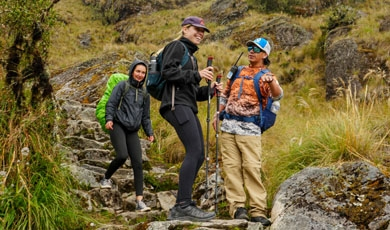 -50% OFF
-50% OFFTrek Along the Inca Trail To Machu Picchu
7 DAYS Cusco, Inca Trail, Machu PicchuTrek Along the Inca Trail Trek to Machu Picchu with Valencia Travel, a renowned Peruvian tour company offering off-the-beaten-path experiences. Click here to learn more about the Inca Trail to Machu Picchu.
$ 899Per person twin shareWAS $1798
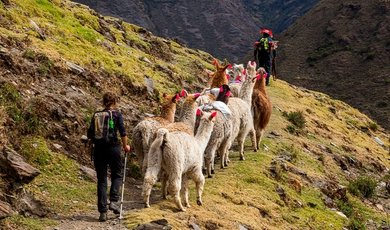 -50% OFF
-50% OFFLares Trek & Machu Picchu
7 DAYS Cusco, Lares, Machu Picchu, Sacred ValleyJoin Valencia Travel on this 7 Day Lares Trek and Machu Picchu combination tour for one of the best Peru cultural treks in Peru. Click here to book your Lares Trek today!
$ 770Per person twin shareWAS $1540
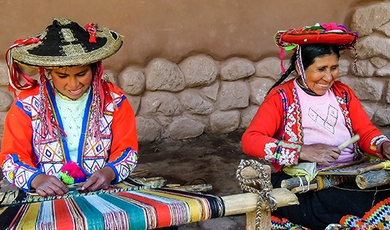 -50% OFF
-50% OFF7 Day - Classic Peru Trip
7 DAYS Cusco, Lima, Machu Picchu, Sacred ValleyValencia Travel's Peru itinerary for 7 Days is a bucket-list adventure. Click here to learn about all the unforgettable experiences you'll encounter!
$ 895Per person twin shareWAS $1790
AWARDS AND RECOGNITION
At Valencia Travel, we are honored to have been recognized for our commitment to exceptional Peru vacation packages. This section celebrates the awards and accolades we've received, a testament to our dedication to excellence in service, innovation, and sustainability within the travel industry. Each award represents our passion for creating unforgettable Peru tour packages and our continuous efforts to exceed the expectations of our travelers. From prestigious industry accolades to customer service excellence awards, these recognitions motivate us to maintain the high standards we've set for ourselves and for your holiday adventures. We invite you to explore our achievements and join us as we continue to strive for excellence, making every tour trip with Valencia Travel an award-winning experience.


Valencia Travel is proud to display our certifications, a testament to our commitment to quality, safety, and sustainability in Peru travel. These recognitions showcase our dedication to the highest standards in each Peru adventure package we offer. Our certifications affirm our promise to provide outstanding sustainable and responsible Peru travel experiences. Discover the standards we uphold and feel secure in choosing Valencia Travel, where excellence is not just a goal, but a certified reality.

